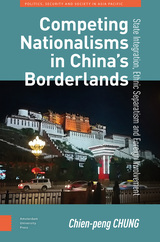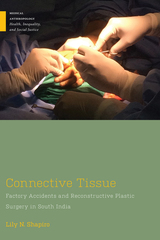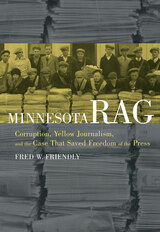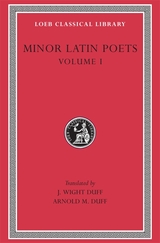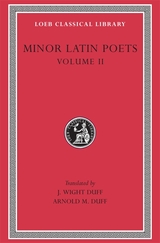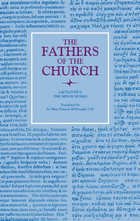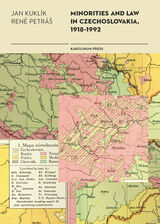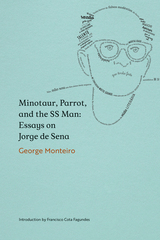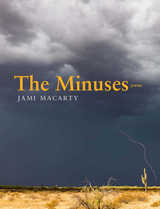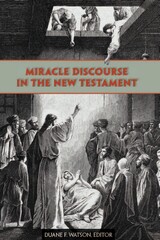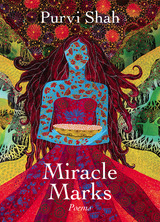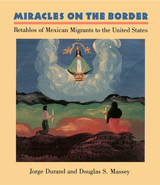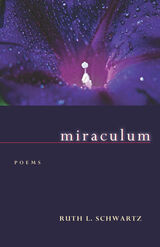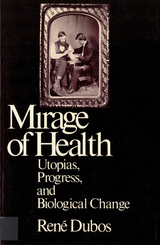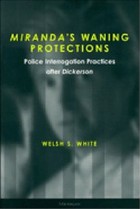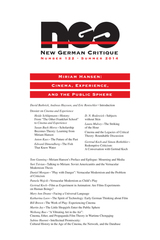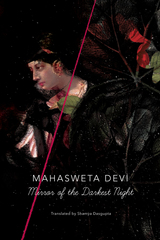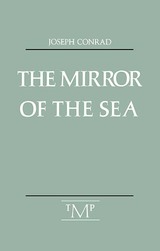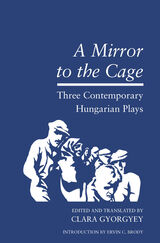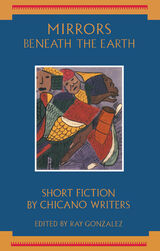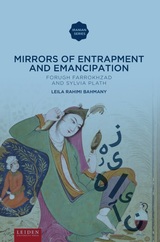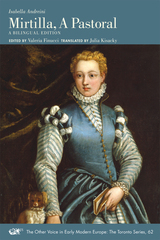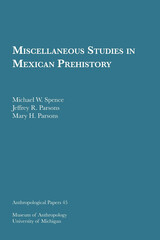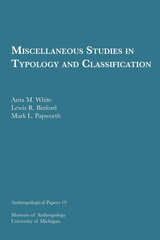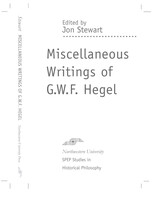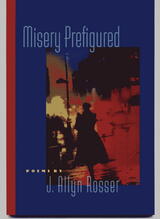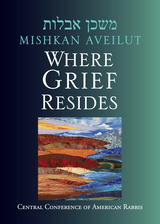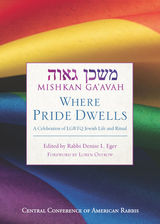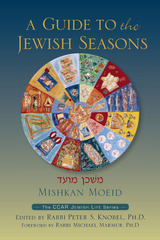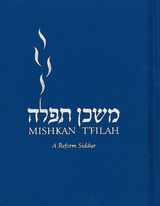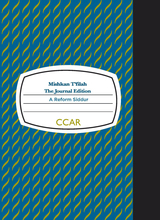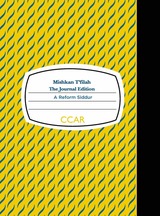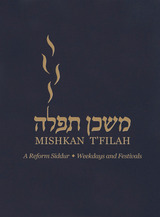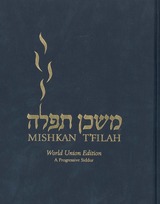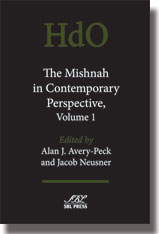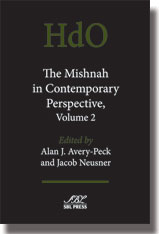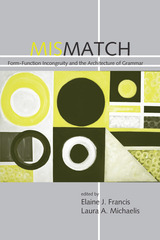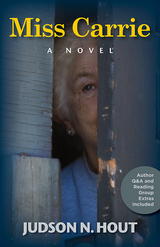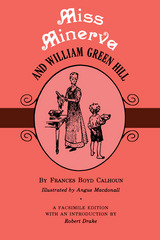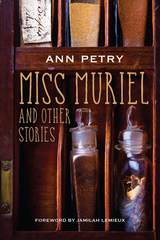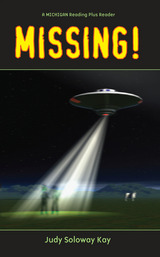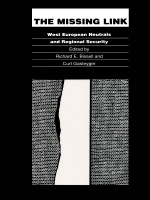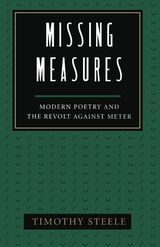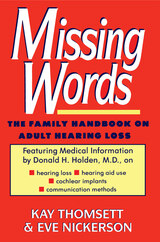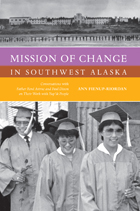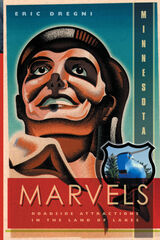 Minnesota Marvels: Roadside Attractions in the Land of Lakes
Eric Dregni
University of Minnesota Press, 2001 Only in Minnesota can you snap a Polaroid of a fifty-five-foot-tall grinning green man with a size seventy-eight shoe or marvel at the spunk of a Swede who dedicated his life to spinning a gigantic ball of twine. The world’s largest hockey stick, as well as the biggest pelican, prairie chicken, turkey, fish, otter, fox, and loon also make Minnesota their home. Where else can you ponder the mysterious "miracle meat" of Spam in a museum dedicated to pork products or have your head examined by the phrenology machines at the Museum of Questionable Medical Devices?
Minnesota Marvels is a tour of the inspired, bizarre, brilliant, scandalous, and funny sites around the state. Look up in wonder at the several Paul Bunyan statues, including the original (Bemidji), the tallest (Akeley), and the largest talking version (Brainerd). Ease on down the road to visit the first home of the heel-tapping native of Grand Rapids, Judy Garland, or walk the "main street" of Sauk Centre immortalized by native son Sinclair Lewis. See the birthplaces of Charles Lindbergh, the Mayo brothers, the Greyhound bus, the snowmobile, and the ice-cream sandwich.
Minnesota is also the home of such attractions as the Minneapolis Sculpture Garden and the world’s largest aerial lift bridge in Duluth, and architectural wonders such as Frank Lloyd Wright’s modernist gas station in Cloquet and Frank Gehry’s arresting Weisman Art Museum. Stunning mansions with histories of ghost sightings, the hangouts and lairs of infamous gangsters, and old-fashioned breweries dot the state.
Conveniently organized by town name and illustrated throughout, Minnesota Marvels is the perfect light-hearted guide for entertaining road trips all over the state.
Minnesota Rag: Corruption, Yellow Journalism, and the Case That Saved Freedom of the Press
Fred W. Friendly
University of Minnesota Press, 2003 The fascinating behind-the-scenes story of this landmark First Amendment case Minnesota Rag takes the reader on an exhilarating tour of the seamy underside of a dark period in Minnesota’s past, one rife with crooked public officials, vengeful gangsters, and yellow journalists. Featuring notorious characters such as Jay M. Near, racist and antilabor publisher of Minneapolis’s Saturday Press, pioneering newsman Fred W. Friendly weaves the tale of a court case that molded our understanding of freedom of the press and set a precedent for the publication of the Pentagon Papers.
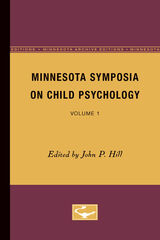 Minnesota Symposia on Child Psychology: Volume 1
John Hill
University of Minnesota Press, 1968
Minnesota Symposia on Child Psychology: Volume 1 was first published in 1968.This volume introduces a series which will make available in book form the papers given at the annual symposia on child psychology sponsored by the Institute of Child Development at the University of Minnesota. Each volume will present the papers from one symposium. For each symposium a number of outstanding child psychologists are invited to present papers dealing with their own programs of research. Each participant is given the opportunity of summarizing and integrating the findings of several studies and discussing the conceptual framework or rationale for the series of studies.This volume, based on the program of the 1966 symposium, includes six papers by nine contributors: Jacob L. Gewirtz, Robert D. Hess, Virginia C. Shipman, E. Mavis Hetherington, O. Ivar Lovaas, Patrick Suppes, Lester Hyman, Max Jerman, and Burton L. White. The papers reflect current research trends in both child psychology and psychology in general, including discussions of the socialization of the child in the culture of poverty (Hess and Shipman); extensions in behavior theory based on the study of children (Gewirtz); the application of behavior theory to clinical intervention (Lovaas); the role of imitation in human learning (Lovaas, Hetherington); the use of computers in instruction and basic research (Suppes, et al.); environmental influences on cognitive processes (White, Hess and Shipman, Suppes, et al.); infant development (White); parental influences in socialization (Hetherington, Hess); and the clarification of stimulus functions (Gewirtz, Lovaas, White).
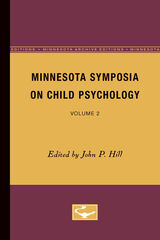 Minnesota Symposia on Child Psychology: Volume 2
John Hill
University of Minnesota Press, 1969
Minnesota Symposia on Child Psychology: Volume 2 was first published in 1969.This is the second volume in the series which is based on papers from the annual Minnesota Symposia on Child Psychology, sponsored by the Institute of Child Development at the University of Minnesota. Volume 2 presents material from five papers given at the 1967 symposium. For each symposium a number of outstanding child psychologists are invited to give papers dealing with their own programs of research. Each participant is provided with the opportunity of summarizing and integrating the findings of several studies and discussing the conceptual framework or rationale for the series of studies.This volume includes five papers ten contributors: “Stable Patterns of Behavior: The Significance of Enduring Orientations for Personality Development” by Wanda C. Bronson; “The Child’s Grammar from I to III” by Roger Brown, Courtney Cazden, and Ursula Bellugi-Klima; “A New APPROACH to Behavioral Ecology” by Bettye M. Caldwell; “Effects of Cognition on Perception: A Problem and a Paradigm for Developmental Study” by Maurice Hershenson; and “Cross-Cultural Longitudinal Research on Child Development: Studies of American and Mexican Schoolchildren” by Wayne H. Holtzman, Rogelio Diaz-Guerrero, Jon D. Swartz, and Luis Lara Tapia.
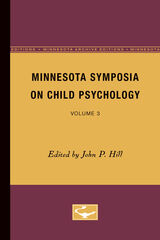 Minnesota Symposia on Child Psychology: Volume 3
John Hill
University of Minnesota Press, 1969
Minnesota Symposia on Child Psychology: Volume 3 was first published in 1969.This is the third volume in the series which is based on papers from the annual Minnesota Symposia on Child Psychology, sponsored by the Institute of Child Development at the University of Minnesota. The material in this volume is based on six papers presented at the 1968 symposium. For each symposium a number of outstanding child psychologists are invited to give papers dealing with their respective programs of research.The contents of this volume are: “Effects of Stimulus Familiarization on Child Behavior” by Gordon N. Cantor, University of Iowa; “Animal Studies of Early Experience: Some Principles Which Have Implication for Human Development” by Victor H. Denenberg, University of Connecticut; “Early Stimulation and Cognitive Development” by Wendell E. Jeffrey, University of California, Los Angeles; “The Development of Stimulus Selection” by Eleanor E. Maccoby, Stanford University; “Adolescent Attitudes and Behavior in Their Reference Groups within Differing Sociocultural Settings” by Muzafer Sherif and Carolyn W. Sherif, both of Pennsylvania State University; “Modeling and Reactive Components of Sibling Interaction” by Brian Sutton-Smith, Teachers College, Columbia University, and B.G. Rosenberg, Bowling Green State University. John P. Hill, the editor, comments on each of the papers in a preface.
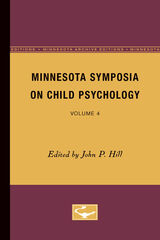 Minnesota Symposia on Child Psychology: Volume 4
John Hill
University of Minnesota Press, 1970
Minnesota Symposia on Child Psychology: Volume 4 was first published in 1970.This is the fourth volume in a series which is based on papers from the annual Minnesota Symposia on Child Psychology, sponsored by the Institute of Child Development at the University of Minnesota. The basis for this book is the material from the 1969 symposium. For each symposium a number of outstanding child psychologists are invited to give papers dealing with their respective programs of research.This volume contains six papers by eight contributors: “The Effects of Early Life Experiences on Developmental Processes and Susceptibility to Disease in Animals” by Robert Ader, University of Rochester Medical Center; “The Antecedents and Adult Correlates of Academic and Intellectual Achievement Effort” by Virginia C. Crandall and Esther S. Battle, Fels Research Institute; “The Role of Peer-Group Experience in Moral Development” by Edward C. Devereux, Jr., Cornell University; “The Development of Motor Skills and Social Relationships among Primates through Play” by Phyllis Jay Dolhinow and Naomi Bishop, University of California, Berkeley; “Systems of Perceptual and Perceptual-Motor Development” by Herbert L. Pick, Jr., University of Minnesota; and “Mental Elaboration and Proficient Learning” by William D. Rohwer, Jr., University of California, Berkeley.
 Minnesota Symposia on Child Psychology: Volume 5
John Hill
University of Minnesota Press, 1971
Minnesota Symposia on Child Psychology: Volume 5 was first published in 1971.This volume, like the previous volumes in this series, is based on the papers given at an annual Minnesota Symposium on Child Psychology sponsored by the Institute of Child Development at the University of Minnesota. The content of this book is based on the papers of the 1970 symposium. For each symposium a number of outstanding child psychologists are invited to present papers dealing with their respective programs of research.Six papers by ten contributors are published here: “The Role of Modalities in Perceptual Cognitive Development” by Jacqueline J. Goodnow, George Washington University; “Hypnosis and Childlikeness” by Ernest R. Hilgard, Stanford University; “Explorations into Patterns of Mental Development and Prediction from the Bayley Scales of Infant Development” by Jane V. Hunt and Nancy Bayley, both of the University of California, Berkeley; “A Dyadic Analysis of ‘Aggressive’ Behaviors” by Gerald R. Patterson and J. A. Cobb, both of the Oregon Research Institute; “Development of Hierarchical, Configurational Conceptual Models for Parent Behavior and Child Behavior” by Earl S. Schaefer, National Institute of Mental Health; and “Some Aspects of the Development of Space Perception” by Seymour Wapner, Leonard Cirillo, and A. Harvey Baker, all of Clark University.
 Minnesota’s Best Breweries and Brewpubs: Searching for the Perfect Pint
Robin Shepard
University of Wisconsin Press, 2011 Based on four years of travel and research, Minnesota’s Best Breweries and Brewpubs is a welcome addition to Robin Shepard’s series of guides to the best of the Midwest’s beer industries. From large-scale breweries such as Cold Spring, to chains like Granite City, to individual brewpubs like Fitger’s Brewhouse, Shepard provides commentary for more than thirty beer makers and three-hundred Minnesota beers. Accessible enough for people at all stages in their journeys to discover great-tasting beer, the information-packed guidebook also features a list of helpful books and websites, as well as information on Minnesota’s beer tastings and festivals.
For each brewery and brewpub site you’ll find:
• a description and brief history, plus many “don’t miss” features
• a description of beers on tap and a list of seasonal and specialty beers
• a space for the brewmaster’s autograph
• notes on the pub food, with recommendations
• suggestions of nearby sights and activities
• general directions to the location
• Shepard’s personal ratings of the experience, plus room to add your own.
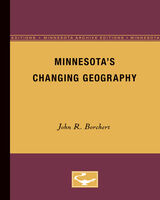 Minnesota’s Changing Geography
John Borchert
University of Minnesota Press, 1959
Minnesota’s Changing Geography was first published in 1959.This book is intended to help children understand how the state of Minnesota developed as it did, what it looks like today, and why. The story, pictures, and maps tell of Minnesota’s changing geography, but the subject embraces a good deal that lies beyond the boundaries of one state. The settlement of the land, its industry and commerce, its climate - these and other parts of the story give young readers perspective to see Minnesota as part of the larger community of the nation and the world. By showing how the land and its use have changed, the book also helps children to realize that their environment is not static, but constantly changing.In each section of the book, the author describes the characteristic features of a major region or settlement of the state. He shows why the dairy region, the corn belt, the timber country, the mining range, and other important economic areas developed in their distinctive ways. He describes the various kinds of settlements to be seen in the state - farm-trade villages, towns, cities, and suburbs. He traces the networks of transportation - rail routes, waterways, truck routes, pipelines, airways, and city traffic. Finally, he explains the elements of local, state, and federal government.A series of tables at the back of the book provides statistics on Minnesota’s population, county by county, on area, temperature, and rainfall, and significant dates in the state’s history.For children in the classroom, in the library, or at home, here is Minnesota in its physical, real-life sense, presented as a part of a large and changing world. Readable, authentic, up-to-date, the book was prepared with the help of consultants from the Minneapolis public schools.
 Minnesota’s Endangered Flora and Fauna
Barbara A. Coffin and Lee Pfannmuller, EditorsIllustrations by Jan A. Janssens, Nan Marie Kane, Kris A. Kohn, Don Luce, James Tidwell, and Vera Ming Wong
University of Minnesota Press, 1988 Minnesota's Endangered Flora and Fauna was first published in 1988. Minnesota Archive Editions uses digital technology to make long-unavailable books once again accessible, and are published unaltered from the original University of Minnesota Press editions. "Extinction of species, the silent crisis of our time, diminishes our world...and a commitment to the preservation of species diversity is fundamental to an optimistic view of the future of our own species," says Harrison B. Tordoff in his forward to this comprehensive reference book. Minnesota's Endangered Flora and Fauna is the result of a legislative mandate -- the 1981 amendment to the State Endangered Species Act -- which called upon the state's Department of Natural Resources and an expert advisory committee to prepare a list of plants and animals in jeopardy. Covered in the book are some 300 species, ranging from mosses and lichens to jumping spiders, and including vascular plants, birds, mammals, reptiles, and amphibians, fish, butterflies, mollusks, and tiger beetles. A chapter is devoted to each of these floral and faunal groups, with individual status accounts provided for all species. Each account includes the designation endangered, threatened,or special concern,the reasons for that choice, and related information on habitat and distribution. Endangered and threatened species are illustrated; state distribution maps are provided for all species, as well as information on national range. In their substantial introduction, the editors describe the historical background of this project; the components of Minnesota's Endangered Species Program -- one of the most comprehensive and respected in the nation; and the state's natural environment -- its diverse landforms and vegetation.
An up-to-date and expanded version of the information contained in Minnesota's Endangered Flora and Fauna is available online through the Minnesota DNR's Rare Species Guide at www.mndnr.gov/rsg.
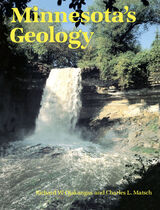 Minnesota’s Geology
Richard Ojakangas
University of Minnesota Press, 1982 The classic book on the state’s unique geology, now back in print! Have you ever wondered how the Mississippi River was formed? Or why shark teeth have been found in the Iron Range of the Upper Midwest? Towering mountain ranges, explosive volcanoes, expansive glaciers, and long-extinct forms of both land and sea life were important parts of Minnesota’s ancient history. Today the evidence of this remarkable heritage is revealed in the state’s rocky outcroppings, stony soils, and thousands of lakes. Minnesota’s Geology provides a history of the past 3.5 billion years in the area’s development. In accessible language, Minnesota-based geologists Richard W. Ojakangas and Charles L. Matsch tell the story of the state’s past and offer a guide for those who want to read geological history firsthand from the rocks and landscapes of today. The book’s four sections give a short introduction to geology and Minnesota’s place in geologic history; a historic timeline; a look at the metallic minerals, nonmetals, and water present today; and a geologic picture of today’s Minnesota arranged in five geographical regions. This book is both a wonderful source of information for rock hounds and the perfect backpacking companion for tourists and outdoor enthusiasts. Lavishly illustrated with color and black-and-white photographs, as well as extensive graphs and maps, Minnesota’s Geology will inform and delight for years to come."This is certainly one of the finest books about the geology of any state in the United States. It is written at a level that should satisfy the visitor, the student, and even most professionals." American Scientist"A stunning guide . . . Minnesota’s Geology will be as valuable to the rock hound or student as it is to a trained geologist." Duluth News-Tribune"Minnesota’s Geology sets a standard of excellence for books about the geology of a region. . . . an unusually well-written and well-balanced book." Science Books and FilmsRichard W. Ojakangas and Charles L. Matsch are professors in the Department of Geological Sciences at the University of Minnesota, Duluth.
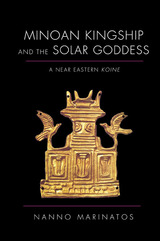 Minoan Kingship and the Solar Goddess: A Near Eastern Koine
Nanno Marinatos
University of Illinois Press, 2010 Ancient Minoan culture has been typically viewed as an ancestor of classical Greek civilization, but this book shows that Minoan Crete was on the periphery of a powerfully dynamic cultural interchange with its neighbors. Rather than viewing Crete as the autochthonous ancestor of Greece's glory, Nanno Marinatos considers ancient Crete in the context of its powerful competitors to the east and south. Analyzing the symbols of the Minoan theocratic system and their similarities to those of Syria, Anatolia, and Egypt, Marinatos unlocks many Minoan visual riddles and establishes what she calls a "cultural koine," or standard set of cultural assumptions, that circulated throughout the Near East and the eastern Mediterranean at the time Minoan civilization reached its peak. With more than one hundred and fifty illustrations, Minoan Kingship and the Solar Goddess delivers a comprehensive reading of Minoan art as a system of thought.
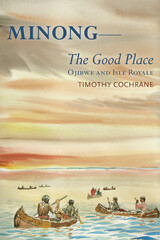 Minong: The Good Place Ojibwe and Isle Royale
Timothy Cochrane
Michigan State University Press, 2009 Minong (the Ojibwe name for Isle Royale) is the search for the history of the Ojibwe people's relationship with this unique island in the midst of Lake Superior. Cochrane uses a variety of sources: Ojibwe oral narratives, recently rediscovered Jesuit records and diaries, reports of the Hudson's Bay post at Fort William, newspaper accounts, and numerous records from archives in the United States and Canada, to understand this relationship to a place. What emerges is a richly detailed account of Ojibwe activities on Minong—and their slow waning in the latter third of the nineteenth century.
Piece by piece, Cochrane has assembled a narrative of a people, an island, and a way of life that transcends borders, governments, documentation, and tidy categories. His account reveals an authentic 'history': the missing details, contradictions, deviations from the conventions of historical narrative—the living entity at the intersection of documentation by those long dead and the narratives of those still living in the area. Significantly, it also documents how non-natives symbolically and legally appropriated Isle Royale by presenting it to fellow non-natives as an island that was uninhabited and unused.
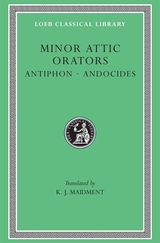 Minor Attic Orators, Volume I: Antiphon. Andocides
Translated by K. J. Maidment
Harvard University Press Two ill-fated rhetoricians.
Antiphon of Athens, born in 480 BC, spent his prime in the great period of Athens but, disliking democracy, was himself an ardent oligarch who with others set up a violent short-lived oligarchy in 411. The restored democracy executed him for treason. He had been a writer of speeches for other people involved in litigation. Of the fifteen surviving works three concern real murder cases. The others are exercises in speechcraft consisting of three tetralogies, each tetralogy comprising four skeleton speeches: accuser’s; defendant’s; accuser’s reply; defendant’s counter-reply.
Andocides of Athens, born ca. 440 BC, disliked the extremes of both democracy and oligarchy. Involved in religious scandal in 415 BC, he went into exile. After at least two efforts to return, he did so under the amnesty of 403. In 399 he was acquitted on a charge of profaning the Mysteries and in 391–390 took part in an abortive peace embassy to Sparta. Extant speeches are: On His Return (a plea on his second attempt); On the Mysteries (a self-defense); On the Peace with Sparta. The speech Against Alcibiades (the notorious politician) is suspect.
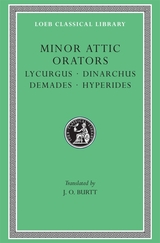 Minor Attic Orators, Volume II: Lycurgus. Dinarchus. Demades. Hyperides
Translated by J. O. Burtt
Harvard University Press Four rhetoricians confronting Macedonian dominance.
This volume collects the speeches of four orators involved in the ill-fated resistance of Athens to the power of Philip and Alexander the Great of Macedon.
Lycurgus of Athens (ca. 396–325 BC) concentrated on domestic affairs, especially financial, which he managed for twelve years, and naval matters. He also constructed and repaired important public buildings. Athens refused to surrender him to Alexander and honored him until his death.
Dinarchus of Corinth (ca. 361–291) as resident alien in Athens became a forensic speaker and also assailed Demosthenes and others. He was accused by Alexander’s runaway treasurer Harpalus of corruption. Dinarchus favored oligarchic government under Macedonian control. He prospered under the regency of Demetrius of Phalerum (317–307), but was exiled after the restoration of democracy, returning circa 292.
Demades of Athens (ca. 380–318) was an able seaman, then unscrupulous politician. He favored Philip, but fought for Athens at Chaeronea (338). Captured there and released by Philip, he helped to make peace, and later influenced Alexander and then Antipater in Athens’ favor. But acceptance of bribes and his tortuous policy ruined him, and he was executed by Antipater.
Hyperides of Athens (ca. 390–322) was a forensic and political speaker who was hostile to Philip and led Athens’ patriots after 325. For resistance to Antipater he ultimately met death by violence. What survives today of his speeches was discovered in the nineteenth century.
 Minor China: Method, Materialisms, and the Aesthetic
Hentyle Yapp
Duke University Press, 2021 In Minor China Hentyle Yapp analyzes contemporary Chinese art as it circulates on the global art market to outline the limitations of Western understandings of non-Western art. Yapp reconsiders the all-too-common narratives about Chinese art that celebrate the heroic artist who embodies political resistance against the authoritarian state. These narratives, as Yapp establishes, prevent Chinese art, aesthetics, and politics from being discussed in the West outside the terms of Western liberalism and notions of the “universal.” Yapp engages with art ranging from photography and performance to curation and installations to foreground what he calls the minor as method—tracking aesthetic and intellectual practices that challenge the predetermined ideas and political concerns that uphold dominant conceptions of history, the state, and the subject. By examining the minor in the work of artists such as Ai Weiwei, Zhang Huan, Cao Fei, Cai Guo-Qiang, Carol Yinghua Lu, and others, Yapp demonstrates that the minor allows for discussing non-Western art more broadly and for reconfiguring dominant political and aesthetic institutions and structures.
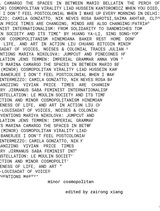 minor cosmopolitan: Thinking art, politics, and the universe together otherwise
Edited by Zairong Xiang
Diaphanes, 2020 In the wake of rapid globalization, many enthusiastically declared cosmopolitanism to be no longer just a philosophical ideal, but a real, existing fact. Across the world, they argued, people were increasingly considering themselves global citizens. Meanwhile, the global ecological crisis worsened, fascism returned, repression of disenfranchised groups on a global scale persisted, and the “refugee crisis” inundated the mediascape. What happened to the cosmopolitan promise, and who betrayed it? minor cosmopolitan challenges the underlying premises of major cosmopolitanism without letting go of the unfulfilled emancipatory potential of the concept at large. It rethinks cosmopolitanisms in the plural, and it traces multiple origins and trajectories of cosmopolitan thought across the globe. Assembling theoretical, artistic, and essayistic contributions in textual or visual formats, minor cosmopolitan seeks to discuss how to live at once with our difference and shared struggle and asks who sustains the world’s flourishing.
 Minor Creatures: Persons, Animals, and the Victorian Novel
Ivan Kreilkamp
University of Chicago Press, 2018 In the nineteenth century, richly-drawn social fiction became one of England’s major cultural exports. At the same time, a surprising companion came to stand alongside the novel as a key embodiment of British identity: the domesticated pet. In works by authors from the Brontës to Eliot, from Dickens to Hardy, animals appeared as markers of domestic coziness and familial kindness. Yet for all their supposed significance, the animals in nineteenth-century fiction were never granted the same fullness of character or consciousness as their human masters: they remain secondary figures. Minor Creatures re-examines a slew of literary classics to show how Victorian notions of domesticity, sympathy, and individuality were shaped in response to the burgeoning pet class. The presence of beloved animals in the home led to a number of welfare-minded political movements, inspired in part by the Darwinian thought that began to sprout at the time. Nineteenth-century animals may not have been the heroes of their own lives but, as Kreilkamp shows, the history of domestic pets deeply influenced the history of the English novel.
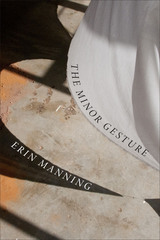 The Minor Gesture
Erin Manning
Duke University Press, 2016 In this wide-ranging and probing book Erin Manning extends her previous inquiries into the politics of movement to the concept of the minor gesture. The minor gesture, although it may pass almost unperceived, transforms the field of relations. More than a chance variation, less than a volition, it requires rethinking common assumptions about human agency and political action. To embrace the minor gesture's power to fashion relations, its capacity to open new modes of experience and manners of expression, is to challenge the ways in which the neurotypical image of the human devalues alternative ways of being moved by and moving through the world—in particular what Manning terms "autistic perception." Drawing on Deleuze and Guattari's schizoanalysis and Whitehead's speculative pragmatism, Manning's far-reaching analyses range from fashion to depression to the writings of autistics, in each case affirming the neurodiversity of the minor and the alternative politics it gestures toward.
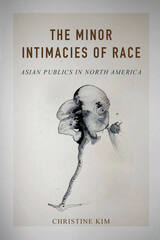 The Minor Intimacies of Race: Asian Publics in North America
Christine Kim
University of Illinois Press, 2016 An attempt to put an Asian woman on Canada's $100 bill in 2012 unleashed enormous controversy. The racism and xenophobia that answered this symbolic move toward inclusiveness revealed the nation's trumpeted commitment to multiculturalism as a lie. It also showed how multiple minor publics as well as the dominant public responded to the ongoing issue of race in Canada. In this new study, Christine Kim delves into the ways cultural conversations minimize race's relevance even as violent expressions and structural forms of racism continue to occur. Kim turns to literary texts, artistic works, and media debates to highlight the struggles of minor publics with social intimacy. Her insightful engagement with everyday conversations as well as artistic expressions that invoke the figure of the Asian allows Kim to reveal the affective dimensions of racialized publics. It also extends ongoing critical conversations within Asian Canadian and Asian American studies about Orientalism, diasporic memory, racialized citizenship, and migration and human rights.
Minor Latin Poets, Volume I: Publilius Syrus. Elegies on Maecenas. Grattius. Calpurnius Siculus. Laus Pisonis. Einsiedeln Eclogues. Aetna
Aetna, Calpurnius Siculus, Publilius Syrus, Laus Pisonis, and Grattius
Harvard University Press A miscellany of mostly imperial verse.
This two-volume anthology covers a period of four and a half centuries, beginning with the work of the mime-writer Publilius Syrus who flourished ca. 45 BC and ending with the graphic and charming poem of Rutilius Namatianus recording a sea voyage from Rome to Gaul in AD 416. A wide variety of theme gives interest to the poems: hunting in a poem of Grattius; an inquiry into the causes of volcanic activity by the author of Aetna; pastoral poems by Calpurnius Siculus and by Nemesianus; fables by Avianus; a collection of Dicta, moral sayings, as if by the elder Cato; eulogy in Laus Pisonis; and the legend of the Phoenix, a poem of the fourth century. Other poets complete the work.
Minor Latin Poets, Volume II: Florus. Hadrian. Nemesianus. Reposianus. Tiberianus. Dicta Catonis. Phoenix. Avianus. Rutilius Namatianus. Others
Avianus ,Hadrian, Florus, Nemesianus, Reposianus, Tiberianus, Phoenix, Rutilius Namatianus, et al.
Harvard University Press A miscellany of mostly imperial verse.
This two-volume anthology covers a period of four and a half centuries, beginning with the work of the mime-writer Publilius Syrus who flourished ca. 45 BC and ending with the graphic and charming poem of Rutilius Namatianus recording a sea voyage from Rome to Gaul in AD 416. A wide variety of theme gives interest to the poems: hunting in a poem of Grattius; an inquiry into the causes of volcanic activity by the author of Aetna; pastoral poems by Calpurnius Siculus and by Nemesianus; fables by Avianus; a collection of Dicta, moral sayings, as if by the elder Cato; eulogy in Laus Pisonis; and the legend of the Phoenix, a poem of the fourth century. Other poets complete the work.
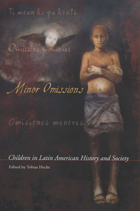 Minor Omissions: Children in Latin American History and Society
Edited by Tobias Hecht
University of Wisconsin Press, 2002 Latin American history—the stuff of wars, elections, conquests, inventions, colonization, and all those other events and processes attributed to adults—has also been lived and partially forged by children. Taking a fresh look at Latin American and Caribbean society over the course of more than half a millennium, this book explores how the omission of children from the region's historiography may in fact be no small matter.
Children currently make up one-third of the population of Latin America and the Caribbean, and over the centuries they have worked, played, worshipped, committed crimes, and fought and suffered in wars. Regarded as more promising converts to the Christian faith than adults, children were vital in European efforts to invent loyal subjects during the colonial era. In the contemporary economies of Latin America and the Caribbean—where 23 percent of people live on a dollar per day or less—the labor of children may spell the difference between survival and starvation for millions of households.
Minor Omissions brings together scholars of history, anthropology, religion, and art history as well as a talented young author who has lived in the streets of a Brazilian city since the age of nine. The book closes with the prophetic dystopian tale "The Children's Rebellion" by the noted Uruguayan writer Cristina Peri Rossi.
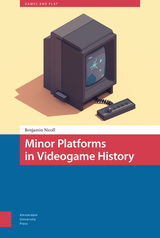 Minor Platforms in Videogame History
Benjamin Nicoll
Amsterdam University Press, 2019 Videogame history is not just a history of one successful technology replacing the next. It is also a history of platforms and communities that never quite made it; that struggled to make their voices heard; that aggravated against the conventions of the day; and that never enjoyed the commercial success or recognition of their major counterparts. In Minor Platforms in Videogame History, Benjamin Nicoll argues that 'minor' videogame histories are anything but insignificant. Through an analysis of transitional, decolonial, imaginary, residual, and minor videogame platforms, Nicoll highlights moments of difference and discontinuity in videogame history. From the domestication of vector graphics in the early years of videogame consoles to the 'cloning' of Japanese computer games in South Korea in the 1980s, this book explores case studies that challenge taken-for-granted approaches to videogames, platforms, and their histories.
 Minor Prophecies: The Literary Essay in the Culture Wars
Geoffrey H. Hartman
Harvard University Press, 1991 For most people literary criticism is a mystery that often seems inaccessible, written for an in-group. Even worse, a Battle of the Books has broken out between neoconservatives and neoradicals—all the more reason to steer clear of the fray. Geoffrey Hartman argues that ignoring the culture wars would be unwise, for what is at stake is the nature of the arts we prize and our obligation to remain civil and avoid the apocalyptic tone of most political prophecy.
Hartman’s book is both a survey of the history of modern literary criticism and a strategic intervention. First he presents an account of the culture of criticism in the last one hundred years. He then widens the focus to provide a picture of the critical essay from 1700 to the present in order to show that a major change in style took place after 1950. Two chapters focus on F. R. Leavis and Paul de Man, central—and controversial—figures in academic criticism. Hartman attends to major developments on the continent and in Anglo-American circles that have disrupted the calm of what he calls the friendship or conversational style. On the one hand, critics and thinkers have pursued strange gods in order to enrich and sharpen their critical style. This change Hartman welcomes. On the other hand, along with a renewed interest in politics and historical speculation, a didactic and moralistic tone has again entered the scene. Hartman rejects this new moralism.
The author is an eloquent defender of reading the text of criticism as carefully as the text of literature. He argues for a broader conception of critical style, one that would support the open and conversational voice of the public critic as well as the inventive and innovative practice of the technical critic. Hartman sets before us an ideal of literary criticism that can acknowledge theory yet does not shrink from a sustained, text-centered response. Minor Prophecies is a major book by one of our finest critics.
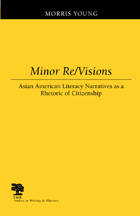 Minor Re/Visions: Asian American Literacy Narratives as a Rhetoric of Citizenship
Morris Young
Southern Illinois University Press, 2004 Through a blend of personal narrative, cultural and literary analysis, and discussions about teaching, Minor Re/Visions: Asian American Literacy Narratives as a Rhetoric of Citizenship shows how people of color use reading and writing to develop and articulate notions of citizenship. Morris Young begins with a narration of his own literacy experiences to illustrate the complicated relationship among literacy, race, and citizenship and to reveal the tensions that exist between competing beliefs and uses of literacy among those who are part of dominant American culture and those who are positioned as minorities. Influenced by the literacy narratives of other writers of color, Young theorizes an Asian American rhetoric by examining the rhetorical construction of American citizenship in works such as Richard Rodriguez’s Hunger of Memory, Victor Villanueva’s Bootstraps: From an American Academic of Color, Carlos Bulosan’s America Is in the Heart, and Maxine Hong Kingston’s “Song for a Barbarian Reed Pipe” from Woman Warrior. These narratives, Young shows, tell stories of transformation through education, the acquisition of literacy, and cultural assimilation and resistance. They also offer an important revision to the American story by inserting the minor and creating a tension amid dominant discourses about literacy, race, and citizenship. Through a consideration of the literacy narratives of Hawai`i, Young also provides a context for reading literacy narratives as responses to racism, linguistic discrimination, and attempts at “othering” in a particular region. As we are faced with dominant discourses that construct race and citizenship in problematic ways and as official institutions become even more powerful and prevalent in silencing minor voices, Minor Re/Visions reveals the critical need for revising minority and dominant discourses. Young’s observations and conclusions have important implications for the ways rhetoricians and compositionists read, teach, and assign literacy narratives.
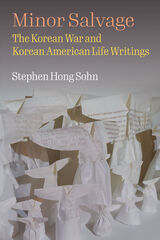 Minor Salvage: The Korean War and Korean American Life Writings
Stephen Hong Sohn
University of Michigan Press, 2022 The Korean War, often invoked in American culture as “the forgotten war,” remains ongoing. Though active fighting only occurred between 1950 and 1953, the signing of an armistice resulted in an infamous stalemate and the construction of the Korean Peninsula’s Demilitarized Zone. Minor Salvage reads early Korean American life writings in order to explore the admittedly partial ways in which those made precarious by war seek to rebuild their lives. The titular phrase “minor salvage,” draws on different valences of the word salvage which, while initially associated with naval recovery efforts, can also be used to describe the rescue of waste material. Spurred by the stories told and retold to him by his parents Soon Ho and Yunpyo, Sohn enacts minor salvage by reading overlooked early Korean American life writings penned by Induk Pahk, Taiwon Koh, Joseph Anthony, and Kim Yong-ik alongside a later generation of life writings authored by Sunny Che and K. Connie Kang. In the context of the Korean War, Sohn argues, life writings take on a crucial political orientation precisely because of the fragility attached to refugees, civilians, children, women, and divided family members. To depict the possibility of life is to acknowledge simultaneously the threat of death, violence, and brutality, and in this regard, such life writings are part of a longer genealogy in which marginalized communities find representational power through the creative process.
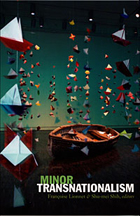 Minor Transnationalism
Françoise Lionnet and Shu-mei Shih, eds.
Duke University Press, 2005 Minor Transnationalism moves beyond a binary model of minority cultural formations that often dominates contemporary cultural and postcolonial studies. Where that model presupposes that minorities necessarily and continuously engage with and against majority cultures in a vertical relationship of assimilation and opposition, this volume brings together case studies that reveal a much more varied terrain of minority interactions with both majority cultures and other minorities. The contributors recognize the persistence of colonial power relations and the power of global capital, attend to the inherent complexity of minor expressive cultures, and engage with multiple linguistic formations as they bring postcolonial minor cultural formations across national boundaries into productive comparison. Based in a broad range of fields—including literature, history, African studies, Asian American studies, Asian studies, French and francophone studies, and Latin American studies—the contributors complicate ideas of minority cultural formations and challenge the notion that transnationalism is necessarily a homogenizing force. They cover topics as diverse as competing versions of Chinese womanhood; American rockabilly music in Japan; the trope of mestizaje in Chicano art and culture; dub poetry radio broadcasts in Jamaica; creole theater in Mauritius; and race relations in Salvador, Brazil. Together, they point toward a new theoretical vocabulary, one capacious enough to capture the almost infinitely complex experiences of minority groups and positions in a transnational world. Contributors. Moradewun Adejunmobi, Ali Behdad, Michael Bourdaghs, Suzanne Gearhart, Susan Koshy, Françoise Lionnet, Seiji M. Lippit, Elizabeth Marchant, Kathleen McHugh, David Palumbo-Liu, Rafael Pérez-Torres, Jenny Sharpe, Shu-mei Shih , Tyler Stovall
 Minor Troubles: Racial Figurations of Youth Sexuality and Childhood's Queerness
Erin J. Rand
Ohio State University Press, 2025 In Minor Troubles, Erin J. Rand investigates a series of controversies about youth sexuality and queerness from the early twenty-first century: adult concerns about teen sexting, the bullying and suicides of queer kids, trans youths’ access to gender-segregated bathrooms at school, and sex education. In the public deliberation and mediation of each of these controversies, the imagined qualities of childhood—innocence, vulnerability, nonsexuality, and, crucially, whiteness—are deployed by adults to justify the protection of children. However, these rhetorical figurations of childhood often produce material precarities for actual young people, especially youth of color and queer, trans, and gender-nonconforming youth.
Rand foregrounds the fundamental role of racialization in forming ideas about childhood, arguing that the image of innocent white childhood depends upon the dehumanization of racialized youth. Moreover, the rhetorical process of figuration produces vulnerability and constrains agency for real young people and creates cultural ideas about childhood that come to justify policies, discipline behaviors, regulate identities, control knowledges, and determine interventions that shape children’s lives, bodies, and experiences.
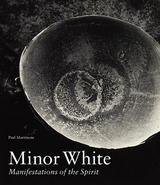 Minor White: Manifestations of the Spirit
Paul Martineau
J. Paul Getty Trust, The, 2014 A beautifully illustrated tribute to one of the most influential photographers of the twentieth century.
Controversial, misunderstood, and sometimes overlooked, Minor White (1908–1976) is one of the great photographers of the twentieth century, whose ideas exerted a powerful influence on a generation of photographers and still resonate today. His photographic career began in 1938 in Portland, Oregon, with assignments for the WPA (Works Progress Administration). After serving in World War II and studying art history at Columbia University, White’s focus shifted toward the metaphorical. He began creating images charged with symbolism and a critical aspect called equivalency, referring to the invisible spiritual energy present in a photograph made visible to the viewer.
This book brings together White’s key biographical information—his evolution as a photographer, teacher of photography, and editor of Aperture, as well as particularly insightful quotations from his journals, which he kept for more than forty years. The result is an engaging narrative that weaves through the main threads of White’s life, his growth as an artist, as well as his spiritual search and ongoing struggle with his own sexuality and self-doubt. He sought comfort in a variety of religious practices that influenced his continually metamorphosing artistic philosophy.
The Minor Works
Lactantius
Catholic University of America Press, 1965 The writings of this author are, together with those of Eusebius, the principal sources for the period of the great persecution of Diocletian and for the first years of the peace of the Church after the Edict of Milan.
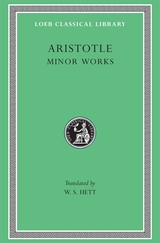 Minor Works: On Colours. On Things Heard. Physiognomics. On Plants. On Marvellous Things Heard. Mechanical Problems. On Indivisible Lines. The Situations and Names of Winds. On Melissus, Xenophanes, Gorgias
Aristotle
Harvard University Press Short treatises attributed to a great mind.
Aristotle, great Greek philosopher, researcher, reasoner, and writer, born at Stagirus in 384 BC, was the son of a physician. He studied under Plato at Athens and taught there (367–347); subsequently he spent three years at the court of a former pupil in Asia Minor. After some time at Mitylene, in 343–342 he was appointed by King Philip of Macedon to be tutor of his teen-aged son Alexander. After Philip’s death in 336, Aristotle became head of his own school (of “Peripatetics”), the Lyceum at Athens. Because of anti-Macedonian feeling there after Alexander’s death in 323, he withdrew to Chalcis in Euboea, where he died in 322.
Nearly all the works Aristotle prepared for publication are lost; the priceless ones extant are lecture-materials, notes, and memoranda (some are spurious). They can be categorized as follows:
I Practical: Nicomachean Ethics; Great Ethics (Magna Moralia); Eudemian Ethics; Politics; Economics (on the good of the family); On Virtues and Vices.
II Logical: Categories; Analytics (Prior and Posterior); Interpretation; Refutations used by Sophists; Topica.
III Physical: Twenty-six works (some suspect) including astronomy, generation and destruction, the senses, memory, sleep, dreams, life, facts about animals, etc.
IV Metaphysics: on being as being.
V Art: Rhetoric and Poetics.
VI Other works including the Constitution of Athens; more works also of doubtful authorship.
VII Fragments of various works such as dialogues on philosophy and literature; and of treatises on rhetoric, politics, and metaphysics.
The Loeb Classical Library edition of Aristotle is in twenty-three volumes.
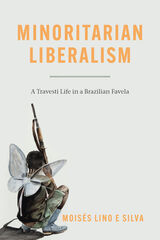 Minoritarian Liberalism: A Travesti Life in a Brazilian Favela
Moisés Lino e Silva
University of Chicago Press, 2022 A mesmerizing ethnography of the largest favela in Rio, where residents articulate their own politics of freedom against the backdrop of multiple forms of oppression.
Normative liberalism has promoted the freedom of privileged subjects, those entitled to rights—usually white, adult, heteronormative, and bourgeois—at the expense of marginalized groups, such as Black people, children, LGBTQ people, and slum dwellers. In this visceral ethnography of Rocinha, the largest favela in Rio de Janeiro, Brazil, Moisés Lino e Silva explores what happens when liberalism is challenged by people whose lives are impaired by normative understandings of liberty. He calls such marginalized visions of freedom “minoritarian liberalism,” a concept that stands in for overlapping, alternative modes of freedom—be they queer, favela, or peasant.
Lino e Silva introduces readers to a broad collective of favela residents, most intimately accompanying Natasha Kellem, a charismatic self-declared travesti (a term used in Latin America to indicate a specific form of female gender construction opposite to the sex assigned at birth). While many of those the author meets consider themselves “queer,” others are treated as “abnormal” simply because they live in favelas. Through these interconnected experiences, Lino e Silva not only pushes at the boundaries of anthropological inquiry, but also offers ethnographic evidence of non-normative routes to freedom for those seeking liberties against the backdrop of capitalist exploitation, transphobia, racism, and other patterns of domination.
Minorities and Law in Czechoslovakia
Jan Kuklík and René Petráš
Karolinum Press, 2017 Across the whole of modern Czech history—from 1918, through World War II, and into the postwar years—ethnic and minority issues have been of the utmost prominence. Moreover, Czechoslovakia has in the past been held up as a model for solving problems related to ethnic and minority tensions through legal regulations—regulations that played a key role in delineating minority status. Primarily intended for an international, non-Czech audience, this book takes a long-term perspective on issues related to ethnic and language minorities in Czechoslovakia. Bridging legal and historical disciplines, Jan Kuklík and René Petráš show that as ethnic minority issues once again come to the forefront of policy debates in Europe and beyond, a detailed knowledge of earlier Czech difficulties and solutions may help us to understand and remedy contemporary problems.
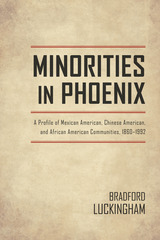 Minorities in Phoenix: A Profile of Mexican American, Chinese American, and African American Communities, 1860-1992
Bradford Luckingham
University of Arizona Press, 1994 Phoenix is the largest city in the Southwest and one of the largest urban centers in the country, yet less has been published about its minority populations than those of other major metropolitan areas. Bradford Luckingham has now written a straightforward narrative history of Mexican Americans, Chinese Americans, and African Americans in Phoenix from the 1860s to the present, tracing their struggles against segregation and discrimination and emphasizing the active roles they have played in shaping their own destinies.
Settled in the mid-nineteenth century by Anglo and Mexican pioneers, Phoenix emerged as an Anglo-dominated society that presented formidable obstacles to minorities seeking access to jobs, education, housing, and public services. It was not until World War II and the subsequent economic boom and civil rights era that opportunities began to open up. Drawing on a variety of sources, from newspaper files to statistical data to oral accounts, Luckingham profiles the general history of each community, revealing the problems it has faced and the progress it has made. His overview of the public life of these three ethnic groups shows not only how they survived, but how they contributed to the evolution of one of America's fastest-growing cities.
 Minority Memory, Identity, and Reconciliation: The Turkish Muslim Minority of Greece and the Greek Orthodox Minority of Türkiye
Gül M. Gür
University of Michigan Press, 2025 Migration and minority rights are increasingly at the forefront of global discourse. Minority Memory, Identity, and Reconciliation explores the lives of two often overlooked minority communities: the Greek Orthodox minority in Istanbul, Türkiye, and the Turkish Muslim minority in Western Thrace, Greece. As empires dissolved, the leaders and political elites of new, smaller nations that emerged embarked on population exchanges to increase the ethnic and religious homogeneity of their nation-states. Although these two minority communities differ in religious, ethnic, and socioeconomic terms, they both offer unique perspectives on what happens to people who live on what is perceived as the wrong side of an arbitrarily drawn border.
Drawing from the personal stories of members of these two minority communities regarding their struggle with displacement, discrimination, and cultural assimilation, as well as comprehensive historical analysis, this book examines how historical traumas, national policies, and sociopolitical dynamics have influenced contemporary minority memory and identity formation. By incorporating interviews with community leaders, civil society representatives, and state officials, this book offers a rich, multifaceted perspective on the processes of memory and identity formation that underscores the broader implications of these processes for international relations in the region and minority rights. Gül M. Gür pulls together theories of nationalism, collective memory, and narrative practice to highlight the unique process of minority memory work and its role in sustaining minority identity and their advocacy efforts.
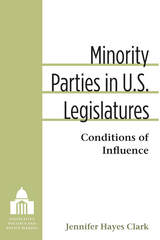 Minority Parties in U.S. Legislatures: Conditions of Influence
Jennifer Hayes Clark
University of Michigan Press, 2015 This study of the influence minority parties wield is both a major work of political science scholarship and a timely examination of an issue with real consequences for the functioning of democratic legislatures and the creation of legislation.
Challenging conventional assumptions that the majority party dominates the legislature, Jennifer Hayes Clark investigates precisely the ways in which—and under what conditions—members of the minority party successfully pursue their interests. For this study, Clark collects fine-grained data from both the U.S. Congress and state legislatures to get a close look at three key points in the legislative process: committee assignments, bill cosponsorship, and roll-call votes. She finds that minority party members are not systematically excluded throughout the policymaking process. Indeed, their capacity to shape legislative decision-making is enhanced when party polarization is low, when institutional prerogatives are broadly dispersed rather than centralized, and when staff resources are limited. Under these conditions, bipartisanship bill cosponsorship and voting coalitions are also more prevalent.
With the sharp increase of partisan polarization in state legislatures and in Congress, it is essential to understand how and when a minority party can effectively represent constituents.
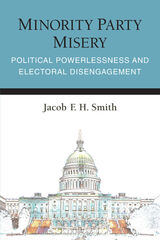 Minority Party Misery: Political Powerlessness and Electoral Disengagement
Jacob F. H. Smith
University of Michigan Press, 2021 This book examines the role of minority party status on politicians’ engagement in electoral politics. Jacob Smith argues that politicians are more likely to be engaged in electoral politics when they expect their party to be in the majority in Congress after the next election and less likely when they anticipate their party will be in the minority. This effect is particularly likely to hold true in recent decades where parties disagree on a substantial number of issues. Politicians whose party will be in the majority have a clear incentive to engage in electoral politics because their preferred policies have a credible chance of passing if they are in the majority. In contrast, it is generally difficult for minority party lawmakers to get a hearing on—much less advance—their preferred policies, particularly when institutional rules inside Congress favor the majority party. Instead, minority party lawmakers spend most of their time fighting losing battles against policy proposals from the majority party. Minority Party Misery examines the consequences of the powerlessness that politicians feel from continually losing battles to the majority party in Congress. Its findings have important consequences for democratic governance, as highly qualified minority party politicians may choose to leave office due to their dismal circumstances rather than continue to serve until their party eventually reenters the majority.
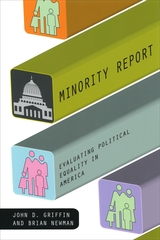 Minority Report: Evaluating Political Equality in America
John D. Griffin and Brian Newman
University of Chicago Press, 2008 Are the views of Latinos and African Americans underrepresented in our federal government? For that matter, what does it mean to be represented equitably? Rather than taking for granted a single answer to these complex questions, John Griffin and Brian Newman use different measures of political equality to reveal which groups get what they want from government and what factors lead to their successes. One of the first books to compare the representation of both African Americans and Latinos to that of whites, Minority Report shows that congressional decisions and federal policy tend to mirror the preferences of whites as a group and as individuals better than the preferences of either minority group, even after accounting for income disparities. This is far from the whole story, though, and the authors’ multifaceted approach illustrates the surprising degree to which group population size, an issue’s level of importance, the race or ethnicity of an office holder, and electoral turnout can affect how well government action reflects the views of each person or group. Sure to be controversial, Minority Report ultimately goes beyond statistical analyses to address the root question of what equal representation really means.
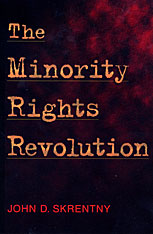 The Minority Rights Revolution
John D. Skrentny
Harvard University Press, 2002 In the wake of the black civil rights movement, other disadvantaged groups of Americans began to make headway—Latinos, women, Asian Americans, and the disabled found themselves the beneficiaries of new laws and policies—and by the early 1970s a minority rights revolution was well underway. In the first book to take a broad perspective on this wide-ranging and far-reaching phenomenon, John D. Skrentny exposes the connections between the diverse actions and circumstances that contributed to this revolution—and that forever changed the face of American politics.
Though protest and lobbying played a role in bringing about new laws and regulations—touching everything from wheelchair access to women’s athletics to bilingual education—what Skrentny describes was not primarily a bottom-up story of radical confrontation. Rather, elites often led the way, and some of the most prominent advocates for expanding civil rights were the conservative Republicans who later emerged as these policies’ most vociferous opponents. This book traces the minority rights revolution back to its roots not only in the black civil rights movement but in the aftermath of World War II, in which a world consensus on equal rights emerged from the Allies’ triumph over the oppressive regimes of Nazi Germany and Imperial Japan, and then the Soviet Union. It also contrasts failed minority rights development for white ethnics and gays/lesbians with groups the government successfully categorized with African Americans. Investigating these links, Skrentny is able to present the world as America’s leaders saw it; and so, to show how and why familiar figures—such as Lyndon Johnson, Richard Nixon, and, remarkably enough, conservatives like Senator Barry Goldwater and Robert Bork—created and advanced policies that have made the country more egalitarian but left it perhaps as divided as ever.
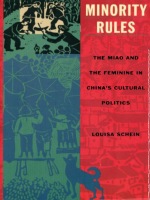 Minority Rules: The Miao and the Feminine in China's Cultural Politics
Louisa Schein
Duke University Press, 2000 Minority Rules is an ethnography of a Chinese people known as the Miao, a group long consigned to the remote highlands and considered backward by other Chinese. Now the nation’s fifth largest minority, the Miao number nearly eight million people speaking various dialects and spread out over seven provinces. In a theoretically innovative work that combines methods from both anthropology and cultural studies, Louisa Schein examines the ways Miao ethnicity is constructed and reworked by the state, by non-state elites, and by the Miao themselves, all in the context of China’s postsocialist reforms and its increasing exchange and fascination with the West. She offers eloquently argued interventions into debates over nationalism, ethnic subjectivity, and the ethnography of the state.
Posing questions about gender, cultural politics, and identity, Schein examines how non-Miao people help to create Miao ethnicity by depicting them as both feminized keepers of Chinese tradition and as exotic others against which dominant groups can assert their own modernity. In representing and consuming aspects of their own culture, Miao distance themselves from the idea that they are less than modern. Thus, Schein explains, everyday practices, village rituals, journalistic encounters, and tourism events are not just moments of cultural production but also performances of modernity through which others are made primitive. Schein finds that these moments frequently highlight internal differences among the Miao and demonstrates how not only minorities but more generally peasants and women offer a valuable key to understanding China as it renegotiates its place in the global order.
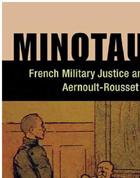 Minotaur: French Military Justice and the Aernoult-Rousset Affair
John Cerullo
Northern Illinois University Press, 2011
On February 11, 1912, an estimated 120,000 people in Paris participated in a ceremony that was at once moving and macabre: a public procession to Père Lachaise Cemetery, where the remains of a soldier named Albert Aernoult would be incinerated after a series of angry speeches denouncing the circumstances of his death. This ceremony occurred at a pivotal point in the “Aernoult-Rousset Affair,” a three-year agitation over the practice of French military justice that was labeled a “proletarian Dreyfus Affair.”
Aernoult had died in one of the French Army’s Algerian penal camps in the summer of 1909, allegedly at the hands of his officers. His death came to the attention of the public through the intervention of a fellow prisoner, a career criminal named Émile Rousset, who provoked prosecution in a military court in order to launch his own J’accuse against camp officers. Rousset’s charges seemed to be bearing fruit until he himself was indicted for murder, whereupon the entire Affair took on a new intensity.
Cerullo’s lively, suspenseful account of this dramatic story, which has never been fully told, will become the standard. In the current era of special military courts, commissions, and prisons, the subject of military justice is an urgent one. Minotaur will interest historians of modern France, military historians and students of military justice, and legal scholars, while also appealing to general readers of modern European history and military law.
Minotaur, Parrot, and the SS Man: Essays on Jorge de Sena
George Monteiro
Tagus Press, 2021 An undisputed giant of twentieth-century Portuguese letters, writer and literary critic Jorge de Sena (1919–1978) spent the most productive decades of his life away from Portugal, teaching at the University of Wisconsin–Madison and the University of California, Santa Barbara. In the essays gathered in this collection, George Monteiro deftly weaves together his readings of Sena's poetry and prose, both literary and critical, with evidence drawn from the deep well of Sena's biographical archive, focusing in particular on his Brazilian and U.S. years. This expansive overview of Sena's unparalleled career, intended to commemorate the centenary of the writer's birth, is also a tribute to Monteiro's own remarkably voluminous and far-reaching body of work on the intersection of Portuguese and Anglo-American literary studies.
 Minotaur: Poetry and the Nation State
Tom Paulin
Harvard University Press, 1992 One of the most powerful poets of his generation consolidates his reputation as an exceptionally forthright and astringent critic in this book that analyzes the relationship between English-language literature, especially poetry, and nineteenth and twentieth-century politics. Tom Paulin's criticism stays on track, always responsive to a work's characteristic genius and sensitive to its social setting.
Each of these essays—on poets ranging from Robert Southey and Christina Rossetti to Philip Larkin, from John Clare to Elizabeth Bishop and Ted Hughes, with a few excursions into the poetry of Eastern Europe for contrast—is informed by a love for poetry and a lively attention to detail. At every turn, Paulin demonstrates the intricate connection between the private imagination and society at large, simultaneously illuminating the kinship between the literature of the past and of the present. He also relates the poetry to themes of nationhood and to ideas about orality, speech rhythms, and vernacular background. Minotaur exemplifies the sort of general, accessible criticism of the arts that will interest a wide range of readers.
 The Minotaur’s Daughter: Selected Poems
Eva Luka
Seagull Books, 2025 Poems from a new Slovak voice reminiscent of Rilke and Sharon Olds.
An evocative collection by Slovak poet Eva Luka, The Minotaur’s Daughter seamlessly melds the human and natural worlds, weaving motifs of mythology, nature, and personal freedom into a tapestry of vivid imagery and profound emotion. The poems traverse settings from Japan to mythic landscapes, exploring the complexities of sexuality, desire, and transition.
Central to Luka’s work is the theme of resistance—against societal pressures and psychic harm. Her poetic voice defies artistic conformity, merging human and animal identities to challenge gender norms and explore mutable identities. Through this innovative fusion, her poems capture both the terror and beauty of existence, drawing parallels to Rilke's metaphysical explorations while grounding her work in the pantheistic and protoplasmic. Journeying through darkness and light, The Minotaur’s Daughter reveals an unwavering commitment to artistic and personal truth, establishing Luka as a formidable voice of resistance in contemporary European poetry.
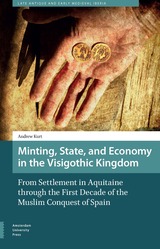 Minting, State, and Economy in the Visigothic Kingdom: From Settlement in Aquitaine through the First Decade of the Muslim Conquest of Spain
Andrew Kurt
Amsterdam University Press, 2020 This study of the Visigothic kingdom's monetary system in southern Gaul and Hispania from the fifth century through the Muslim invasion of Spain fills a major gap in the scholarship of late antiquity. Examining all aspects of the making of currency, it sets minting in relation to questions of state, monarchical power, administration and apparatus, motives for money production, and economy. In the context of the later Roman Empire and its successor states in the West, the minting and currency of the Visigoths reveal shared patterns as well as originality. The analysis brings both economic life and the needs of the state into sharper focus, with significant implications for the study of an essential element in daily life and government. This study combines an appreciation for the surprising level of sophistication in the Visigothic minting system with an accessible approach to a subject which can seem complex and abstruse.
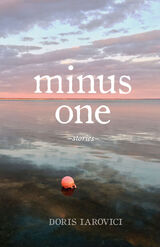 Minus One
Doris Iarovici
University of Wisconsin Press, 2020 By turns wrenching, transcendent, and haunting, the rich stories in Minus One follow characters whose lives are upended by death, estrangement, and loss—and the ways they must negotiate loneliness and absence to rebuild their new realities. In intimate portraits, a psychiatrist analyzes the missed signs of her stepson’s dangerous addiction, a resentful boy seeks revenge against his stepmother, a surgeon confronts his failed marriages, an artist searches for a new identity in widowhood, and a young dancer plots to escape a manipulative older partner.
Woven through this slim and powerful volume are astute observations on how pain and grief can be inherited from one generation to the next. With tenderness and honesty, Doris Iarovici explores the plunging depths of the human experience, lingering on moments of familial warmth and joy but never shying away from conflict and tension. These stories reveal glimmers of hope and possibility, even in our darkest times.
The Minuses
Jami Macarty
University Press of Colorado, 2020 Conjuring the literature of the desert, such as If There Were Anywhere But Desert by Edmond Jabès, Desert Solitaire by Edward Abbey, andLand of Little Rain by Mary Austin, Jami Macarty’s The Minuses beckons attention to ecological and feminist issues and the co-incidence of eating disorders, sexual harassment, family and intimate partner violence, homelessness, suicide, environmental destruction, and other forms of endangerment. Seeking escape from relationship, belief, and self, multi-perspective survivors claim voice as contemplators of natural splendors, and as seekers of incarnate desires. These voices amplify the precariousness that predicates women's lives and the natural world, laying bare the struggle and faith required to endure with integrity and spirit intact.
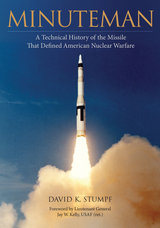 Minuteman: A Technical History of the Missile That Defined American Nuclear Warfare
David K. Stumpf
University of Arkansas Press, 2020 In Minuteman: A Technical History of the Missile That Defined American Nuclear Warfare, David K. Stumpf demystifies the intercontinental ballistic missile program that was conceived at the end of the Eisenhower administration as a key component of the US nuclear strategy of massive retaliation. Although its nuclear warhead may have lacked power relative to that of the Titan II, the Minuteman more than made up for this in terms of numbers and readiness to launch—making it the ultimate ICBM.
Minuteman offers a fascinating look at the technological breakthroughs necessary to field this weapon system that has served as a powerful component of the strategic nuclear triad for more than half a century. With exacting detail, Stumpf examines the construction of launch and launch control facilities; innovations in solid propellant, lightweight inertial guidance systems, and lightweight reentry vehicle development; and key flight tests and operational flight programs—all while situating the Minuteman program in the context of world events. In doing so, the author reveals how the historic missile has adapted to changing defense strategies—from counterforce to mutually assured destruction to sufficiency.
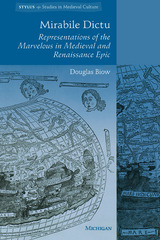 Mirabile Dictu: Representations of the Marvelous in Medieval and Renaissance Epic
Douglas Biow
University of Michigan Press, 1996 Mirabile Dictu covers in six separate chapters the works of Virgil, Dante, Boccaccio, Ariosto, Tasso, and Spenser. Its broad aim is to provide a select cross-section of works in the Middle Ages and Renaissance in order systematically to examine and compare for the first time the marvelous in the light of epic genre, of literary and critical theory (both past and present), and of historically and culturally determined representational practices. Douglas Biow organizes this volume around the literary topos of the bleeding branch through which a metamorphosed person speaks. In each chapter the author takes this "marvellous event" as his starting point for a broad-ranging comparison of the several poets who employed the image; he also investigates the ways in which a period's notion of "history" underpins its representations of the marvelous. This method offers a controlled yet flexible framework within which to develop readings that engage a multiplicity of theories and approaches. Mirabile Dictu offers not only an insightful survey of the literary connections among this group of important poets, but also a useful point of departure for scholars and students intrigued by the reuse of epic conventions, by the peculiar role of "marvellous" events in dramatic poetry, and by the later history of classical literature.
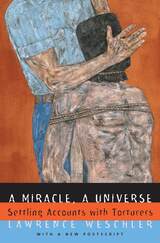 A Miracle, A Universe: Settling Accounts with Torturers
Lawrence Weschler
University of Chicago Press, 1998 During the past fifteen years, one of the most vexing issues facing fledgling transitional democracies around the world—from South Africa to Eastern Europe, from Cambodia to Bosnia—has been what to do about the still-toxic security apparatuses left over from the previous regime. In this now-classic and profoundly influential study, the New Yorker's Lawrence Weschler probes these dilemmas across two gripping narratives (set in Brazil and Uruguay, among the first places to face such concerns), true-life thrillers in which torture victims, faced with the paralysis of the new regime, themselves band together to settle accounts with their former tormentors.
"Disturbing and often enthralling."—New York Times Book Review
"Extraordinarily moving. . . . Weschler writes brilliantly."—Newsday
"Implausible, intricate and dazzling."—Times Literary Supplement
"As Weschler's interviewees told their tales, I paced agitatedly, choked back tears. . . . Weschler narrates these two episodes with skill and tact. . . . An inspiring book."—George Scialabba, Los Angeles Weekly
Miracle Discourse in the New Testament
Duane F. Watson
SBL Press, 2012 This volume explores the rhetorical role that miracle discourse plays in the argumentation of the New Testament and early Christianity. The investigation includes both the rhetoric within miracle discourse and the rhetorical role of miracle discourse as it was incorporated into the larger works in which it is now a part. The volume also examines the social, cultural, religious, political, and ideological associations that miracle discourse had in the first-century Mediterranean world, bringing these insights to bear on the broader questions of early Christian origins. The contributors are L. Gregory Bloomquist, Wendy Cotter, David A. deSilva, Davina C. Lopez, Gail O'Day, Todd Penner, Vernon K. Robbins, and Duane F. Watson.
Miracle Fruit
Aimee Nezhukumatathil
Tupelo Press, 2003 Poetry. As three worlds collide, a mother's Philippines, a father's India and the poet's contemporary America, the resulting impressions are chronicled in this collection of incisive and penetrating verse. The writer weaves her words carefully into a wise and affecting embroidery that celebrates the senses while remaining down-to-earth and genuine. "We see that everything is in fact miracle fruit, including this book itself"-Andrew Hudgins.
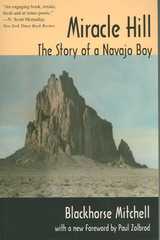 Miracle Hill: The Story of a Navajo Boy
Blackhorse Mitchell
University of Arizona Press, 2004 "It was in the year of 1945 on a cold morning, the third day, in the month of March. A little boy was born as the wind blew against the hogan with bitter colds and the stars were disappearing into the heaven." So begins the story of Broneco, a Navajo boy who tells of his search for a miracle. Through that telling we learn a new perspective on language and life.
In Miracle Hill, Blackhorse Mitchell presents the unforgettable account of a boy’s struggle to learn—which would be for him a miracle—in the face of handicaps most people would call insurmountable. Under the guidance of a teacher determined to help him pursue that miracle, he records his life from birth to the dawn of manhood: herding family sheep, living at a boarding school, encountering whites for the first time, journeying home, and finally enrolling in the Institute of American Indian Arts in Santa Fe, where his talent was encouraged.
Miracle Hill is written in a distinctively personal style, without strict adherence to orthodox grammar that would have robbed Mitchell of his true voice. Filled with unforgettable characters and brimming with insights into Navajo ways and family relationships, it is a book that crosses cultural barriers and speaks to the miracle-seeker in us all.
Miracle Marks: Poems
Purvi Shah
Northwestern University Press, 2019 In her second full-length poetry collection, Miracle Marks, activist Purvi Shah charts women’s status through pointed explorations of Hindu iconography and philosophy and powerful critiques of American racism. In these searing, revelatory poems, Shah reminds us that surviving birth as an infant girl and living as a woman is miraculous—as such, every girl is a miracle mark. And because education is often denied to girls, writing by women is a miracle. In Miracle Marks, Shah probes belonging, devotion, and social inequity, delving into what it means to be a woman, and what it means to be. Through sound energy and white space, these poems chart multiple realities, including the miracles of women’s labors and survivals. This collection spurs dialogue across audiences and communities and lights a way for brown girls and women who relish in spirit, intellect, politics, and justice.
 Miracle of '48
Edited by Steve Neal. Foreword by Robert V. Remini
Southern Illinois University Press, 2003
Miracle of ’48: Harry Truman’s Major Campaign Speeches and Selected Whistle-stopsis the first published collection of the public addresses Harry Truman made as he crisscrossed the United States from New York City to Los Angeles to Independence, Missouri in 1948. Edited by veteran political journalist Steve Neal, and complemented by a foreword from presidential historian Robert V. Remini, this volume captures the infectious spirit and determination of Truman’s message to the American people.
In an era when policy issues were paramount and televised debates were a thing of the future, Truman boldly stated his case directly to the American people, and they responded. “Senator Barkley and I will win this election and make these Republicans like it,” he declared in his acceptance speech at the Democratic National Convention in Philadelphia. “Don’t you forget that. We will do that because they are wrong and we are right.”
From the start of his “non-political” western tour in Crestline, Ohio, through his victory celebration in his hometown of Independence, the plainspoken Truman waged the good fight against all odds, never mixing his words or apologizing for his aggressively honest tactics. In blaming the GOP for a decline in farm prices, he alleged that the 80th Congress had “stuck a pitchfork in the farmer’s backs.” Truman is now regarded as among our greatest presidents and the populist message of his ’48 campaign is still as compelling and relevant today as it was over half a century ago.
“The political history of the United States reveals many unusual developments,” General Dwight D. Eisenhower wrote Truman after the 1948 election, “but certainly at no point does it record a greater accomplishment than yours, that can be traced so clearly to the stark courage and fighting heart of one man.”
 The Miracle of Immortality: What Follows This Earthly Life?
Gerhard Cardinal Muller
Catholic University of America Press, 2026 In The Miracle of Immortality, Gerhard Cardinal Müller tackles some of the great mysteries of human life and hope. The former prefect of the Dicastery for the Doctrine of the Faith is not content merely to present Catholic doctrine on the afterlife and the last things, although his reflections are always rooted in the teachings and traditions of the Church. Rather, he invites readers to walk with him by the restless sea of human learning, a sea formed by man’s unquenchable thirst for something or someone greater than man himself, by his desire to know the beginning and the end.
One who accepts the invitation finds himself in conversation with a mentor whose mind is suffused with scripture and very much sharpened by it. Cherished assumptions are queried or quietly corrected. Slowly but surely he is confronted with the miracle of immortality, without which true happiness is impossible. Cardinal Müller demonstrates in this book that it is entirely possible, and eminently rational, to believe in the miracle of immortality; indeed, that it is ultimately not rational not to believe.
The Miracle of Immortality is a work of penetrating theological insight set, chiaroscuro-like, against the darkness of modern and postmodern skepticism. It is at once poetical in spirit and profoundly catechetical in substance, for Müller understands that Christian eschatology cannot be elucidated properly without proclaiming the whole counsel of God. The miracle in question is a miracle for the whole person, accomplished by way of what Paul calls adoption; that is, filiation to the eternal Father through the incarnate Son, effected by the limitless power of the Holy Spirit. It is a miracle that perfects the divine work of creation.
 The Miracle of the Kent: A Tale of Courage, Faith, and Fire
Nicholas Tracy
Westholme Publishing, 2008 An Extraordinary Rescue and One of the Greatest Human Interest Stories of All Time
“A naturally gripping adventure tale.”—Publishers Weekly
“Powerful and intensely focused.”—Booklist
“Tracy's satisfying narrative constitutes the first modern account. A finely detailed maritime history.”—Kirkus Reviews
In 1825, the Kent, an East Indiaman, set sail from England for India with a crew and nearly 600 men, women, and children on board. North of Spain, the ship was slammed by a ferocious gale, and while a sailor was inspecting the hold for damage, his lantern ignited a cask of spirits. A fire quickly erupted, and even with the desperate expedient of opening hatches and flooding the ship, the fire burned out of control. As night wore on, the ship became an inferno, with the flames moving toward stores of gunpowder. At this point, everyone on board knew that they would perish, and they began preparing for their ghastly deaths. Despite the raging tempest a sailor climbed one last time to the top of the Kent’s mainmast and—miraculously—a sail was sighted on the horizon. It was the Cambria, a small brig on its way to Mexico. The Cambriaspied the burning Kentand through determination and dogged seamanship in towering seas, the little brig closed the doomed vessel. Launching their boats, the Kent’s and Cambria’s crews were able to transfer nearly all of the children, women, and men to the brig and pull away before the Kent exploded. Dangerously overloaded, the Cambriamade the Cornish coast three days later.
In The Miracle of the Kent: A Tale of Courage, Faith, and Fire, award-winning historian Nicholas Tracy reconstructs this extraordinary tale through records left by the participants, revealing how those aboard the Kent faced their deaths, and their reactions to being offered a second chance. The story of the Kentis both a page-turning adventure and an inspirational homage to the capacity of the human spirit.
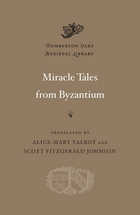 Miracle Tales from Byzantium
Alice-Mary Talbot
Harvard University Press, 2012 Miracles occupied a unique place in medieval and Byzantine life and thought. This volume makes available three collections of miracle tales never before translated into English. Together, the collections offer an exceptional variety of miracles from the Byzantine era.
First are the fifth-century Miracles of Saint Thekla. Legendary female companion of the Apostle Paul, Thekla counted among the most revered martyrs of the early church. Her Miracles depict activities, at once extraordinary and ordinary, in a rural healing shrine at a time when Christianity was still supplanting traditional religion. A half millennium later comes another anonymous text, the tenth-century Miracles of the Spring of the Virgin Mary. This collection describes how the marvelous waters at this shrine outside Constantinople healed emperors, courtiers, and churchmen. Complementing the first two collections are the Miracles of Saint Gregory Palamas, fourteenth-century archbishop of Thessalonike. Written by the most gifted hagiographer of his era (Philotheos Kokkinos), this account tells of miraculous healings that Palamas performed, both while alive and once dead. It allows readers to witness the development of a saint’s cult in late Byzantium. Saints and their miracles were essential components of faith in medieval and Byzantine culture. These collections deepen our understanding of attitudes toward miracles. Simultaneously, they display a remarkable range of registers in which Greek could be written during the still little-known Byzantine period.
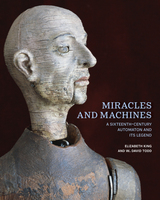 Miracles and Machines: A Sixteenth-Century Automaton and Its Legend
Elizabeth King
J. Paul Getty Trust, The An abundantly illustrated narrative that draws from the history of art, science, technology, artificial intelligence, psychology, religion, and conservation in telling the extraordinary story of a Renaissance robot that prays.
This volume tells the singular story of an uncanny, rare object at the cusp of art and science: a 450-year-old automaton known as “the monk.” The walking, gesticulating figure of a friar, in the collection of the Smithsonian Institution’s National Museum of American History, is among the earliest extant ancestors of the self-propelled robot. According to legend connected to the court of Philip II of Spain, the monk represents a portrait of Diego de Alcalá, a humble Franciscan lay brother whose holy corpse was said to be agent to the miraculous cure of Spain’s crown prince as he lay dying in 1562.
In tracking the origins of the monk and its legend, the authors visited archives, libraries, and museums across the United States and Europe, probing the paradox of a mechanical object performing an apparently spiritual act. They identified seven kindred automata from the same period, which, they argue, form a paradigmatic class of walking “prime movers,” unprecedented in their combination of visual and functional realism. While most of the literature on automata focuses on the Enlightenment, this enthralling narrative journeys back to the late Renaissance, when clockwork machinery was entirely new, foretelling the evolution of artificial life to come.
 The Miracles of St. John of Capistran
Stanko Andric
Central European University Press, 2000 Religious history and, in particular, the history of the cult of saints and their miracles has recently become one of the most popular fields of historical investigation. Together with continuing interest in the related ecclesiastic motivations and the well organized craft of hagiography, this new interest might be explained by the marvellously rich details of thousands of witness accounts testifying to the miraculous help they received from the saint in times of desparate need. These accounts provide an unparalleled insight into the history of everyday life and into the various hardships, illnesses, hopes dreams and anxieties during the late medieval and early modern period. Only two records exist on the history of the medieval Hungarian kingdom- the thirteenth century canonization trial of St. Margaret of Hungary and the miracle collections promoting the canonization of St. John of Capistran, the victorious Crusader at Belgrade in 1456, who died thereafter in Ilok (a city located on the periphery of western Christianity in Croatia). Based on a careful study of the widely scattered manuscripts on Capistranean miracles and with the help of a microscopic philological analysis, the author has managed to reconstruct, for the first time, one of the most complex miracle collections in the history of medieval hagiography. Covering the recording of the first miracle series by the urban notaries of Ilok, the local hagiographer of Ilok Franciscans (John Geszti), the vicar general of the Hungarian province (Stephen Varsányi), and a number of subsequent editions and amplifications of this material recycling into the canonization campaign of St. John of Capistran and the miracles he himself recorded, The Miracles of St. John of Capistran, is an outstanding debut by a representative of a new generation of Central European medievalists.
 Miracles of the Virgin. Tract on Abuses
Nigel of Canterbury
Harvard University Press, 2022 The first English translation of the earliest Latin poems about miracles performed by the Virgin Mary, composed in twelfth-century Canterbury by a Benedictine monk who inspired Chaucer.
Nigel (ca. 1135–1198), a Benedictine monk at Christ Church in Canterbury, is best known for The Mirror of Fools—a popular satire whose hero Burnellus the Ass is referenced in Chaucer’s Canterbury Tales. Nigel’s oeuvre also includes other important poems and hagiography.
The Miracles of the Virgin is the oldest Latin poem about miracles performed by Mary. This collection features seventeen lively tales in which the Virgin rescues a disappointed administrator from a pact with the devil, has a Roman emperor killed by a long-dead martyr, saves a Jewish boy from being burned alive, and shields an abbess from the shame of pregnancy. Each story illustrates the boundlessness of Mary’s mercy. In the Tract on Abuses, a letter that resembles a religious pamphlet, Nigel rails against ecclesiastical corruption and worldly entanglements.
Alongside authoritative editions of the Latin texts, this volume offers the first translations of both works into English.
Miracles on the Border: Retablos of Mexican Migrants to the United States
Jorge Durand and Douglas S. Massey
University of Arizona Press, 1995 This vivid study, richly illustrated with forty color photographs, offers a multilayered analysis of retablos—folk images painted on tin that are offered as votives of thanks for a miracle granted or a favor bestowed—created by Mexican migrants to the United States. Durand and Massey analyze 124 contemporary retablo texts, scrutinizing the shifting subjects and themes that constitute a running record of the migrant's unique experience. The result is a vivid work of synthesis that connects the history of an art form and a people, links two very different cultures, and allows a deeper understanding of a major twentieth-century theme—the drama of transnational migration.
 Miraculous Celebrity: The Christ of Ixmiquilpan and Colonial Piety in Mexico City
Derek S. Burdette
University of Texas Press, 2025 A study of the Christ of Ixmiquilpan, a historically beloved religious icon from sixteenth-century Mexico, and its evolving cultural importance. The life-sized crucifix known as the Christ of Ixmiquilpan (also the Señor de Santa Teresa) was one of the most important artworks in colonial Mexico. The statue began as an ordinary devotional image, but in 1621 devotees witnessed it undergo a miraculous renovation that gave it a supernatural beauty. Over the next two and half centuries, its perceived power increased until it was surpassed in importance only by the Virgin of Guadalupe. Despite its historical significance, the Christ of Ixmiquilpan’s history has yet to be fully told. Derek Burdette brings the miraculous crucifix out of the shadows and explores its instrumental role in shaping the devotional culture of New Spain. Following the arc of the statue’s life, he chronicles the story of the statue’s creation, miraculous renovation, and subsequent veneration at the heart of Mexico City. He also reveals how colonial politics were woven into the statue’s life from the very start. Reconstructing the history of a key artwork, Miraculous Celebrity sheds new light on the intersection of art, faith, and politics in the Spanish colonial world.
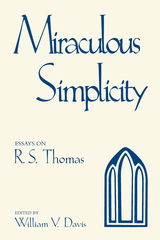 Miraculous Simplicity: Essays on R.S. Thomas
William V. Davis
University of Arkansas Press, 1993 Pondering now the being and nature of God, now the mystery of time, now the assault of contemporary lifestyles on the natural world, R. S. Thomas’s poetry and prose reflect his Welsh heritage and his determination to be Welsh. Moved by his own personal attraction to the work of Thomas and guided by his careful reading of it, William V. Davis brings us this excellent collection of essays exploring the distinguished yet controversial poet-priest. In the autobiographical essay, Thomas reveals his passion for his homeland and his ever-present hunger for spiritual and natural exploration: As I stood in the sun and the sea wind, with my shadow falling upon
those rocks, I certainly was reminded of the transience of human existence,
and my own in particular. As Pindar put it: “A dream about a
shadow is man.” I began to ponder more the being and nature of God
and his relation to the late twentieth-century situation, which science and
technology had created in the western world. Where did the ancient
world of rock and ocean fit into an environment in which nuclear physics
and the computer were playing an increasingly prominent part? . . .
Miraculum
Ruth L. Schwartz
Autumn House Press, 2012 As in her previous collections, Miraculum shows Schwartz's true ability as a poet. These poems are passionate, tender, tough, and brimming with life.
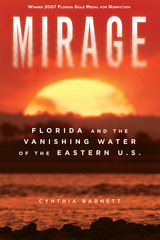 Mirage: Florida and the Vanishing Water of the Eastern U.S.
Cynthia Barnett
University of Michigan Press, 2007 “Never before has the case been more compellingly made that America’s dependence on a free and abundant water supply has become an illusion. Cynthia Barnett does it by telling us the stories of the amazing personalities behind our water wars, the stunning contradictions that allow the wettest state to have the most watered lawns, and the thorough research that makes her conclusions inescapable. Barnett has established herself as one of Florida’s best journalists and Mirage is a must-read for anyone who cares about the future of the state.” —Mary Ellen Klas, Capital Bureau Chief, Miami Herald “Mirage is the finest general study to date of the freshwater-supply crisis in Florida. Well-meaning villains abound in Cynthia Barnett’s story, but so too do heroes, such as Arthur R. Marshall Jr., Nathaniel Reed, and Marjorie Harris Carr. The author’s research is as thorough as her prose is graceful. Drinking water is the new oil. Get used to it.” —Michael Gannon, Distinguished Professor of history, University of Florida, and author of Florida: A Short History “With lively prose and a journalist’s eye for a good story, Cynthia Barnett offers a sobering account of water scarcity problems facing Florida—one of our wettest states—and the rest of the East Coast. Drawing on lessons learned from the American West, Mirage uses the lens of cultural attitudes about water use and misuse to plead for reform. Sure to engage and fascinate as it informs.” —Robert Glennon, Morris K. Udall Professor of Law and Public Policy, University of Arizona, and author of Water Follies: Groundwater Pumping and the Fate of America’s Fresh Waters Part investigative journalism, part environmental history, Mirage reveals how the eastern half of the nation—historically so wet that early settlers predicted it would never even need irrigation—has squandered so much of its abundant freshwater that it now faces shortages and conflicts once unique to the arid West. Florida’s parched swamps and supersized residential developments set the stage in the first book to call attention to the steady disappearance of freshwater in the American East, from water-diversion threats in the Great Lakes to tapped-out freshwater aquifers along the Atlantic seaboard. Told through a colorful cast of characters including Walt Disney, Jeb Bush and Texas oilman Boone Pickens, Mirage ferries the reader through the key water-supply issues facing America and the globe: water wars, the politics of development, inequities in the price of water, the bottled-water industry, privatization, and new-water-supply schemes. From its calamitous opening scene of a sinkhole swallowing a house in Florida to its concluding meditation on the relationship between water and the American character, Mirage is a compelling and timely portrait of the use and abuse of freshwater in an era of rapidly vanishing natural resources.
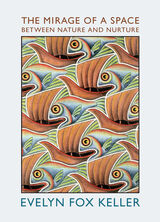 The Mirage of a Space between Nature and Nurture
Evelyn Fox Keller
Duke University Press, 2010 In this powerful critique, the esteemed historian and philosopher of science Evelyn Fox Keller addresses the nature-nurture debates, including the persistent disputes regarding the roles played by genes and the environment in determining individual traits and behavior. Keller is interested in both how an oppositional “versus” came to be inserted between nature and nurture, and how the distinction on which that opposition depends, the idea that nature and nurture are separable, came to be taken for granted. How, she asks, did the illusion of a space between nature and nurture become entrenched in our thinking, and why is it so tenacious? Keller reveals that the assumption that the influences of nature and nurture can be separated is neither timeless nor universal, but rather a notion that emerged in Anglo-American culture in the late nineteenth century. She shows that the seemingly clear-cut nature-nurture debate is riddled with incoherence. It encompasses many disparate questions knitted together into an indissoluble tangle, and it is marked by a chronic ambiguity in language. There is little consensus about the meanings of terms such as nature, nurture, gene, and environment. Keller suggests that contemporary genetics can provide a more appropriate, precise, and useful vocabulary, one that might help put an end to the confusion surrounding the nature-nurture controversy.
The Mirage of Health: Utopia, Progress, and Biological Change
Dubos, Jean
Rutgers University Press, 1987 'Complete freedom from disease and from struggle is almost incompatible with the process of living, ' Rene Dubos asserted in this classic essay on ecology and health. All the accomplishments of science and technology, he argued, will not bring the utopian dream of universal well-being, because they ignore the dynamic process of adaptation to a constantly changing environment that every living organism must face.
 Mirage-Land: Images of Nevada
Wilbur S. Shepperson
University of Nevada Press, 1996 In a century-old edition of a British newspaper, a quaint narrative entitled "A Visit to the Comstock" was prefaced by the following poem: Paint me, Washoe, as you see it, / Tinting with a truthful touch; / Line it with a faithful pencil, / Do not colour overmuch. Many writers through the decades have "coloured overmuch" in their descriptions of Nevada by using picturesque words and extreme language when discussing the paradoxical state. Idah Meacham Strobridge, often called "Nevada's first woman of letters", pointed out that images of Nevada frequently suggest a "mirage-land", a place where nothing is quite what it seems. Wilbur S. Shepperson's examination of such mirages--imaginary, literary, historical, real--is the subject of Mirage-Land: Images of Nevada. In the pages of this book, readers will discover ways in which a variety of men and women image-makers envisioned the Silver State, as well as ways they communicated their visions to others. Shepperson explains the process of mirage building by introducing readers to details from myriad sources--journals, diaries, historic newspapers, government reports, essays, magazines, novels, and even chamber of commerce promotional brochures. The well-known accents of John C. Fremont, Mark Twain, and Dan De Quille mingle with such little-known voices as Louise M. Palmer, Henry T. Williams, and George Wharton James among others. While the exemplary voices may express paradox, self-contradiction, antithesis, even confusion, Shepperson arranges his examples in a way that shows readers an aggregate vision. For him, Nevada history and Nevada humanity together embrace the length of Highway 395, the width of Interstates 80 and 15, and the breadthof a good many gravel roads in between. Essentially Shepperson sees few meaningful differences between the Comstock of the 1860s, other mining camps, sheep and cattle operations, Reno of the 1930s, and the present-day Las Vegas.
 Mirages: The Unexpurgated Diary of Anaïs Nin, 1939–1947
Anaïs Nin
Ohio University Press, 2013 Mirages opens at the dawn of World War II, when Anaïs Nin fled Paris, where she lived for fifteen years with her husband, banker Hugh Guiler, and ends in 1947 when she meets the man who would be “the One,” the lover who would satisfy her insatiable hunger for connection. In the middle looms a period Nin describes as “hell,” during which she experiences a kind of erotic madness, a delirium that fuels her search for love. As a child suffering abandonment by her father, Anaïs wrote, “Close your eyes to the ugly things,” and, against a horrifying backdrop of war and death, Nin combats the world’s darkness with her own search for light.
Mirages collects, for the first time, the story that was cut from all of Nin’s other published diaries, particularly volumes 3 and 4 of The Diary of Anaïs Nin, which cover the same time period. It is the long-awaited successor to the previous unexpurgated diaries Henry and June, Incest, Fire, and Nearer the Moon. Mirages answers the questions Nin readers have been asking for decades: What led to the demise of Nin’s love affair with Henry Miller? Just how troubled was her marriage to Hugh Guiler? What is the story behind Nin’s “children,” the effeminate young men she seemed to collect at will? Mirages is a deeply personal story of heartbreak, despair, desperation, carnage, and deep mourning, but it is also one of courage, persistence, evolution, and redemption that reaches beyond the personal to the universal.
 Miranda: The Story of America’s Right to Remain Silent
Gary L. Staurt
University of Arizona Press, 2004 One of the most significant Supreme Court cases in U.S. history has its roots in Arizona and is closely tied to the state’s leading legal figures. Miranda has become a household word; now Gary Stuart tells the inside story of this famous case, and with it the legal history of the accused’s right to counsel and silence.
Ernesto Miranda was an uneducated Hispanic man arrested in 1963 in connection with a series of sexual assaults, to which he confessed within hours. He was convicted not on the strength of eyewitness testimony or physical evidence but almost entirely because he had incriminated himself without knowing it—and without knowing that he didn’t have to. Miranda’s lawyers, John P. Frank and John F. Flynn, were among the most prominent in the state, and their work soon focused the entire country on the issue of their client’s rights. A 1966 Supreme Court decision held that Miranda’s rights had been violated and resulted in the now-famous "Miranda warnings."
Stuart personally knows many of the figures involved in Miranda, and here he unravels its complex history, revealing how the defense attorneys created the argument brought before the Court and analyzing the competing societal interests involved in the case. He considers Miranda's aftermath—not only the test cases and ongoing political and legal debate but also what happened to Ernesto Miranda. He then updates the story to the Supreme Court’s 2000 Dickerson decision upholding Miranda and considers its implications for cases in the wake of 9/11 and the rights of suspected terrorists. Interviews with 24 individuals directly concerned with the decision—lawyers, judges, and police officers, as well as suspects, scholars, and ordinary citizens—offer observations on the case’s impact on law enforcement and on the rights of the accused.
Ten years after the decision in the case that bears his name, Ernesto Miranda was murdered in a knife fight at a Phoenix bar, and his suspected killer was "Mirandized" before confessing to the crime. Miranda: The Story of America’s Right to Remain Silent considers the legacy of that case and its fate in the twenty-first century as we face new challenges in the criminal justice system.
Miranda's Waning Protections: Police Interrogation Practices after Dickerson
Welsh S. White
University of Michigan Press, 2003 Did the Supreme Court's upholding of Miranda in 2000 adversely impact law enforcement, as conservatives have complained, or was it a reaffirmation of individual rights?
Welsh S. White looks at both sides of the issue, emphasizing that Miranda represents just one stage in the Court's ongoing struggle to accommodate a fundamental conflict between law enforcement and civil liberties, and assessing whether the Court's present decisions (including Miranda) strike an appropriate balance between promoting law enforcement's interest in obtaining reliable evidence and the individual's interest in being protected from overreaching police practices.
Welsh S. White is Professor of Law, University of Pittsburgh School of Law. He is best known for his work on capital punishment and has published and lectured on the death penalty for the past twenty years.
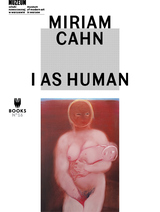 MIRIAM CAHN: I AS HUMAN
Marta Dziewanska et al.
Museum of Modern Art in Warsaw, 2019 A rebel and feminist, the Switzerland-born Miriam Cahn is one of the major artists of her generation. Widely known for her drawings and paintings, she also experiments with photography, moving images, sculptures, and performance art. Cahn’s diverse body of work is disturbing and dreamlike, filled with striking human figures pulsing with an energy both passionate and violent. These pieces, along with Cahn’s reflections on artistic expression, have always responded to her contemporary moment. In the 1980s, her work addressed the feminist, peace, and environmental movements, while the work she produced in the 1990s and early 2000s contains allusions to the war in the former Yugoslavia, the conflict in the Middle East, and the September 11 terrorist attacks. Her recent production tackles ever-evolving political conflicts, engaging with the European refugee crisis and the “#metoo” movement.
Miriam Cahn: I as Human examines different facets of the artist’s prolific and troubling oeuvre, featuring contributions from art historians, critics, and philosophers including Kathleen Bühler, Paul B. Preciado, Elisabeth Lebovici, Adam Szymczyk, Natalia Sielewicz and .
Miriam Hansen: Cinema, Experience, and the Public Sphere
David Bathrick, Andreas Huyssen, and Eric Rentschler, special issue editors
Duke University Press This issue is dedicated to the thought and writing of Miriam Hansen, whose contributions broke ground in film history, film theory, and the politics of mass culture and the public sphere. The collection focuses on the areas in which she was most influential: early cinema, its reception, and the legacy of vernacular modernism, including essays touching on the concept’s impact on contemporary thinking about Russian and Chinese cinemas. The issue also features extensive commentary on Hansen’s pioneering book Cinema and Experience, expanding on the book’s inquiry into the continuing legacy of the Frankfurt School.
 Miriam Hearing Sister: A Memoir
Miriam Zadek
Gallaudet University Press, 2022 Miriam Zadek shares her story in this memoir that documents her experiences growing up in a New York Jewish family with both deaf and hearing members from the 1930s through World War II and beyond. Her story is personal and reflective, revealing the sometimes complex and heart-rending dynamics within her family and her community. Through brief and evocative vignettes, Zadek relates her memories of family life, capturing the innocence of childhood, the confusion of adolescence, and then progressing through adulthood. Her recollections evolve from a childlike observance to awareness, pain, and understanding as she matures. Throughout this journey, the author presents a narrative of historical and cultural importance centered on her personal account of the lives of deaf and hearing Jewish people in the mid-twentieth century.
The prevailing ideological movements of the time permeate her family life. Zadek reveals the traumatic impact of eugenics and the fears surrounding the genetic transmission of deafness. She considers the effects of adhering to the oral method of communication in her home when sign language could have given her family the ability to interact with each other more fully. In this environment, Zadek became an astute communicator and learned to adapt to both the hearing and the deaf world, where she was known as “Miriam Hearing Sister.” Her memoir is an elegant literary work that offers an understanding of how biases and stigmas resonate and evolve, and it showcases her loving family of strong women who pushed against stereotypes and have thrived across generations.
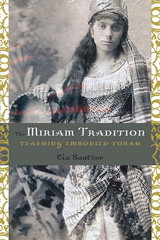 The Miriam Tradition: Teaching Embodied Torah
Cia Sautter
University of Illinois Press, 2010 The Miriam Tradition works from the premise that religious values form in and through movement, with ritual and dance developing patterns for enacting those values. Cia Sautter considers the case of Sephardic Jewish women who, following in the tradition of Miriam the prophet, performed dance and music for Jewish celebrations and special occasions. She uses rabbinic and feminist understandings of the Torah to argue that these women, called tanyaderas, "taught" Jewish values by leading appropriate behavior for major life events. Sautter considers the religious values that are in music and dance performed by tanyaderas and examines them in conjunction with written and visual records and evidence from dance and music traditions. Explaining the symbolic gestures and motions encoded in dances, Sautter shows how rituals display deeply held values that are best expressed through the body. The book argues that the activities of women in other religions might also be examined for their embodiment and display of important values, bringing forgotten groups of women back into the historical record as important community leaders
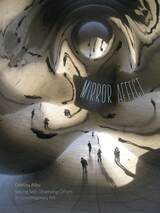 Mirror Affect: Seeing Self, Observing Others in Contemporary Art
Cristina Albu
University of Minnesota Press, 2016 For decades, contemporary artworks with reflective properties have stimulated public forms of spectatorship. According to Cristina Albu, these artworks, which can include elements such as mirrors, live video feedback, or sensors, draw attention to affective interdependence and mechanisms of social control. In Mirror Affect, Albu provides a historical account of mirroring processes in contemporary art and offers insight into the phenomenological and sociopolitical concerns that have inspired artists to stage processes of affective, perceptual, and behavioral mirroring between art viewers. Beginning with the 1960s, Albu charts the rise of interpersonal modes of art spectatorship. She reveals contemporary artists’ strategic use of reflective and responsive interfaces to instill doubt in visual representation and appeal to active scrutiny of the changing social dynamics. She suggests that the mirroring processes envisioned by contemporary artists such as Joan Jonas, Dan Graham, Lynn Hershman Leeson, Olafur Eliasson, and Rafael Lozano-Hemmer trigger visual disjunctions to upset narcissistic inclinations. They invite viewers to see themselves in relation to others and to ponder their role within complex social systems. From sculpture and performance to art and technology projects, video art, and installation art, Mirror Affect analyzes forms of interpersonal spectatorship, revising and expanding current historiographies of participatory art.
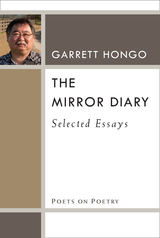 The Mirror Diary: Selected Essays
Garrett Hongo
University of Michigan Press, 2017 A volume in the Poets on Poetry series, which collects critical works by contemporary poets, gathering together the articles, interviews, and book reviews by which they have articulated the poetics of a new generation.
The Mirror Diary tracks the emergence of an original poetic voice and a learned consciousness amid multiple and sometimes competing influences of complex literary traditions and regional and ethnic histories. Beginning with a literary inquiry into the history of Japanese Americans in Hawai`i and California, Garrett Hongo draws on his own history to consider the mosaic of American identities—personal, cultural, and poetic—in the context of a postmodern diaspora.
Hongo’s essays attest to the breadth of what he considers his cultural inheritance and literary antecedents, ranging from the poets of China’s T’ang Dynasty to American poets such as Walt Whitman and Charles Olson. He explains free-verse prosody by way of John Coltrane’s jazz; praises his contemporaries, poets David Mura, Edward Hirsch, and Mark Jarman; and acknowledges his mentors, Bert Meyers and Charles Wright. In other pieces he engages with controversies and contestations in contemporary Asian American literature, confronts the politics of race and the legacy of Japanese American internment during World War II, offers paeans to the Hawaiian landscape, and addresses immigrants newly arrived in America with a warm welcome. The Mirror Diary is the work of a poet fully engaged with contemporary politics and poetics and committed to the study and celebration of diverse traditions.
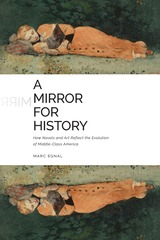 A Mirror for History: How Novels and Art Reflect the Evolution of Middle-Class America
Marc Egnal
University of Tennessee Press, 2024 In A Mirror for History, author Marc Egnal uses novels and art to provide a new understanding of American society. The book argues that the arc of middle-class culture reflects the evolution of the American economy from the near-subsistence agriculture of the 1750s to the extraordinarily unequal society of the twenty-first century. Fiction offers a rich source for this analysis. By delving deep into the souls of characters and their complex worlds, novels shed light on the dreams, hopes, and goals of individuals and reveal the structures that shape character’s lives. Additionally, paintings of the time periods expand upon these insights drawn from literature.
Egnal’s lively exploration of the changing economy, fiction, art, and American values is organized into four expansive periods—the Sentimental Era, Genteel America, Modern Society, and Post-Modern America. Within that framework, A Mirror for History looks at topics such as masculinity, childhood, the status of women, the outlook of African Americans, the role of religion, and varying views of capitalism.
Readers will be enthralled to find discussions of overlooked novels and paintings as well as discover new approaches to familiar pieces. A Mirror for History examines over one hundred authors and dozens of artists and their works, presented here in full color.
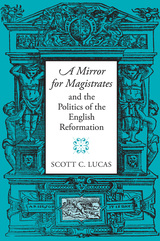 "A Mirror for Magistrates" and the Politics of the English Reformation
Scott Lucas
University of Massachusetts Press, 2009 Perhaps no other work of secular poetry was as widely read in Tudor England as the historical verse tragedy collection A Mirror for Magistrates. For over sixty years (1559–1621), this compendium of tragic monologues presented in the voices of fallen political figures from England's past remained almost constantly in print, offering both exemplary warnings to English rulers and inspiring models for literary authors, including Spenser and Shakespeare.
In a striking departure from previous scholarship, Scott Lucas shows that modern critics have misconstrued the purpose of the tragic verse narratives of the Mirror, approaching them primarily as uncontroversial meditations on abstract political and philosophical doctrines. Lucas revises this view, revealing many of the Mirror tragedies to be works topically applicable in form and politically contentious in nature.
Lucas returns the earliest poems of A Mirror for Magistrates to the troubled context of their production, the tumultuous reign of the Catholic Queen Mary (1553–1558). As Protestants suffering from the traumatic collapse of King Edward VI's "godly" rule (1547–1553) and from the current policies of Mary's government, the Mirror authors radically reshaped their poems' historical sources in order to craft emotionally moving narratives designed to provide models for interpreting the political failures of Edward VI's reign and to offer urgent warnings to Marian magistrates.
Lucas's study also reveals how, in later poems, the Mirror authors issued oblique appeals to Queen Elizabeth's officers, boldly demanding that they allow the realm of "the literary" to stand as an unfettered discursive arena of public controversy. Lucas thus provides a provocative new approach to this seminal but long-misunderstood collection, one that restores the Mirror to its rightful place as one of the greatest works of sixteenth-century English political literature.
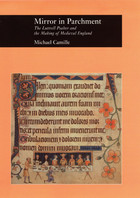 Mirror in Parchment: The Luttrell Psalter and the Making of Medieval England
Michael Camille
University of Chicago Press, 1998 What is the status of visual evidence in history? Can we actually see the past through images? Where are the traces of previous lives deposited? Michael Camille addresses these important questions in Mirror in Parchment, a lively, searching study of one medieval manuscript, its patron, producers, and historical progeny.
The richly illuminated Luttrell Psalter was created for the English nobleman Sir Geoffrey Luttrell (1276-1345). Inexpensive mechanical illustration has since disseminated the book's images to a much wider audience; hence the Psalter's representations of manorial life have come to profoundly shape our modern idea of what medieval English people, high and low, looked like at work and at play. Alongside such supposedly truthful representations, the Psalter presents myriad images of fantastic monsters and beasts. These patently false images have largely been disparaged or ignored by modern historians and art historians alike, for they challenge the credibility of those pictures in the Luttrell Psalter that we wish to see as real.
In the conviction that medieval images were not generally intended to reflect daily life but rather to shape a new reality, Michael Camille analyzes the Psalter's famous pictures as representations of the world, imagined and real, of its original patron. Addressed are late medieval chivalric ideals, physical sites of power, and the boundaries of Sir Geoffrey's imagined community, wherein agricultural laborers and fabulous monsters play a similar ideological role. The Luttrell Psalter thus emerges as a complex social document of the world as its patron hoped and feared it might be.
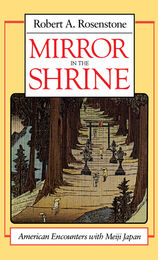 Mirror in the Shrine: American Encounters with Meiji Japan
Robert A. Rosenstone
Harvard University Press, 1988 In the last third of the nineteenth century, three Americans with diverse purposes sailed to Japan—the missionary William Elliot Griffis, the scientist Edward S. Morse, and the writer Lafcadio Hearn. They were to become part of the first generation of American experts on Japan, regularly quoted and widely read. More significantly, their own lives were vastly changed, broadened and enriched in unexpected ways, so that their thoughts dwelt as much on what Americans could learn from the pagan Japanese as on what Americans could teach them.
In telling these stories, Robert Rosenstone evokes the immediacy of daily experience in Meiji Japan, a nation still feudal in many of its habits yet captivating to Westerners for the gentleness of the people, the beauty of the landscape, the human scale of the unspoiled old towns, and the charm of arts and manners. He describes the odyssey of the ambitious and strong-minded Christian minister Griffis, who won few converts but, as a teacher, assisted at the birth of modern Japan. He portrays the natural scientist Morse, a born collector who turned from amassing mollusks to assembling comprehensive collections of Japanese folk art and pottery. He recounts Lafcadio Hearn’s fourteen years in Japan. Hearn, who married a Japanese, became a citizen, and found in his new homeland ideal subject matter for exotic tales of ghosts, demons, spectral lovers, local gods and heroes, spells, enchantments.
Rosenstone recreates the sights and textures of Meiji Japan, but Mirror in the Shrine brings to the reader much more than a traditional rendering. Rather, through the use of some of the techniques of modernist writing, the book provides a multi-voiced narrative in which the words of the present and the past interact to present a fresh view of historical reality. While charting the common stages of these three Americans’ acculturation—growing to like the food, the architecture, the spareness, the mysterious etiquette—the work also highlights the challenges that Japan issues to American culture, in this century as well as in the last: Is it possible to find human fulfillment within the confines of a hierarchical, even repressive, social order? Is it possible for our culture to find a place of importance for such qualities as harmony, aesthetics, morals, manners?
This is a book for anyone who is at all interested in Japan or in the meeting of East and West. The “old Japan hand” will reexperience the freshness of an early love; the newcomer will find it equally evocative and fascinating.
 The Mirror in the Text
Lucien Dällenbach
University of Chicago Press, 1989 The Mirror in the Text is concerned with the literary and artistic device of mise en abyme, the use of an element within a work which mirrors the work as a whole—like the 'play within a play' in Hamlet.
In this classic study, Lucien Dällenbach provides the first systematic analysis of this device and its literary and artistic applications from Van Eyck and Velasquez to Gide, Beckett and the French nouveau roman.
Alongside this wealth of examples, Dällenbach constructs his theoretical argument with elegance and clarity, assuming no previous knowledge of arcane and specialized theory, but guiding the reader helpfully through the maze of literary criticism. The result is a new conceptual field, a new grammar of the mise en abyme, and an examination of its function within the work of art and literature.
The highly original study has been acclaimed as one of the most important works of contemporary literary theory. It will be of interest to all students of English and European literature, as well as to students of the visual arts.
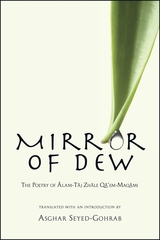 Mirror of Dew: The Poetry of Ālam-tāj Zhāle Qā’em-Maqāmi
Asghar Seyed-Gohrab
Harvard University Press Mirror of Dew introduces one of Iran's outstanding female poets, whose work has not previously been available in English. Zhāle Qā'em-Maqāmi (1883-1946) was a witness to pivotal social and political developments in Iran during its transition to modernity. Persian poetry at that time was often used polemically and didactically, for a mass audience, but Zhāle did not write to be published. The poems, like the mirror, samovar, and other familiar objects we find in them, appear to be the author's intimate companions.
Her poetry is deeply personal but includes social critique and offers a rare window into the impact of a modern awareness on private lives. Zhāle is biting in her condemnation of traditional Persian culture, and even of aspects of Islamic law and custom. She might be called the Emily Dickinson of Persian poetry, although Zhāle was married, against her will. Zhāle is far from the first female poet in Persian literature but is the first we know of to write with an interior, intimate voice about private life, her anxieties, her frustrated love, her feelings about her husband, and many topical issues. This volume presents the Persian text of Zhāle's poems on pages facing the English translations.
 A Mirror of England: English Puritan Views of Foreign Nations, 1618-1640
Marvin Arthur Breslow
Harvard University Press, 1970 During the Thirty Years' War, a war that seemed to be determining the future of Protestantism, those who believed that they were the most truly Protestant part of English society, the Puritans, frequently opposed the foreign policies of the English government. In this perceptive study of the Puritans' contribution to English nationalism between 1618 and 1640, Marvin Arthur Breslow analyzes their attitudes toward foreign nations. He demonstrates how their views of the warring European nations also expressed certain aspects of their thinking about England and how in these views there was mirrored an image of England--an image against which they measured the religion and patriotism of the true Englishman.
Drawing on contemporary parliamentary diaries, letters, memoirs, sermons, and tracts, Breslow discusses specifically the Puritans' attitudes toward Germany, the area in which the Thirty Years' War began; toward Spain, English fear and hatred of which were already firmly established; the Netherlands, with which there was trade rivalry; France, where they were forced to harmonize conflicting interests; and, finally, Sweden. The author identifies several recurrent themes, including a fundamental concern for Protestantism and the effective mythologizing of the Elizabethan past. He also reveals that while Puritan foreign policy was often opposed to the policies of the English government, it accorded closely with the attitudes, however passive, of the general public. The significant differences were the greater degree of intensity with which the Puritans vigorously expressed their concern and their efforts to arouse the general public.
Breslow emphasizes the importance of Puritan foreign-policy attitudes, the fusion of religious and political concerns in the patriotic Englishman, and the Puritan definition of the English nation in the decades preceding the Civil War and Revolution.
The Mirror of Simple Souls
Margaret Porette
University of Notre Dame Press, 1999 This translation from the French original includes an introductory interpretive essay by Edmund Colledge, O.S.A., Judith Grant, and J. C. Marler, and a foreword by Kent Emery, Jr. The translators of this Modern English version rely primarily on the original French manuscript, yet also take medieval translations into account. As a result, this edition offers a reading of The Mirror that solves a number of difficulties found in the French. The valuable introduction by the translators narrates the archival history of the book, for which Margaret Porette was burned alive in Paris in 1310.
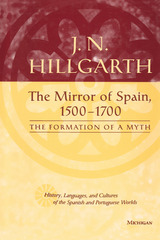 The Mirror of Spain, 1500-1700: The Formation of a Myth
J. N. Hillgarth
University of Michigan Press, 2000 In this major new work, J. N. Hillgarth investigates how Spain was seen by non-Spaniards in the period when it was the leading power in Europe. The author brings together a wide range of sources that elucidate Spanish history and Spanish character. He demonstrates the ways that propaganda has distorted both these things in the past and even continues to do so in the present.
In the first of the volume's four parts, the author discusses the reasons--geographic, political, and religious--why Spain has proved a hard country to understand. Hillgarth looks at travelers to Spain, from pilgrims to diplomats, spies, exiles, and foreign residents. In its second part, special attention is devoted to the interaction between Christians, Jews, and Muslims, including Jewish and Muslim exiles and secret Jews within Spain.
In its third section, The Mirror of Spain explores reactions to Spain by those who saw it from the outside, the Italians, Dutch, French, and English. One chapter deals with the English, Scottish, and Irish Catholics, who, like the Jewish and Muslim exiles, played a double role in that they were at once "insiders" and outsiders. Finally, Hillgarth attempts to show how two crucial centuries have affected the way Spain has been seen down to the present.
The Mirror of Spain draws on a wide range of sources in different languages. It relies on documents in the Public Record Office and the British Library, the Archivo General de Simancas and the collections of the colleges founded by exiles in Spain, and on major libraries in Venice and Jerusalem. The volume will be of interest to a broad spectrum of scholars--to medievalists, historians of Spain, scholars of political and literary thought, and all those interested in notions of national identity.
J. N. Hillgarth has taught for many years at the University of Toronto and the Pontifical Institute of Mediaeval Studies. He is a Fellow of the British Academy and has received awards and honors from a wide variety of distinguished institutions in Europe and North America.
Mirror of the Darkest Night
Mahasweta Devi
Seagull Books It’s the mid-to-late 1800s and the British have banished Wajid Ali Shah—the nawab of Awadh in Lucknow—to Calcutta. To the sound of the soulful melody of the sarangi, the mercurial courtesan Laayl-e Aasman is playing a dangerous game of love, loyalty, deception, and betrayal. Bajrangi and Kundan, bound by their love for each other and for Laayl-e, struggle to keep their balance. Ranging across generations and geography, the scale of Laayl-e’s story sweeps the devil, a crime lord, and many other remarkable characters into a heady mix.
Mirror of the Darkest Night is almost an aberration in Mahasweta Devi’s oeuvre. Known for her activism and hard-hitting indictment of social inequalities, she pays close attention to detail in this sparkling novel. It offers a rare glimpse of Devi’s talent for telling the sort of story she normally eschewed—and it’s a cracker of a tale.
The Mirror of the Sea
Joseph Conrad
Northwestern University Press, 1988 First published in 1906, The Mirror of the Sea was the first of Joseph Conrad's two autobiographical memoirs. Discussing it, he called the book "a very intimate revelation. . . . I have attempted here to lay bare with the unreserve of a last hour's confession the terms of my relation with the sea, which beginning mysteriously, like any great passion the inscrutable Gods send to mortals, went on unreasoning and invincible, surviving the test of disillusion, defying the disenchantment that lurks in every day of a strenuous life; went on full of love's delight and love's anguish, facing them in open-eyed exultation without bitterness and without repining, from the first hour to the last."
 The Mirror of the Self: Sexuality, Self-Knowledge, and the Gaze in the Early Roman Empire
Shadi Bartsch
University of Chicago Press, 2006 People in the ancient world thought of vision as both an ethical tool and a tactile sense, akin to touch. Gazing upon someone—or oneself—was treated as a path to philosophical self-knowledge, but the question of tactility introduced an erotic element as well. In The Mirror of the Self, Shadi Bartsch asserts that these links among vision, sexuality, and self-knowledge are key to the classical understanding of the self.
Weaving together literary theory, philosophy, and social history, Bartsch traces this complex notion of self from Plato’s Greece to Seneca’s Rome. She starts by showing how ancient authors envisioned the mirror as both a tool for ethical self-improvement and, paradoxically, a sign of erotic self-indulgence. Her reading of the Phaedrus, for example, demonstrates that the mirroring gaze in Plato, because of its sexual possibilities, could not be adopted by Roman philosophers and their students. Bartsch goes on to examine the Roman treatment of the ethical and sexual gaze, and she traces how self-knowledge, the philosopher’s body, and the performance of virtue all played a role in shaping the Roman understanding of the nature of selfhood. Culminating in a profoundly original reading of Medea, The Mirror of the Self illustrates how Seneca, in his Stoic quest for self-knowledge, embodies the Roman view, marking a new point in human thought about self-perception.
Bartsch leads readers on a journey that unveils divided selves, moral hypocrisy, and lustful Stoics—and offers fresh insights about seminal works. At once sexy and philosophical, The Mirror of the Self will be required reading for classicists, philosophers, and anthropologists alike.
Mirror to the Cage: Three Contemporary Hungarian Plays
Clara Györgyey
University of Arkansas Press, 1993 This volume presents the works of three distinguished contemporary Hungarian playwrights which together mirror and elucidate the calamitous history of East Central Europe from World War II to the 1970s. Genre 3:
Mirrors Beneath the Earth: Short Fiction by Chicano Writers
Ray González
Northwestern University Press, 1995 Mirrors Beneath the Earth is an historic and unique collection of contemporary Chicano fiction: 31 stories depicting the richly varied experiences of Mexican-Americans in the U.S. Some, like Sandra Cisneros, Rudolfo Anaya, Ana Castillo, are already celebrated writers. The special strength of this anthology is that it introduces others who have never before been published in book form, like Ana Baca, Patricia Blanca, Rafael Jesus Gonzalez, and Natalia Trevino. These writers open our eyes and enrich our understanding.
Mirrors of Entrapment and Emancipation: Forugh Farrokhzad and Sylvia Plath
Leila Rahimi Bahmany
Leiden University Press, 2015 Mirrors of Entrapment and Emancipation explores the rich diversity of the meanings associated with the mirror and reflection in literature by women on the basis of the works of the Persian Forugh Farrokhzad (1935-1967) and her American contemporary Sylvia Plath (1932-1963). These two poets astutely employed mirror images for the realization as well as for communication of their turbulent psycho-emotional states to their readers, thereby capturing and conveying the essence of women desperately trapped among the antithetical images of twentieth-century womanhood.
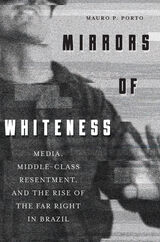 Mirrors of Whiteness: Media, Middle-Class Resentment, and the Rise of the Far Right in Brazil
Mauro Porto
University of Pittsburgh Press, 2022 In Mirrors of Whiteness, Mauro P. Porto examines the conservative revolt of Brazil’s white middle class, which culminated with the 2018 election of far-right candidate Jair Bolsonaro. He identifies the rise of a significant status panic among middle-class publics following the relative economic and social ascension of mostly Black and brown low-income laborers. The book highlights the role of the media in disseminating “mirrors of whiteness,” or spheres of representation that allow white Brazilians to legitimate their power while softening or hiding the inequalities and injustices that such power generates. A detailed analysis of representations of domestic workers in the telenovela Cheias de Charme and of news coverage of affirmative action by the magazine Veja demonstrates that they adopted whiteness as an ideological perspective, disseminating resentment among their audiences and fomenting the conservative revolt that took place in Brazil between 2013 and 2018.
Mirtilla, A Pastoral: A Bilingual Edition
Isabella Andreini
Iter Press, 2018 Isabella Andreini was the most famous actress of the Italian Renaissance, the darling of dukes and kings, as well as of less-moneyed theatergoers. As a founding member with her husband, Francesco, of the Compagnia dei Gelosi, she performed ceaselessly throughout Italy and France, and was prized for the new role she invented for women on stage, that of the ingénue with a comic bent. She was also a playwright; in fact, the first woman to publish a pastoral. This modern edition and translation subtly captures the novelty, as well as the imaginative pyrotechnics, of a brilliant, self-made virtuosa of the stage.
The Other Voice in Early Modern Europe - The Toronto Series: Volume 62
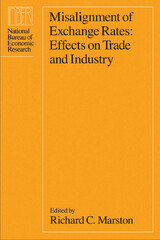 Misalignment of Exchange Rates: Effects on Trade and Industry
Edited by Richard C. Marston
University of Chicago Press, 1988 Economists writing on flexible exchange rates in the 1960s foresaw neither the magnitude nor the persistence of the changes in real exchange rates that have occurred in the last fifteen years. Unexpectedly large movements in relative prices have lead to sharp changes in exports and imports, disrupting normal trading relations and causing shifts in employment and output. Many of the largest changes are not equilibrium adjustments to real disturbances but represent instead sustained departures from long-run equilibrium levels, with real exchange rates remaining "misaligned" for years at a time.
Contributors to Misalignment of Exchange Rates address a series of questions about misalignment. Several papers investigate the causes of misalignment and the extent to which observed movements in real exchange rates can be attributed to misalignment. These studies are conducted both empirically, through the experiences of the United States, Great Britain, Japan, and the countries of the European Monetary System, and theoretically, through models of imperfect competition. Attention is then turned to the effects of misalignment, especially on employment and production, and to detailed estimates of the effects of changes in exchange rates on several industries, including the U.S. auto industry. In response to the contention that there is significant "hysteresis" in the adjustment of employment and production to changes in exchange rates, contributors also attempt to determine whether the effects of misalignment can be reversed once exchange rates return to earlier levels. Finally, the issue of how to avoid—or at least control—misalignment through macroeconomic policy is confronted.
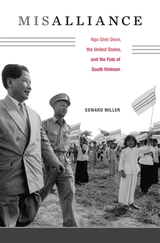 Misalliance: Ngo Dinh Diem, the United States, and the Fate of South Vietnam
Edward Miller
Harvard University Press, 2013 In the annals of Vietnam War history, no figure has been more controversial than Ngo Dinh Diem. During the 1950s, U.S. leaders hailed Diem as “the miracle man of Southeast Asia” and funneled huge amounts of aid to his South Vietnamese government. But in 1963 Diem was ousted and assassinated in a coup endorsed by President John F. Kennedy. Diem’s alliance with Washington has long been seen as a Cold War relationship gone bad, undone either by American arrogance or by Diem’s stubbornness. In Misalliance, Edward Miller provides a convincing new explanation for Diem’s downfall and the larger tragedy of South Vietnam.
For Diem and U.S. leaders, Miller argues, the alliance was more than just a joint effort to contain communism. It was also a means for each side to pursue its plans for nation building in South Vietnam. Miller’s definitive portrait of Diem—based on extensive research in Vietnamese, French, and American archives—demonstrates that the South Vietnamese leader was neither Washington’s pawn nor a tradition-bound mandarin. Rather, he was a shrewd and ruthless operator with his own vision for Vietnam’s modernization. In 1963, allied clashes over development and reform, combined with rising internal resistance to Diem’s nation building programs, fractured the alliance and changed the course of the Vietnam War.
In depicting the rise and fall of the U.S.–Diem partnership, Misalliance shows how America’s fate in Vietnam was written not only on the battlefield but also in Washington’s dealings with its Vietnamese allies.
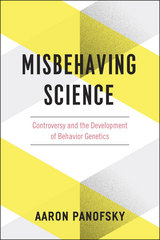 Misbehaving Science: Controversy and the Development of Behavior Genetics
Aaron Panofsky
University of Chicago Press, 2014 Behavior genetics has always been a breeding ground for controversies. From the “criminal chromosome” to the “gay gene,” claims about the influence of genes like these have led to often vitriolic national debates about race, class, and inequality. Many behavior geneticists have encountered accusations of racism and have had their scientific authority and credibility questioned, ruining reputations, and threatening their access to coveted resources.
In Misbehaving Science, Aaron Panofsky traces the field of behavior genetics back to its origins in the 1950s, telling the story through close looks at five major controversies. In the process, Panofsky argues that persistent, ungovernable controversy in behavior genetics is due to the broken hierarchies within the field. All authority and scientific norms are questioned, while the absence of unanimously accepted methods and theories leaves a foundationless field, where disorder is ongoing. Critics charge behavior geneticists with political motivations; champions say they merely follow the data where they lead. But Panofsky shows how pragmatic coping with repeated controversies drives their scientific actions. Ironically, behavior geneticists’ struggles for scientific authority and efforts to deal with the threats to their legitimacy and autonomy have made controversy inevitable—and in some ways essential—to the study of behavior genetics.
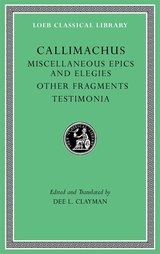 Miscellaneous Epics and Elegies. Other Fragments. Testimonia
Callimachus
Harvard University Press, 2022 The premier scholar-poet of the Hellenistic age.
Callimachus (ca. 303–ca. 235 BC), a proud and well-born native of Cyrene in Libya, came as a young man to the court of the Ptolemies at Alexandria, where he composed poetry for the royal family; helped establish the Library and Museum as a world center of literature, science, and scholarship; and wrote an estimated 800 volumes of poetry and prose on an astounding variety of subjects, including the Pinakes, a descriptive bibliography of the Library’s holdings in 120 volumes. Callimachus’ vast learning richly informs his poetry, which ranges broadly and reworks the language and generic properties of his predecessors in inventive, refined, and expressive ways. The “Callimachean” style, combining learning, elegance, and innovation and prizing brevity, clarity, lightness, and charm, served as an important model for later poets, not least at Rome for Catullus, Virgil, Horace, Ovid, and the elegists, among others.
This edition, which replaces the earlier Loeb editions by A. W. Mair (1921) and C. A. Trypanis (1954, 1958), presents all that currently survives of and about Callimachus and his works, including the ancient commentaries (Diegeseis) and scholia. Volume I contains Aetia, Iambi, and lyric poems; Volume II Hecale, Hymns, and Epigrams; and Volume III miscellaneous epics and elegies, other fragments, and testimonia, together with concordances and a general index. The Greek text is based mainly on Pfeiffer’s but enriched by subsequently published papyri and the judgment of later editors, and its notes and annotation are fully informed by current scholarship.
Miscellaneous Studies in Mexican Prehistory
Michael W. Spence, Jeffrey R. Parsons, and Mary H. Parsons
University of Michigan Press, 1972 In this volume, the authors present research on three important classes of artifacts from Mexico: Michael W. Spence and Jeffrey R. Parsons report on prehispanic obsidian exploitation in Central Mexico and Mary Hrones Parsons writes about Aztec figurines and spindle whorls from the Teotihuacán Valley.
Miscellaneous Studies in Typology and Classification
Anta M. White, Lewis R. Binford and Mark L. Papworth
University of Michigan Press, 1963 This volume includes a report on excavations at three Late Archaic sites in Michigan: the Eastport site in Antrim County, the Hodges site in Saginaw County, and the Pomranky site in Midland County. White contributes a description of chipped stone from the Snyders site in Calhoun County, Illinois, and Binford provides a proposed attribute list for classifying projectile points.
 Miscellaneous Verdicts: Writings on Writers
Anthony Powell
University of Chicago Press, 1992 Miscellaneous Verdicts represents the best of Anthony Powell's critical writing over a period of four decades. Drawn from his regular reviews for the Daily Telegraph, from his occasional humorous pieces for Punch, and from his more sustained pieces of critical and anecdotal writing on writers, this collection is as witty, fresh, surprising, and entertaining as one would expect from the author of Dance to the Music of Time.
Powell begins with a section on the British, exploring his fascination both with genealogy and with figures like John Aubrey, and writing in depth about writers like Kipling, Conrad, and Hardy. The second section, on America, also opens with discussions of family trees (in this case presidential ones) and includes pieces on Henry James, James Thurber, American booksellers in Paris, Hemingway, and Dashiell Hammett. Personal encounters, and absorbing incidents from the lives of his subjects, frequently fill these pages—as they do even more in the section on Powell's contemporaries—Connolly, Orwell, Graham Greene, and others. Finally, and aptly, the book closes with a section on Proust and matters Proustian, including a marvellous essay on what is eaten and drunk, and by whom, in A la Recherche du Temps Perdu.
"An urbane book, quietly erudite, very sensible, highly civilized, remarkably useful."—Anthony Burgess, Observer
"An acute intelligence and fastidious sense of humor make [Powell] the funniest and most profound living writer of the English language."—Hugh Montgomery-Massingberd, Sunday Telegraph
Anthony Powell was born in London in 1905. He is the author of seven novels, a biography of John Aubrey, two plays, a collection of memoirs, and the twelve-volume novel sequence Dance to the Music of Time.
Miscellaneous Writings
G.W.F. Hegel
Northwestern University Press, 2000 This anthology, reflecting virtually every stage of G. W. F. Hegel's life and every area of his interests, provides the most complete picture yet of the intellectual development and activity of this towering figure of philosophy. Previously scattered and often hard to find, the writings collected here are of markedly different genres: introductions, rough drafts, book reviews, poems, speeches, sermons, individual treatises, even student notes and other firsthand reports. By virtue of their heterogeneity, these works bring out the full scope of Hegel's intellectual interests and activities, and often surprising sides of his personality and intellectual character emerge as he plays the unaccustomed roles of poet, priest, reformer, and polemicist.
Miscellanies
Angelo Poliziano
Harvard University Press, 2020 An Open Letters Review Best Book of the Year
Angelo Poliziano (1454–1494) was one of the great scholar-poets of the Italian Renaissance and the leading literary figure of Florence in the age of Lorenzo de’ Medici, “il Magnifico.” The poet’s Miscellanies, including a “first century” published in 1489 and a “second century” unfinished at his death, constitute the most innovative contribution to classical philology of the Renaissance. Each chapter is a mini-essay on some lexical or textual problem which Poliziano, drawing on the riches of the Medici Library and Lorenzo’s collection of antiquities, solves with his characteristic mixture of deep learning, analytic skill, and brash criticism of his predecessors. Volume 1 presents a new Latin edition of The First Century of the Miscellanies, and these volumes together present the first translation of both collections into any modern language.
Miscellanies
Angelo Poliziano
Harvard University Press, 2020 An Open Letters Review Best Book of the Year
Angelo Poliziano (1454–1494) was one of the great scholar-poets of the Italian Renaissance and the leading literary figure of Florence in the age of Lorenzo de’ Medici, “il Magnifico.” The poet’s Miscellanies, including a “first century” published in 1489 and a “second century” unfinished at his death, constitute the most innovative contribution to classical philology of the Renaissance. Each chapter is a mini-essay on some lexical or textual problem which Poliziano, drawing on the riches of the Medici Library and Lorenzo’s collection of antiquities, solves with his characteristic mixture of deep learning, analytic skill, and brash criticism of his predecessors. Volume 1 presents a new Latin edition of The First Century of the Miscellanies, and these volumes together present the first translation of both collections into any modern language.
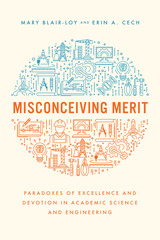 Misconceiving Merit: Paradoxes of Excellence and Devotion in Academic Science and Engineering
Mary Blair-Loy and Erin A. Cech
University of Chicago Press, 2022 An incisive study showing how cultural ideas of merit in academic science produce unfair and unequal outcomes.
In Misconceiving Merit, sociologists Mary Blair-Loy and Erin A. Cech uncover the cultural foundations of a paradox. On one hand, academic science, engineering, and math revere meritocracy, a system that recognizes and rewards those with the greatest talent and dedication. At the same time, women and some racial and sexual minorities remain underrepresented and often feel unwelcome and devalued in STEM. How can academic science, which so highly values meritocracy and objectivity, produce these unequal outcomes?
Blair-Loy and Cech studied more than five hundred STEM professors at a top research university to reveal how unequal and unfair outcomes can emerge alongside commitments to objectivity and excellence. The authors find that academic STEM harbors dominant cultural beliefs that not only perpetuate the mistreatment of scientists from underrepresented groups but hinder innovation. Underrepresented groups are often seen as less fully embodying merit compared to equally productive white and Asian heterosexual men, and the negative consequences of this misjudgment persist regardless of professors’ actual academic productivity. Misconceiving Merit is filled with insights for higher education administrators working toward greater equity as well as for scientists and engineers striving to change entrenched patterns of inequality in STEM.
 Misconceiving Mothers: Legislators, Prosecutors, and the Politics of Prenatal Drug Exposure
Laura Gomez
Temple University Press, 1997 A tiny African-American baby lies in a hospital incubator, tubes protruding from his nostrils, head, and limbs. "He couldn't take the hit," the caption warns. "If you're pregnant, don't take drugs." Ten years earlier, this billboard would have been largely unintelligible to many of us. But when it appeared in 1991, it immediately conjured up several powerful images: the helpless infant himself; his unseen environment, a newborn intensive care unit filled with babies crying inconsolably; and the mother who did this -- crack-addicted and unrepentant.
Misconceiving Mothers is a case study of how public policy about reproduction and crime is made. Laura E. Gomez uses secondary research and first-hand interviews with legislators and prosecutors to examine attitudes toward the criminalization and/or medicalization of drug use during pregnancy by the legislature and criminal justice systems in California. She traces how an initial tendency toward criminalization gave way to a trend toward seeing the problem of "crack babies" as an issue of social welfare and public health.
It is no surprise that in an atmosphere of mother-blaming, particularly targeted at poor women and women of color, "crack babies" so easily captured the American popular imagination in the late 1980s. What is surprising is the was prenatal drug exposure came to be institutionalized in the state apparatus. Gomez attributes this circumstance to four interrelated cause: the gendered nature of the social problem; the recasting of the problem as fundamentally "medical" rather than "criminal"; the dynamic nature of t he process of institutionalization; and the specific feature of the legal institutions -- that is, the legislature and prosecutors' offices -- the became prominent in the case.
At one level Misconceiving Mothers tells the story of a particular problem at a particular time and place -- how the California legislature and district attorneys grappled with pregnant women's drug use in the late 1980s and early 1990s. At another level, the book tells a more general story about the political nature of contemporary social problems. The story it tells is political not just because it deals with the character of political institutions but because the process itself and the nature of the claims-making concern the power to control the allocation of state resources.
A number of studies have looked at how the initial criminalization of social problems takes place. Misconceiving Mothers looks at the process by which a criminalized social problem is institutionalized through the attitudes and policies of elite decision-makers.
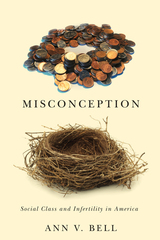 Misconception: Social Class and Infertility in America
Bell, Ann V.
Rutgers University Press, 2014 Despite the fact that, statistically, women of low socioeconomic status (SES) experience greater difficulty conceiving children, infertility is generally understood to be a wealthy, white woman’s issue. In Misconception, Ann V. Bell overturns such historically ingrained notions of infertility by examining the experiences of poor women and women of color. These women, so the stereotype would have it, are simply too fertile. The fertility of affluent and of poor women is perceived differently, and these perceptions have political and social consequences, as social policies have entrenched these ideas throughout U.S. history. Through fifty-eight in-depth interviews with women of both high and low SES, Bell begins to break down the stereotypes of infertility and show how such depictions consequently shape women’s infertility experiences. Prior studies have relied solely on participants recruited from medical clinics—a sampling process that inherently skews the participant base toward wealthier white women with health insurance. In comparing class experiences, Misconception goes beyond examining medical experiences of infertility to expose the often overlooked economic and classist underpinnings of reproduction, family, motherhood, and health in contemporary America. Watch a video with Ann V. Bell: Watch video now. (http://www.youtube.com/watch?v=qz7qiPyuyiM).
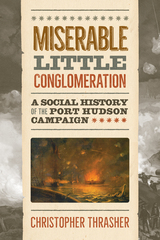 Miserable Little Conglomeration: A Social History of the Port Hudson Campaign
Christopher Thrasher
University of Tennessee Press, 2023 "The essential starting point to understand the experiences of the soldiers, enslaved people, and civilians involved in the Port Hudson campaign." —H-Net Reviews
While Vicksburg and Gettysburg tend to receive the most attention among Civil War battles, it is Port Hudson that holds the record for the longest-running siege in American history. During the summer of 1863, US soldiers fought in the infamous heat and damp of Louisiana for forty-eight grueling days, having severely underestimated the Confederates’ determination to win.
Previous accounts of these events have rested on the leaders, well-known figures, and familiar faces of the Civil War. Here, social historian Christopher Thrasher draws from a robust collection of archival sources to tell the story of the common people’s experience throughout the Port Hudson Campaign: the soldiers who fought, the civilians who persisted, and the men who persevered, for those long days.
With more than forty illustrations and maps depicting the battles of Port Hudson and the defenses of the place itself, Miserable Little Conglomeration builds upon previous scholarship to present a social history of this campaign through the eyes of the people who lived, fought, and died within it.
Filling a long-empty gap within Civil War scholarship, Thrasher’s fresh approach to the Port Hudson campaign will be of interest to Civil War scholars, students of Louisiana history, and younger learners who are interested in the voices of American history.
 Miserere Mei: The Penitential Psalms in Late Medieval and Early Modern England
Clare Costley King'oo
University of Notre Dame Press, 2012
In Miserere Mei, Clare Costley King'oo examines the critical importance of the Penitential Psalms in England between the end of the fourteenth and the beginning of the seventeenth century. During this period, the Penitential Psalms inspired an enormous amount of creative and intellectual work: in addition to being copied and illustrated in Books of Hours and other prayer books, they were expounded in commentaries, imitated in vernacular translations and paraphrases, rendered into lyric poetry, and even modified for singing. Miserere Mei explores these numerous transformations in materiality and genre. Combining the resources of close literary analysis with those of the history of the book, it reveals not only that the Penitential Psalms lay at the heart of Reformation-age debates over the nature of repentance, but also, and more significantly, that they constituted a site of theological, political, artistic, and poetic engagementacross the many polarities that are often said to separate late medieval from early modern culture.
Miserere Mei features twenty-five illustrations and provides new analyses of works based on the Penitential Psalms by several key writers of the time, including Richard Maidstone, Thomas Brampton, John Fisher, Martin Luther, Sir Thomas Wyatt, George Gascoigne, Sir John Harington, and Richard Verstegan. It will be of value to anyone interested in the interpretation, adaptation, and appropriation of biblical literature; the development of religious plurality in the West; the emergence of modernity; and the periodization of Western culture. Students and scholars in the fields of literature, religion, history, art history, and the history of material texts will find Miserere Mei particularly instructive and compelling.
"Seldom have I read a first book of such subtlety and sustained by such learning, particularly welcome for the way it so easily and gracefully crosses the artificial barriers we raise between the Middle Ages and the Renaissance. This is an original and often touching study of biblical materials that have seen a surge of interest. Those interested in the Psalms, in art history, in David, in translation, to say nothing of early modern sexuality, should rush to read it." —Anne Lake Prescott, Barnard College and Columbia University
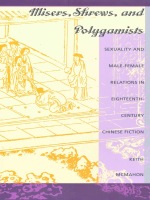 Misers, Shrews, and Polygamists: Sexuality and Male-Female Relations in Eighteenth-Century Chinese Fiction
Keith McMahon
Duke University Press, 1995 Having multiple wives was one of the mainstays of male privilege during the Ming and Qing dynasties of late imperial China. Based on a comprehensive reading of eighteenth-century Chinese novels and a theoretical approach grounded in poststructuralist, psychoanalytic, and feminist criticism, Misers, Shrews, and Polygamists examines how such privilege functions in these novels and provides the first full account of literary representations of sexuality and gender in pre-modern China.
In many examples of rare erotic fiction, and in other works as well-known as Dream of the Red Chamber, Keith McMahon identifies a sexual economy defined by the figures of the "miser" and the "shrew"—caricatures of the retentive, self-containing man and the overflowing, male-enervating woman. Among these and other characters, the author explores the issues surrounding the practice of polygamy, the logic of its overvaluation of masculinity, and the nature of sexuality generally in Chinese society. How does the man with many wives manage and justify his sexual authority? Why and how might he escape or limit this presumed authority, sometimes to the point of portraying himself as abject before the shrewish woman? How do women accommodate or coddle the man, or else oppose, undermine, or remold him? And in what sense does the man place himself lower than the spiritually and morally superior woman?
The most extensive English-language study of Chinese literature from the eighteenth century, this examination of polygamy will interest not only students of Chinese history, culture, and literature but also all those concerned with histories of gender and sexuality.
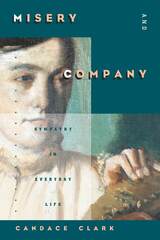 Misery and Company: Sympathy in Everyday Life
Candace Clark
University of Chicago Press, 1997 In a kind of social tour of sympathy, Candace Clark reveals that the emotional experience we call sympathy has a history, logic, and life of its own. Although sympathy may seem to be a natural, reflexive reaction, people are not born knowing when, for whom, and in what circumstances sympathy is appropriate. Rather, they learn elaborate, highly specific rules—different rules for men than for women—that guide when to feel or display sympathy, when to claim it, and how to accept it. Using extensive interviews, cultural artifacts, and "intensive eavesdropping" in public places, such as hospitals and funeral parlors, as well as analyzing charity appeals, blues lyrics, greeting cards, novels, and media reports, Clark shows that we learn culturally prescribed rules that govern our expression of sympathy.
"Clark's . . . research methods [are] inventive and her glimpses of U.S. life revealing. . . . And you have to love a social scientist so respectful of Miss Manners."—Clifford Orwin, Toronto Globe and Mail
"Clark offers a thought-provoking and quite interesting etiquette of sympathy according to which we ought to act in order to preserve the sympathy credits we can call on in time of need."—Virginia Quarterly Review
Misery Islands
January Gill O’Neil
CavanKerry Press, 2014 At the center of her second book are two islands off the coast of Salem, Massachusetts, through which O’Neil finds the rough terrain of marriage and what it means to love in the face of adversity. She navigates the waters of transition with exuberance and reflection, and discovers new ways to make the ordinary extraordinary.
Misery Prefigured
J. Allyn Rosser
Southern Illinois University Press, 2001 In her second collection of poems, J. Allyn Rosser explores the human condition in all its gloriously valiant pathos. Misery Prefigured dwells on our continual reinventions of self and world and the restless dynamic that vibrates between them.Whether contemplating a failed marriage, a visit from God, or a pearl dropped into a bottle of Prell shampoo, Rosser's wry yet impassioned eye looks hard for a habitable and abiding truth. Alternating between deadpan and dead serious, these poems are often darkly funny, exposing the contradictions inherent in every desire. Misery Prefigured is fueled by a cocky, unsentimental determination to make some consolatory sense of what passes for reality.
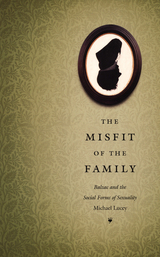 The Misfit of the Family: Balzac and the Social Forms of Sexuality
Michael Lucey
Duke University Press, 2003 In more than ninety novels and novellas, Honoré de Balzac (1799–1850) created a universe teeming with over two thousand characters. The Misfit of the Family reveals how Balzac, in imagining the dense, vividly rendered social world of his novels, used his writing as a powerful means to understand and analyze—as well as represent—a range of forms of sexuality. Moving away from the many psychoanalytic approaches to the novelist's work, Michael Lucey contends that in order to grasp the full complexity with which sexuality was understood by Balzac, it is necessary to appreciate how he conceived of its relation to family, history, economics, law, and all the many structures within which sexualities take form. The Misfit of the Family is a compelling argument that Balzac must be taken seriously as a major inventor and purveyor of new tools for analyzing connections between the sexual and the social. Lucey’s account of the novelist’s deployment of "sexual misfits" to impel a wide range of his most canonical works—Cousin Pons, Cousin Bette, Eugenie Grandet, Lost Illusions, The Girl with the Golden Eyes—demonstrates how even the flexible umbrella term "queer" barely covers the enormous diversity of erotic and social behaviors of his characters. Lucey draws on the thinking of Michel Foucault and Pierre Bourdieu and engages the work of critics of nineteenth-century French fiction, including Naomi Schor, D. A. Miller, Franco Moretti, and others. His reflections on Proust as Balzac’s most cannily attentive reader suggest how the lines of social and erotic force he locates in Balzac’s work continued to manifest themselves in twentieth-century writing and society.
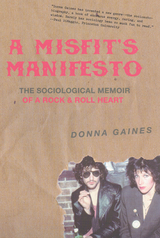 A Misfit's Manifesto: The Sociological Memoir of a Rock & Roll Heart
Gaines, Donna
Rutgers University Press, 2007 Dubbed the Margaret Mead of heavy metal, Donna Gaines is a walking, talking oxymoron, a turnpike intellectual. A Misfit's Manifesto is the story of her wild-in-the-burbs odyssey-from overweight yeshiva girl to savvy street-punk sociologist. Isolated, angry, and depressed through most of her adolescence and early adulthood, she found truth and beauty in the least likely places. Wandering the craggy terrain of Rockaway Beach, Queens, Gaines embarked upon a path to enlightenment involving sex, drugs, rock & roll, sociology, cosmetology, True Love, the occult, tattoos, science fiction, pizza, guns, comic books, and surfing-by Web and by sea. For Gaines, dignity, joy, and communion came not from family, organized religion, or mandatory schooling, but in the sound of doo-wop, surf music, acid rock, then punk, trash metal, and hardcore. "For most of my life," she writes, "music was the only way to connect that wouldn't eventually kill me." Through all the ripped nights of binge-drinking, pill-popping, and nightclubbing, Gaines became an acclaimed author, scholar, and expert on teen suicide. In an age of conformity and censorship, she defends popular culture as a powerful spiritual force-a vibrant, valid connection to God. A meditation on alienation and engagement, this memoir is an outcast's journey into the black-hole sun, where Divine love and light are found-even in Ramones songs. This edition includes a scholarly introduction that considers memoir as a sociological as well as literary genre, as a reflexive means of understanding the self in social context while nurturing a sociological imagination. Social memoir, Gaines argues, illuminates problems like alienation, marginality, addiction, and suicide, while making sociology more user-friendly and public. Now this work of dazzling originality and iconoclasm that has inspired misfits everywhere is an ideal text for classroom use, making complex social theory exciting, timely, and relevant for students.
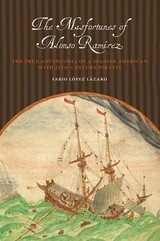 The Misfortunes of Alonso Ramírez: The True Adventures of a Spanish American with 17th-Century Pirates
By Fabio López Lázaro
University of Texas Press, 2011 In 1690, a dramatic account of piracy was published in Mexico City. The Misfortunes of Alonso Ramírez described the incredible adventures of a poor Spanish American carpenter who was taken captive by British pirates near the Philippines and forced to work for them for two years. After circumnavigating the world, he was freed and managed to return to Mexico, where the Spanish viceroy commissioned the well-known Mexican scholar Carlos de Sigüenza y Góngora to write down Ramírez's account as part of an imperial propaganda campaign against pirates. The Misfortunes of Alonso Ramírez has long been regarded as a work of fiction—in fact, as Latin America's first novel—but Fabio López Lázaro makes a convincing case that the book is a historical account of real events, albeit full of distortions and lies. Using contemporary published accounts, as well as newly discovered documents from Spanish, English, French, Portuguese, and Dutch archives, he proves that Ramírez voyaged with one of the most famous pirates of all time, William Dampier. López Lázaro's critical translation of The Misfortunes provides the only extensive Spanish eyewitness account of pirates during the period in world history (1650–1750) when they became key agents of the European powers jockeying for international political and economic dominance. An extensive introduction places The Misfortunes within the worldwide struggle that Spain, England, and Holland waged against the ambitious Louis XIV of France, which some historians consider to be the first world war.
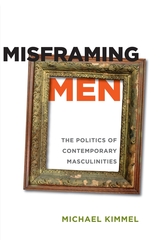 Misframing Men: The Politics of Contemporary Masculinities
Kimmel, Michael
Rutgers University Press, 2010
This past decade has witnessed an extraordinary transformation in men's lives. For years, wave after wave of the women's movement, a movement that reshaped every aspect of American life, produced nary a ripple among men. But suddenly men are in the spotlight.
Yet, the public discussions often seem strained, silly, and sometimes flat-out wrong. The spotlight itself seems to obscure as much as it illuminates. Old tired clichTs about men's resistance to romantic commitment or reluctance to be led to the marriage altar seem perennially recyclable in advice books and on TV talk shows, but these days the laughter feels more forced, the defensiveness more pronounced. Pop biologists avoid careful confrontation with serious scientific research in their quest to find anatomical or evolutionary bases for promiscuity or porn addiction, hoping that by fiat, one can pronounce that "boys will be boys" and render it more than a flaccid tautology. And political pundits wring their hands about the feminization of American manhood, as if gender equality has neutered these formerly proud studs. Misframing Men, a collection of Michael Kimmel's commentaries on contemporary debates about masculinity, argues that the media have largely misframed this debate.
Kimmel, among the world's best-known scholars in gender studies, discusses political moments such as the Virginia Military Institute and Citadel cases that reached the Supreme Court (he participated as expert witness for the Justice Department) along with Promise Keepers rallies, mythopoetic gatherings, and white supremacists. He takes on antifeminists as the real male bashers, questions the unsubstantiated assertions that men suffer from domestic violence to the same degree as women, and examines the claims made by those who want to rescue boys from the "misandrous" reforms initiated by feminism.
In writings both solidly grounded and forcefully argued, Kimmel pushes the boundaries of today's modern conversation about men and masculinity.
Mishima: A Vision of the Void
Maguerite Yourcenar
University of Chicago Press, 2001 On November 25, 1970, Japan's most renowned postwar novelist, Yukio Mishima, stunned the world by committing ritual suicide. Here, Marguerite Yourcenar, a brilliant reader of Mishima and a scholar with an eye for the cultural roles of fiction, unravels the author's life and politics: his affection for Western culture, his family and his homosexuality, his brilliant writings, and his carefully premeditated death.
Mishkan Aveilut: Where Grief Resides
Rabbi Eric Weiss
Central Conference of American Rabbis, 2019 Grief often reweaves our lives into a different way of experiencing the world. Mishkan Aveilut is designed to complement the anchors of our tradition that contain, guide, and support us as we familiarize ourselves with and move through our terrain of grief. This beautiful companion to Mishkan R'fuah: Where Healing Resides offers readings, poems, and meditations to support the emotional and spiritual needs that naturally arise at a time of loss. With opportunities for nourishment, contemplation, and emotional renewal, the collection is meant to be used as a resource for spiritual leaders and individuals alike.
Mishkan Ga'avah: Where Pride Dwells: A Celebration of LGBTQ Jewish Life and Ritual
Rabbi Denise L. Eger
Central Conference of American Rabbis, 2020 This groundbreaking collection of LGBTQ prayers, poems, liturgy, and rituals is both a spiritual resource and a celebratory affirmation of Jewish diversity. Giving voice to the private and public sectors of queer Jewish experience, Mishkan Ga'avah is also a commemoration of the fiftieth anniversary of both the Stonewall Riots and the first pride march, reflecting the longtime advocacy of the Reform Movement for full LGBTQ inclusion.
Mishkan Moeid: A Guide to the Jewish Seasons
Rabbi Peter S. Knobel, PhD
Central Conference of American Rabbis, 2013 Newly revised and updated edition of the CCAR classic Gates of the Seasons, this new volume presents a survey of the sacred days of the Jewish yearly cycle. Providing detailed guidance on observing Shabbat and the Jewish holidays, including historical background, essays, and extensive notes, Mishkan Moeid is perfect for Introduction to Judaism classes and conversion candidates, as well as personal study for those wishing to reconnect or deepen their relationship to Judaism.
Mishkan T'filah: A Reform Siddur, non-transliterated (Shabbat, Weekdays, Festivals): A Reform Siddur
Rabbi Elyse D. Frishman
Central Conference of American Rabbis, 2007 Includes services for Shabbat, weekdays, and festivals, as well as other occasions of public worship and texts for more than a hundred songs. Mishkan T'filah reflects the full diversity of our Movement.
This volume does not contain transliteration.
This Siddur includes: - Broad selection of readings, including beloved passages from our Reform liturgical tradition and great poetic writings from throughout Jewish history
- Faithful, elegant translations
- Contemporary, gender-inclusive English
- Theological and stylistic diversity
- Extensive commentaries, source notes and usage guides
- More than 100 contemporary and traditional song texts
- Innovative design in two-page spreads (additional Shabbat services in linear style also included)
- Two-color printing to enhance usability
Mishkan T'filah: A Reform Siddur, transliterated (Shabbat, Weekdays, Festivals): A Reform Siddur
Rabbi Elyse D. Frishman
Central Conference of American Rabbis, 2007 Including services for Shabbat, weekdays and festivals as well as other occasions of public worship, and texts for more than a hundred songs, Mishkan T’filah reflects the full diversity of our Movement. This new Siddur includes: • Broad selection of readings, including beloved passages from our Reform liturgical tradition and great poetic writings from throughout Jewish history • Faithful, elegant translations • Contemporary, gender-inclusive English • Theological and stylistic diversity • Extensive commentaries, source notes and usage guides • More than 100 contemporary and traditional song texts • Choice of transliterated and non-transliterated editions • Innovative design in two-page spreads (additional Shabbat services in linear style also included) • Two-color printing to enhance usability
Mishkan T'filah for the House of Mourning: A Reform Siddur
Rabbi Elaine Zecher
Central Conference of American Rabbis, 2010 An innovative approach to services in the house of mourning. Includes thoughtful readings and commentary from traditional and contemporary sources. Easy-to-transport paperback format.
Mishkan T'filah for Travelers: A Reform Siddur
Rabbi Sue Ann Wasserman
Central Conference of American Rabbis, 2009 This compact, paperback version of Mishkan T'filah integrates weekday and Shabbat services into an easily transportable volume while still remaining faithful to the style and spirit of Mishkan T'filah.
Also includes Festival liturgy.
Mishkan T'filah: Gift Edition
Elyse D. Frishman
Central Conference of American Rabbis, 2007 Including services for Shabbat, weekdays and festivals as well as other occasions of public worship, and texts for more than a hundred songs, Mishkan T’filah reflects the full diversity of our Movement. This new Siddur includes: • Broad selection of readings, including beloved passages from our Reform liturgical tradition and great poetic writings from throughout Jewish history • Faithful, elegant translations • Contemporary, gender-inclusive English • Theological and stylistic diversity • Extensive commentaries, source notes and usage guides • More than 100 contemporary and traditional song texts • Choice of transliterated and non-transliterated editions • Innovative design in two-page spreads (additional Shabbat services in linear style also included) • Two-color printing to enhance usability
Mishkan T'filah: Journal Edition: A Reform Siddur
Rabbi Joel Abraham
Central Conference of American Rabbis, 2010 Invite your students to create their own commentary, questions, poetry, and responses to the prayers in Mishkan T'filah. For b'nai mitzvah students, confirmation class, and youth groups. Some pages will have creative, challenging prompts to stimulate thoughts, and other pages will be entirely blank, allowing users space to explore and reflect. Created by Michelle Shapiro Abraham and Joel Abraham.
Note: Page numbers in this special edition are meant to be consistent with the page numbering of the standard, complete edition of Mishkan T'filah. However, because the Journal Edition does not contain some of the material from the complete edition, there are several jumps in page numbering in this edition.
Mishkan T'filah: Journal Edition, Non-transliterated: A Reform Siddur
Rabbi Joel Abraham
Central Conference of American Rabbis, 2010 Invite your students to create their own commentary, questions, poetry, and responses to the prayers in Mishkan T'filah. For b'nai mitzvah students, confirmation class, and youth groups. Some pages will have creative, challenging prompts to stimulate thoughts, and other pages will be entirely blank, allowing users space to explore and reflect. Created by Michelle Shapiro Abraham and Joel Abraham.
Note: Page numbers in this special edition are meant to be consistent with the page numbering of the standard, complete edition of Mishkan T'filah. However, because the Journal Edition does not contain some of the material from the complete edition, there are several jumps in page numbering in this edition.
Mishkan T'filah: Large Print, Shabbat: A Reform Siddur
Rabbi Elyse D. Frishman
Central Conference of American Rabbis Including services for Shabbat and texts for more than a hundred songs, Mishkan T'filah reflects the full diversity of our Movement. Available in large print for the visually impaired.
This volume is for Shabbat only, and does not include weekday and festival liturgy.
This Siddur includes: - Broad selection of readings, including beloved passages from our Reform liturgical tradition and great poetic writings from throughout Jewish history
- Faithful, elegant translations
- Contemporary, gender-inclusive English
- Theological and stylistic diversity
- Full transliteration
- Extensive commentaries, source notes and usage guides
- More than 100 contemporary and traditional song texts
- Innovative design in two-page spreads (additional Shabbat services in linear style also included)
- Two-color printing to enhance usability
Mishkan T'filah: Pulpit Edition: A Reform Siddur
Rabbi Elyse D. Frishman
Central Conference of American Rabbis, 2010 The Pulpit Edition is an oversize version of the complete edition of Mishkan T'filah, in 3-ring binder format (binder not included). It is meant for use on the bimah or for the purpose of preparing service participants.
Purchase of this volume grants the buyer the right to make copies on a one-time basis for the purpose of practice or preparation only. These pages are not to be used for the creation of new services or for publication of any kind.
Each page contains a copyright notice.
Mishkan T'filah: Shabbat, non-transliterated: A Reform Siddur
Rabbi Elyse D. Frishman
Central Conference of American Rabbis Including services for Shabbat and texts for more than a hundred songs, Mishkan T'filah reflects the full diversity of our Movement. This volume is for Shabbat only and does not include weekday and festival liturgy.
This volume does not contain transliteration.
This Siddur includes: - Broad selection of readings, including beloved passages from our Reform liturgical tradition and great poetic writings from throughout Jewish history
- Faithful, elegant translations
- Contemporary, gender-inclusive English
- Theological and stylistic diversity
- Extensive commentaries, source notes and usage guides
- More than 100 contemporary and traditional song texts
- Innovative design in two-page spreads (additional Shabbat services in linear style also included)
- Two-color printing to enhance usability
Mishkan T'filah: Shabbat, transliterated: A Reform Siddur
Rabbi Elyse D. Frishman
Central Conference of American Rabbis Including services for Shabbat and texts for more than a hundred songs, Mishkan T'filah reflects the full diversity of our Movement.
This volume is for Shabbat only and does not include weekday and festival liturgy.
This Siddur includes: - Broad selection of readings, including beloved passages from our Reform liturgical tradition and great poetic writings from throughout Jewish history
- Faithful, elegant translations
- Contemporary, gender-inclusive English
- Theological and stylistic diversity
- Full transliteration
- Extensive commentaries, source notes and usage guides
- More than 100 contemporary and traditional song texts
- Innovative design in two-page spreads (additional Shabbat services in linear style also included)
- Two-color printing to enhance usability
Mishkan T'filah: Special Large Print Edition - Three-Volume Set: A Reform Siddur
Rabbi Elyse D. Frishman
Central Conference of American Rabbis This Special Large Print edition is an oversize three volume set, created with the support of Women of Reform Judaism and in consultation with the Jewish Braille Institute. Each spiral bound volume uses specific layout and fonts meant to make the pages of Mishkan T'filah accessible to those with significant visual impairment.
Available only as a set of 3:
Volume 1 - Shabbat
Volume 2 - Weekdays and Festivals
Volume 3 - Supplementary Material (Blessings for the Home, Songs, Sources, Permissions)
Mishkan T'filah Weekdays and Festivals Large Print: A Reform Siddur
Rabbi Elyse D. Frishman
Central Conference of American Rabbis, 2007 Includes services for weekdays, festivals, and other occasions of public worship. Mishkan T'filah reflects the full diversity of our Movement, including texts for more than a hundred songs. Available in large print for the visually impaired. This volume is for weekdays and festivals only, and does not include Shabbat liturgy.
This Siddur includes: - Broad selection of readings, including beloved passages from our Reform liturgical tradition and great poetic writings from throughout Jewish history
- Faithful, elegant translations
- Contemporary, gender-inclusive English
- Theological and stylistic diversity
- Full transliteration
- Extensive commentaries, source notes and usage guides
- More than 100 contemporary and traditional song texts
- Innovative design in two-page spreads
- Two-color printing to enhance usability
Mishkan T'filah Weekdays and Festivals, Non-transliterated: A Reform Siddur
Rabbi Elyse D. Frishman
Central Conference of American Rabbis, 2007 Includes services for weekdays, festivals, and other occasions of public worship. Mishkan T'filah reflects the full diversity of our Movement, including texts for more than a hundred songs.
This volume is for weekdays and festivals only. This version does not include Shabbat liturgy or transliteration.
This Siddur does include: - Broad selection of readings, including beloved passages from our Reform liturgical tradition and great poetic writings from throughout Jewish history
- Faithful, elegant translations
- Contemporary, gender-inclusive English
- Theological and stylistic diversity
- Extensive commentaries, source notes and usage guides
- More than 100 contemporary and traditional song texts
- Innovative design in two-page spreads
- Two-color printing to enhance usability
Mishkan T'filah: Weekdays/Festivals, transliterated: A Reform Siddur
Rabbi Elyse D. Frishman
Central Conference of American Rabbis Includes services for weekdays, festivals, and other occasions of public worship. Mishkan T'filah reflects the full diversity of our Movement, including texts for more than a hundred songs.
This volume is for weekdays and festivals only and does not include Shabbat liturgy.
This Siddur includes: - Broad selection of readings, including beloved passages from our Reform liturgical tradition and great poetic writings from throughout Jewish history
- Faithful, elegant translations
- Contemporary, gender-inclusive English
- Theological and stylistic diversity
- Full transliteration
- Extensive commentaries, source notes and usage guides
- More than 100 contemporary and traditional song texts
- Innovative design in two-page spreads
- Two-color printing to enhance usability
Mishkan T'filah World Union Edition
Elyse D. Frishman
Central Conference of American Rabbis, 2010 Including services for Shabbat, weekdays and festivals as well as other occasions of public worship, and texts for more than a hundred songs, Mishkan T’filah reflects the full diversity of our Movement. This new Siddur includes: • Broad selection of readings, including beloved passages from our Reform liturgical tradition and great poetic writings from throughout Jewish history • Faithful, elegant translations • Contemporary, gender-inclusive English • Theological and stylistic diversity • Extensive commentaries, source notes and usage guides • More than 100 contemporary and traditional song texts • Choice of transliterated and non-transliterated editions • Innovative design in two-page spreads (additional Shabbat services in linear style also included) • Two-color printing to enhance usability
Mishkan T'filah: World Union Edition: A Reform Siddur
Rabbi Elyse D. Frishman
Central Conference of American Rabbis This version of Mishkan T'filah has been adapted to allow for the more traditional practices of the Progressive communities in Australia, New Zealand, and South Africa, but can readily be used in all English-speaking regions of the World Union for Progressive Judaism. Specifically, this version of Mishkan T'filah reflects a different approach to seasonal references. It includes longer versions of certain prayers in accordance with regional customs, extended annotations and page notes, a variety of new readings and prayers, as well as various new indexes to navigate the book, including an index of all the English readings by category. Even for the communities in North America, this version of Mishkan T'filah is a valuable reference and would be a welcome addition to the bookcase of every rabbi, cantor, and layperson.
The Mishnah in Contemporary Perspective, Volume 1
Alan J. Avery-Peck
SBL Press, 2016 Now in Paperback!
In the past thirty years, the Mishnah has taken its place as a principal focus in the academic study of religion and of Judaism. Many university scholars have participated in the contemporary revolution in the description, analysis, and interpretation of the Mishnah. Nearly all the publishing scholars of the academy who are now at work are represented in this project. Both essential volumes present a broad selection of approaches to the study of the Mishnah. What they prove in diverse ways is that the Mishnah defines the critical focus of the study of Judaism. It is a document that rewards study in the academic humanities.
Features:
- The best of contemporary scholarship on the Mishnah
- The most representative selection of contemporary Mishnah-study contributions available in any collection in a Western language
- Paperback format of an essential Brill reference work
The Mishnah in Contemporary Perspective, Volume 2
Alan J. Avery-Peck
SBL Press, 2016 Now in Paperback! This second volume of a two-part project on the Mishnah displays a broad selection of approaches to the study of the Mishnah in the contemporary academy. The work derives from Israel, North America, and Europe and shows the intellectual vitality of scholarship in all three centers of learning. What these articles show in diverse ways is that the Mishnah forms a critical focus of the study of Judaism. Features: - The best of contemporary scholarship on the Mishnah
- The most representative selection of contemporary Mishnah-study contributions available in any collection in a Western language
- Paperback format of an essential Brill reference work
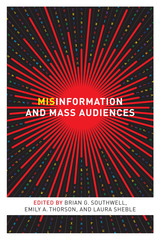 Misinformation and Mass Audiences
Edited by Brian G. Southwell, Emily A. Thorson, and Laura Sheble
University of Texas Press, 2018 Lies and inaccurate information are as old as humanity, but never before have they been so easy to spread. Each moment of every day, the Internet and broadcast media purvey misinformation, either deliberately or accidentally, to a mass audience on subjects ranging from politics to consumer goods to science and medicine, among many others. Because misinformation now has the potential to affect behavior on a massive scale, it is urgently important to understand how it works and what can be done to mitigate its harmful effects. Misinformation and Mass Audiences brings together evidence and ideas from communication research, public health, psychology, political science, environmental studies, and information science to investigate what constitutes misinformation, how it spreads, and how best to counter it. The expert contributors cover such topics as whether and to what extent audiences consciously notice misinformation, the possibilities for audience deception, the ethics of satire in journalism and public affairs programming, the diffusion of rumors, the role of Internet search behavior, and the evolving efforts to counteract misinformation, such as fact-checking programs. The first comprehensive social science volume exploring the prevalence and consequences of, and remedies for, misinformation as a mass communication phenomenon, Misinformation and Mass Audiences will be a crucial resource for students and faculty researching misinformation, policymakers grappling with questions of regulation and prevention, and anyone concerned about this troubling, yet perhaps unavoidable, dimension of current media systems.
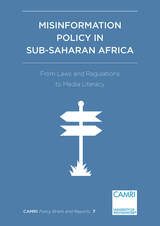 Misinformation Policy in Sub-Saharan Africa: From Laws and Regulations to Media Literacy
Peter Cunliffe-Jones, Assane Diagne, Alan Finlay, Sahite Gaye, Wallace Gichunge, Chido Onumah, Cornia Pretorius and Anya Schiffrin
University of Westminster Press, 2021 Misinformation Policy in Sub-Saharan Africa is a single volume containing two research reports by eight authors examining policy towards misinformation in Sub-Saharan Africa. The volume first examines the teaching of ‘media literacy’ in state-run schools in seven Sub-Saharan African countries as of mid-2020, as relates to misinformation. It explains the limited elements of media and information literacy (MIL) that are included in the curricula in the seven countries studied and the elements of media literacy related to misinformation taught in schools in one province of South Africa since January 2020. The authors propose six fields of knowledge and skills specific to misinformation that are required in order to reduce students’ susceptibility to false and misleading claims. Identifying obstacles to the introduction and effective teaching of misinformation literacy, the authors make five recommendations for the promotion of misinformation literacy in schools, to reduce the harm misinformation causes. The second report in the volume examines changes made to laws and regulations related to ‘false information’ in eleven countries across Sub-Saharan Africa 2016-2020 from Ethiopia to South Africa. By examining the terms of such laws against what is known of misinformation types, drivers and effects, it assesses the likely effects of punitive policies and those of more positive approaches that provide accountability in political debate by promoting access to accurate information and corrective speech. In contrast to the effects described for most recent regulations relating to misinformation, the report identifies ways in which legal and regulatory frameworks can be used to promote a healthier information environment.
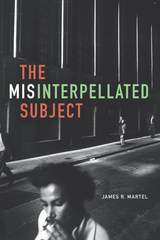 The Misinterpellated Subject
James R. Martel
Duke University Press, 2017 Although Haitian revolutionaries were not the intended audience for the Declaration of the Rights of Man, they heeded its call, demanding rights that were not meant for them. This failure of the French state to address only its desired subjects is an example of the phenomenon James R. Martel labels "misinterpellation." Complicating Althusser's famous theory, Martel explores the ways that such failures hold the potential for radical and anarchist action. In addition to the Haitian Revolution, Martel shows how the revolutionary responses by activists and anticolonial leaders to Woodrow Wilson's Fourteen Points speech and the Arab Spring sprang from misinterpellation. He also takes up misinterpellated subjects in philosophy, film, literature, and nonfiction, analyzing works by Nietzsche, Kafka, Woolf, Fanon, Ellison, Ta-Nehisi Coates, and others to demonstrate how characters who exist on the margins offer a generally unrecognized anarchist form of power and resistance. Timely and broad in scope, The Misinterpellated Subject reveals how calls by authority are inherently vulnerable to radical possibilities, thereby suggesting that all people at all times are filled with revolutionary potential.
 The Miskitu People of Awastara
By Philip A. Dennis
University of Texas Press, 2004 "Most anthropologists who have lived among other people . . . feel a periodic need to go back," writes Philip A. Dennis in the introduction to this book. "Fieldwork gives you a stake in the people themselves, a set of relationships that last the rest of your life . . . and when the time is right, it is important to go back." Dennis first journeyed to Awastara, a village on the northeastern coast of Nicaragua, during 1978-1979 as a postdoctoral student. He had come to study a culture-bound syndrome in which young women are possessed by devils. In the process, he became fascinated by other aspects of Miskitu culture—turtle fishing, Miskitu Christianity, community development efforts—the whole pattern of Miskitu community life. He also formed deep friendships to carry into the future. Twenty years later he was able to return and continue his ethnographic work. Utilizing ideas from recent interpretive anthropology and a vivid writing style, Dennis describes food habits, language, health practices, religious beliefs, and storytelling, inviting the reader to experience life in Awastara along with him. Building upon earlier work by Mary Helms, Bernard Nietschmann, Edmund Gordon, and Charles Hale, The Miskitu People of Awastara makes its own original contribution. It is the first full-length study of a coastal Miskitu community north of Puerto Cabezas, contrasting life before and after the war years of the 1980s. It will be a valuable addition to the literature on this indigenous group and should appeal to anthropologists and other social scientists, as well as all readers interested in peoples of the Caribbean coast.
Mismatch: Form-Function Incongruity and the Architecture of Grammar
Edited by Elaine J. Francis and Laura A. Michaelis
CSLI, 2002 Linguistic mismatch phenomena involve semiotic functions that attach to forms in defiance of grammatical design features. Noun phrases, when used as predicates, provide one example: how do predicate nominals correspond to our theories of what nouns mean? How do such phenomena challenge traditional conceptions of grammar? How do competing theories of the syntax-semantics interface stand up when confronted with mismatch phenomena? Mismatch addresses these questions through the efforts of some of the most original thinkers in syntactic and semantic theory, exploring a wide variety of mismatch phenomena in a broad sampling of languages.
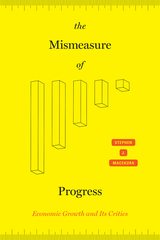 The Mismeasure of Progress: Economic Growth and Its Critics
Stephen J. Macekura
University of Chicago Press, 2020 Few ideas in the past century have had wider financial, political, and governmental impact than that of economic growth. The common belief that endless economic growth, as measured by Gross Domestic Product, is not only possible but actually essential for the flourishing of civilization remains a powerful policy goal and aspiration for many. In The Mismeasure of Progress, Stephen J. Macekura exposes a historical road not taken, illuminating the stories of the activists, intellectuals, and other leaders who long argued that GDP growth was not all it was cracked up to be.
Beginning with the rise of the growth paradigm in the 1940s and 1950s and continuing through the present day, The Mismeasure of Progress is the first book on the myriad thinkers who argued against growth and the conventional way progress had been measured and defined. For growth critics, questioning the meaning and measurement of growth was a necessary first step to creating a more just, equal, and sustainable world. These critics argued that focusing on growth alone would not resolve social, political, and environmental problems, and they put forth alternate methods for defining and measuring human progress.
In today’s global political scene—marked by vast inequalities of power and wealth and made even more fraught by a global climate emergency—the ideas presented by these earlier critics of growth resonate more loudly than ever. Economic growth appealed to many political leaders because it allowed them to avoid addressing political trade-offs and class conflict. It sustained the fiction that humans are somehow separate from nonhuman “nature,” ignoring the intimate and dense connections between the two. In order to create a truly just and equitable society, Macekura argues, we need a clear understanding of our collective needs beyond growth and more holistic definitions of progress that transcend economic metrics like GDP.
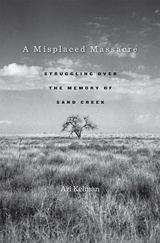 A Misplaced Massacre: Struggling over the Memory of Sand Creek
Ari Kelman
Harvard University Press, 2012 In the early morning of November 29, 1864, with the fate of the Union still uncertain, part of the First Colorado and nearly all of the Third Colorado volunteer regiments, commanded by Colonel John Chivington, surprised hundreds of Cheyenne and Arapaho people camped on the banks of Sand Creek in southeastern Colorado Territory. More than 150 Native Americans were slaughtered, the vast majority of them women, children, and the elderly, making it one of the most infamous cases of state-sponsored violence in U.S. history. A Misplaced Massacre examines the ways in which generations of Americans have struggled to come to terms with the meaning of both the attack and its aftermath, most publicly at the 2007 opening of the Sand Creek Massacre National Historic Site.
This site opened after a long and remarkably contentious planning process. Native Americans, Colorado ranchers, scholars, Park Service employees, and politicians alternately argued and allied with one another around the question of whether the nation’s crimes, as well as its achievements, should be memorialized. Ari Kelman unearths the stories of those who lived through the atrocity, as well as those who grappled with its troubling legacy, to reveal how the intertwined histories of the conquest and colonization of the American West and the U.S. Civil War left enduring national scars.
Combining painstaking research with storytelling worthy of a novel, A Misplaced Massacre probes the intersection of history and memory, laying bare the ways differing groups of Americans come to know a shared past.
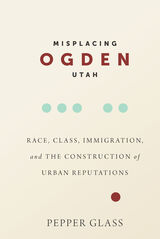 Misplacing Ogden, Utah: Race, Class, Immigration, and the Construction of Urban Reputations
Pepper Glass
University of Utah Press, 2020 How do we draw the lines between "good" and "bad" neighborhoods? How do we know “ghettos”? This book questions the widely held assumption that divisions between urban areas are reflections of varying amounts of crime, deprivation, and other social, cultural, and economic problems. Using Ogden, Utah, as a case study, Pepper Glass argues that urban reputations are “moral frontiers” that uphold and create divides between who is a good and respectable—or a bad and vilified—member of a community.
Ogden, a working-class city with a history of racial and immigrant diversity, has long held a reputation among Utahns as a “sin city” in the middle of an entrenched religious culture. Glass blends ethnographic research with historical accounts, census reports, and other secondary sources to provide insight into Ogden’s reputation, past and present. Capturing residents’ perceptions of an entire city, as opposed to only some of its neighborhoods, and exploring the regional contexts shaping these views, is rare among urban researchers. Glass’s unique approach suggests we can better confront urban problems by rethinking assumptions about place and promoting interventions that break down boundaries.
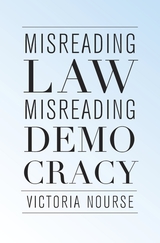 Misreading Law, Misreading Democracy
Victoria Nourse
Harvard University Press, 2016 American law schools extol democracy but teach little about its most basic institution, the Congress. Interpreting statutes is lawyers’ most basic task, but law professors rarely focus on how statutes are made. This misguided pedagogy, says Victoria Nourse, undercuts the core of legal practice. It may even threaten the continued functioning of American democracy, as contempt for the legislature becomes entrenched in legal education and judicial opinions. Misreading Law, Misreading Democracy turns a spotlight on lawyers’ and judges’ pervasive ignorance about how Congress makes law.
Victoria Nourse not only offers a critique but proposes reforming the way lawyers learn how to interpret statutes by teaching legislative process. Statutes are legislative decisions, just as judicial opinions are decisions. Her approach, legislative decision theory, reverse-engineers the legislative process to simplify the task of finding Congress’s meanings when statutes are ambiguous. This theory revolutionizes how we understand legislative history—not as an attempt to produce some vague notion of legislative intent but as a surgical strike for the best evidence of democratic context.
Countering the academic view that the legislative process is irrational and unseemly, Nourse makes a forceful argument that lawyers must be educated about the basic procedures that define how Congress operates today. Lawmaking is a sequential process with political winners and losers. If lawyers and judges do not understand this, they may well embrace the meanings of those who opposed legislation rather than those who supported it, making legislative losers into judicial winners, and standing democracy on its head.
Miss Carrie: A Novel
Judson N. Hout
Parkhurst Brothers, Inc., 2013 “Set in Arkansas during World War II, Hout’s touching story of an orphaned boy's relationship with the inhabitant of a small town's "haunted house” will keep you guessing, right up to the satisfying ending. Another endearing novel from Judson Hout." --Cindy Ward, Dallas, Texas
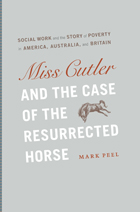 Miss Cutler and the Case of the Resurrected Horse: Social Work and the Story of Poverty in America, Australia, and Britain
Mark Peel
University of Chicago Press, 2011 Social workers produced thousands of case files about the poor during the interwar years. Analyzing almost two thousand such case files and traveling from Boston, Minneapolis, and Portland to London and Melbourne, Miss Cutler and the Case of the Resurrected Horse is a pioneering comparative study that examines how these stories of poverty were narrated and reshaped by ethnic diversity, economic crisis, and war. Probing the similarities and differences in the ways Americans, Australians, and Britons understood and responded to poverty, Mark Peel draws a picture of social work that is based in the sometimes fraught encounters between the poor and their interpreters. He uses dramatization to bring these encounters to life—joining Miss Cutler and that resurrected horse are Miss Lindstrom and the fried potatoes and Mr. O’Neil and the seductive client—and to give these people a voice. Adding new dimensions to the study of charity and social work, this book is essential to understanding and tackling poverty in the twenty-first century.
 Miss Kansas City
Joan Frank
University of Michigan Press, 2006 Miss Kansas City is the story of an improbable friendship, set in the tumultuous mid-80s dotcom California, where youthful greed and blinkered innocence arrive intertwined.
Friendless and reclusive, Alex Blue commutes two hours each way to a job that serves mainly as a place to bide time, until one day she meets the wealthy, worldly—and married—owner of a high-concept Bay Area lifestyle company. Meanwhile, the melancholy and closeted Morton Levi, yearning for a loving partner but stung by prior experience, lives a secret life outside the software information company he manages with a steady, efficient hand—the same company where Alex works.
As ominous rumors of mergers and layoffs swirl, and Alex and Mort are pushed to the emotional brink by the vagaries of love, they find themselves forging an unexpected alliance. Miss Kansas City is a moving exploration of the notion of possibility, and of a seasoned hope that can emerge on the other side of loneliness and loss.
Miss Muriel and Other Stories
Ann Petry, foreword by Jamilah Lemieux
Northwestern University Press, 2017
A young black girl watches as her aunt’s multiple suitors disrupt her family’s privacy. The same girl, now on the cusp of adulthood, shares her family’s growing fears that her father has disappeared. Acclaimed author Ann Petry penned these and the other unforgettable narratives in Miss Muriel and Other Stories more than seventy years ago, yet in them contemporary readers recognize characters who exist today and dilemmas that recur again and again: the reluctance of African Americans to seek help from the police, the rage that erupts in a black man worn down by brutality, the tyranny that the young can visit on their elders regardless of race. Originally published between 1945 and 1971, Petry’s stories capture the essence of African American experience since the 1940s.
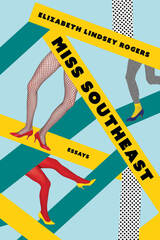 Miss Southeast: Essays
Elizabeth Lindsey Rogers
Northwestern University Press, 2024 A collection of narrative essays on femininity, sexuality, community, and belonging Miss Southeast explores the strange, often contradictory cultural circumstances of being queer and female in the American South and beyond. Born and raised in North Carolina, the youngest in a family of precocious daughters, Rogers spends her teenage years as a half-closeted lesbian desperate to escape the South, convinced the rest of the United States must be “more enlightened than our cow-dotted corner of the county.” Adulthood takes Rogers to Ohio, New York, Louisiana, Arkansas, Washington, DC, and China, but each essay finds her reckoning with participation in and resistance to rigid cultural institutions—whether a coming-out story set at a high school beauty pageant or a meditation on swimming pools as emblems of racial divides across the South. In lyric prose enlivened by a poet’s sense of musicality, Miss Southeast considers how both place and our layered identities shape our sense of belonging.
 “Miss Spain in Exile”: Isa Reyes’ Escape from the Spanish Civil War: Flamenco and Stardom in 1930s Europe
Dorian L. (Dusty) Nicol
Sussex Academic Press, 2022 On the day in 1936 that Franco invaded Spain, a fifteen-year-old girl from Madrid was on vacation in the Sierra de Gredos, a mountain range popular for hikers. Isa (Conchita) Reyes fled Spain for Paris with her mother and sister, taking only what they could carry in their suitcases. Her father stayed behind to fight on the Loyalist side. It was not long before the last piece of jewelry had been sold, and ways had to be found to make a living. Working as a model, she was discovered and given the stage name Isa.A renowned Flamenco dancer, she performed in Paris and in the capitals and resorts of Europe. In 1938 she was crowned Miss Spain in Exile.In Venice, she was courted by Count Ciano, Mussolinis son-in-law, and used an imaginative lie to avoid his affections. In Berlin, in 1939, she performed (unwillingly) at Hitlers fiftieth birthday celebrations organized by Joseph Goebbels. Later in the year, whilst on a dancing tour in Athens, she met the man she would marry—my father. Together, they escaped Europe for the New World. This is Isas story, from the nightclubs and ateliers of Paris, to the performance halls of Europe, to the harrowing inspections by the Gestapo while transiting Germany. This is a story of a young girl who had to grow up quickly when war turned her world upside down. Isa fulfilled her dream of becoming a dancer, albeit in ways she could not have imagined when growing up. Her story is told against the backdrop of the Spanish Civil War and Europes inexorable march to conflict. Isa never lost her optimism or her sense of humor. Her dream came true, but the circumstances were tragic and tumultuous.
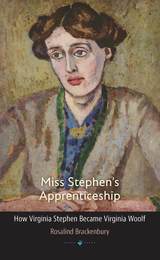 Miss Stephen's Apprenticeship: How Virginia Stephen Became Virginia Woolf
Rosalind Brackenbury
University of Iowa Press, 2018 During the years leading up to her marriage with Leonard Woolf in 1912, the year in which she finished The Voyage Out and sent it to be published by her cousin at Duckworth’s, the future Virginia Woolf was teaching herself how to be a writer. While her brothers were sent first to private schools, then to Cambridge to be educated, Virginia Stephen and her sister Vanessa were informally educated at home. With this background, how did she know she was a writer? What were her struggles? How did she teach herself? What made Miss Stephen into the author Virginia Woolf? Miss Stephen’s Apprenticeship explores these questions, delving into Virginia Woolf ’s letters and diaries, seeking to understand how she covered the distance from the wistful “I only wish I could write,” to the almost casual statement, “the novels are finished.” These days, the trajectory of a writer very often starts with studying for an MFA. In Woolf ’s case, however, it’s instructive to ask: How did a great writer, who had no formal education, invent for herself the framework she needed for a writing life? How did she know what she had to learn? How did she make her own way? Novelist Rosalind Brackenbury explores these questions and others, and in the process reveals what Virginia Woolf can give to young writers today.
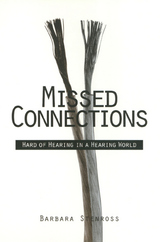 Missed Connections
Barbara Stenross
Temple University Press, 1999 "Why doesn't she just open up her ears and listen?" Few physical problems are as poorly understood as hearing loss. In Missed Connections, a new kind of self-help book that combines sociological reporting with personal reflection, sociologist Barbara Stenross examines what hearing loss feels like to those who have it and which technologies and strategies can improve communication at home and in public.
Based on seven years of research, Stenross's book tells of how -- as she sought information and solutions to help her hard-of-hearing father -- she came to join a community group called Village Self Help for Hard of Hearing People. Taking us along to group meetings and into the homes of members, Stenross shows us -- through the personal accounts of these individuals -- the exhaustion that comes from constantly straining to listen, the frustration of missing critical comments or the or the punchlines of jokes, and the pain that hard-of-hearing family members experience when loved ones accuse them of hearing "when they want to." Full of scenes, dialogues, and conversations, Missed Connections also discusses such practical issues as how people with impaired hearing can continues to use the phone, how assistive technologies can help in public and private, why hearing aids can't always do enough, and how bluffing and silence can hurt more than help. Understanding that when one family member is hard of hearing, the whole family can suffer from "missed connections," Stenross offers in this book a useful family resource with a broad range of practical guidance.
With chapters on belonging and acceptance, do's and don'ts in public, lip-reading, hearing aids, and television, Missed Connections will interest a range of readers including deaf and hard-of-hearing people -- as well as their families, teachers, friends, employers, and counselors -- healthcare professionals, scholars, and others interested in the experience of and solutions for disability and hearing loss.
 The Missile Next Door: The Minuteman in the American Heartland
Gretchen Heefner
Harvard University Press, 2012 Between 1961 and 1967 the United States Air Force buried 1,000 Minuteman Intercontinental Ballistic Missiles in pastures across the Great Plains. The Missile Next Door tells the story of how rural Americans of all political stripes were drafted to fight the Cold War by living with nuclear missiles in their backyards—and what that story tells us about enduring political divides and the persistence of defense spending.
By scattering the missiles in out-of-the-way places, the Defense Department kept the chilling calculus of Cold War nuclear strategy out of view. This subterfuge was necessary, Gretchen Heefner argues, in order for Americans to accept a costly nuclear buildup and the resulting threat of Armageddon. As for the ranchers, farmers, and other civilians in the Plains states who were first seduced by the economics of war and then forced to live in the Soviet crosshairs, their sense of citizenship was forever changed. Some were stirred to dissent. Others consented but found their proud Plains individualism giving way to a growing dependence on the military-industrial complex. Even today, some communities express reluctance to let the Minutemen go, though the Air Force no longer wants them buried in the heartland.
Complicating a red state/blue state reading of American politics, Heefner’s account helps to explain the deep distrust of government found in many western regions, and also an addiction to defense spending which, for many local economies, seems inescapable.
Missing!
Judy Soloway Kay
University of Michigan Press, 2005 When high school students in the small midwestern town of Oakton start disappearing, police are left without any clues until a psychic named Serena Sills begins working on the case. Serena and Police Chief Matt Williams combine detective work and supernatural intuition as they try to find the missing teenagers before it's too late.
The MICHIGAN Reading Plus Readers are original fiction written for students who wish to improve their reading skills. The MICHIGAN Reading Plus Readers support the need for extensive reading on topics of interest to today's students. The Readers offer students books in the genres of mystery, science-fiction, and romance. Activities that practice vocabulary and reading skills are provided on the companion website.
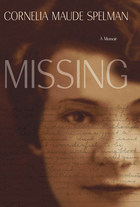 Missing: A Memoir
Cornelia Maude Spelman
Northwestern University Press, 2010 Acclaimed children’s book author Cornelia Maude Spelman’s memoir of her family springs from a meeting and subsequent friendship with the late, legendary New Yorker editor William MaxwellIn the 1920s, he and her parents had been friends as undergraduates at the University of Illinois at Urbana-Champaign. When Spelman hints at what she thinks of as the failure of her parents’ lives, he counters that “in a good novel one doesn’t look for a success story, but for a story that moves one with its human drama and richness of experience.”
At their final meeting, Maxwell encourages her to tell her mother’s story. Missing is Spelman’s response to Maxwell’s wisdom. With the pacing of the mystery novels her mother loved, and using everything from letters and interviews to the family’s quotidian paper trail—medical records, telegrams, and other oft-overlooked clues to a family’s history—Spelman reconstructs her mother’s life and untimely death. Along the way, she unravels mysteries of her family, including the fate of her long lost older brother.
Spelman skillfully draws the reader into the elation and sorrow that accompany the discovery of a family’s past. A profoundly loving yet honest elegy, Missing is, like the woman it memorializes, complex and beautiful.
 The Missing Course: Everything They Never Taught You about College Teaching
David Gooblar
Harvard University Press, 2019 “What a delight to read David Gooblar’s book on teaching and learning. He wraps important insights into a story of discovery and adventure.”
—Ken Bain, author of What the Best College Teachers Do
College is changing, but the way we train academics is not. Most professors are taught to be researchers first and teachers a distant second, even as scholars are increasingly expected to excel in the classroom. There has been a revolution in teaching and learning over the past generation, and we now have a whole new understanding of how the brain works and how students learn. The Missing Course offers a field guide to the state-of-the-art in teaching and learning and is packed with insights to help students learn in any discipline.
Wary of the folk wisdom of the faculty lounge, David Gooblar builds his lessons on the newest findings and years of experience. From active-learning strategies to ways of designing courses to get students talking, The Missing Course walks you through the fundamentals of the student-centered classroom, one in which the measure of success is not how well you lecture but how much your students actually learn.
“Warm and empirically based, comprehensive but accessible, student-centered and also scientific. We’re so lucky to have Gooblar as a guide.”
—Sarah Rose Cavanagh, author of The Spark of Learning
“Goes beyond critique, offering a series of activities, approaches, and strategies that instructors can implement. His wise and necessary book is a long defense of the idea that a university can be a site of the transformation of self and society.”
—Los Angeles Review of Books
“An invaluable source of insight and wisdom on what it means to work with students. We’ve needed this book for a long time.”
—John Warner, author of Why They Can’t Write
 The Missing Elements: A Path to Restore Chemistry's Promise
John C. Warner
Island Press, 2016 We all remember the famous tagline: better living through chemistry. But in recent years, that promise has been distorted, as serious health effects have been traced to the chemicals in everyday products. When a plastic baby bottle can interfere with brain and reproductive development, you know something is missing.
John Warner is working to fill in the pieces. Starting out as a musician, Warner never thought he would enter the sciences, let alone become a world-renowned chemist. Yet through extraordinary professional and personal experiences, he not only learned to create safe, environmentally-friendly chemicals, but discovered what was broken in the system. From an educational approach that teaches chemistry through rote instruction rather than creative exploration, to business models that short-shrift R&D, society at large is not fostering the development of benign chemicals.
The Missing Elements proposes a path forward, arguing for straightforward changes in education, business, government, philanthropy, and personal behavior that would support the universal adoption of green chemistry. The scale of reform is substantial, but so is the possibility when we restore chemistry’s promise.
The Missing Link: West European Neutrals and Regional Security
Richard E. Bissell and Curt Gasteyger, eds.
Duke University Press, 1990 The Missing Link brings together the views on the defense of the continent of the five principal neutral nations in Europe—Switzerland, Sweden, Finland, Yugoslavia, and Austria—and examines the evolution and current status of the security threats faced by them. The analyses presented here were commissioned by the Programme for Strategic and International Security Studies at the Graduate Institute of International Studies in Geneva.
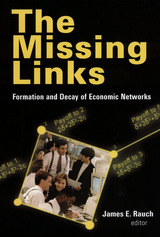 The Missing Links: Formation and Decay of Economic Networks
James E. Rauch
Russell Sage Foundation, 2007 Half of all workers are hired through personal referrals, and networks of social connections channel the flows of capital, technology, and international trade. Sociologists and economists alike recognize that economic exchange is shaped by social networks, which propagate information and facilitate trust, but each discipline brings a distinct theoretical perspective to the study of networks. Sociologists have focused on how networks shape individual behavior, economists on how individual choices shape networks. The Missing Links is a bold effort by an interdisciplinary group of scholars to synthesize sociological and economic theories of how economic networks emerge and evolve. Interweaving sophisticated theoretical models and concrete case studies, The Missing Links is both an introduction to the study of economic networks and a catalyst for further research. Economists Rachel Kranton and Deborah Minehart illustrate their field's approach to modeling network formation, showing how manufacturers form networks of suppliers in ways that maximize profits. Exemplifying the sociological approach, Ronald Burt analyzes patterns of cooperation and peer evaluations among colleagues at a financial organization. He finds that dense connections of shared acquaintances lead to more stable reputations. In the latter half of the book, contributors combine the insights of sociology and economics to explore a series of case studies. Ray Reagans, Ezra Zuckerman, and Bill McEvily investigate an R & D firm in which employees participate in overlapping collaborative teams, allowing the authors to disentangle the effects of network structure and individual human capital on team performance. Kaivan Munshi and Mark Rosenzweig examine how economic development and rising inequality in India are reshaping caste-based networks of mutual insurance and job referrals. Their study shows that people's economic decisions today are shaped both by the legacy of the caste hierarchies and by the particular incentives and constraints that each individual faces in an evolving labor market. Economic globalization is forging new connections between people in distant corners of the world, while unsettling long-standing social relations. Anyone interested in understanding the opportunities and challenges of this era of rapid change will find a highly informative guide in The Missing Links.
Missing Measures: Modern Poetry and the Revolt Against Meter
Timothy Steele
University of Arkansas Press, 1990 By the close of the nineteenth century, many poets had abandoned rhyme and meter in favor of “free verse.” Nearly one hundred years later, a growing number of younger poets are reclaiming traditional conventions of prosody by composing rhymed and measured poetry.
Missing Measures is the first full articulation of the aesthetics of this new movement. Timothy Steele, one of the best of those poets who are sometimes called the “New Formalists,” treats his subject against a backdrop of the long history of ideas about poetry, formulated first by the ancients and re-examined and re-interpreted by subsequent writers. Steele offers a new perspective on the wholesale departure from tradition proclaimed in modernist critical justifications. A rare marriage of clear writing, careful scholarship, and bold thinking, Missing Measures provides a vital new movement with a critical manifesto.
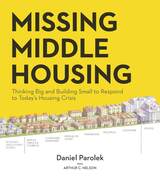 Missing Middle Housing: Thinking Big and Building Small to Respond to Today’s Housing Crisis
Daniel Parolek
Island Press, 2020 Today, there is a tremendous mismatch between the available housing stock in the US and the housing options that people want and need. The post-WWII, auto-centric, single-family-development model no longer meets the needs of residents. Urban areas in the US are experiencing dramatically shifting household and cultural demographics and a growing demand for walkable urban living.
Missing Middle Housing, a term coined by Daniel Parolek, describes the walkable, desirable, yet attainable housing that many people across the country are struggling to find. Missing Middle Housing types—such as duplexes, fourplexes, and bungalow courts—can provide options along a spectrum of affordability.
In Missing Middle Housing, Parolek, an architect and urban designer, illustrates the power of these housing types to meet today’s diverse housing needs. With the benefit of beautiful full-color graphics, Parolek goes into depth about the benefits and qualities of Missing Middle Housing. The book demonstrates why more developers should be building Missing Middle Housing and defines the barriers cities need to remove to enable it to be built. Case studies of built projects show what is possible, from the Prairie Queen Neighborhood in Omaha, Nebraska to the Sonoma Wildfire Cottages, in California. A chapter from urban scholar Arthur C. Nelson uses data analysis to highlight the urgency to deliver Missing Middle Housing.
Parolek proves that density is too blunt of an instrument to effectively regulate for twenty-first-century housing needs. Complete industries and systems will have to be rethought to help deliver the broad range of Missing Middle Housing needed to meet the demand, as this book shows. Whether you are a planner, architect, builder, or city leader, Missing Middle Housing will help you think differently about how to address housing needs for today’s communities.
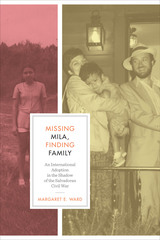 Missing Mila, Finding Family: An International Adoption in the Shadow of the Salvadoran Civil War
By Margaret E. Ward
University of Texas Press, 2011 In the spring of 1983, a North American couple who were hoping to adopt a child internationally received word that if they acted quickly, they could become the parents of a boy in an orphanage in Honduras. Layers of red tape dissolved as the American Embassy there smoothed the way for the adoption. Within a few weeks, Margaret Ward and Thomas de Witt were the parents of a toddler they named Nelson—an adorable boy whose prior life seemed as mysterious as the fact that government officials in two countries had inexplicably expedited his adoption. In Missing Mila, Finding Family, Margaret Ward tells the poignant and compelling story of this international adoption and the astonishing revelations that emerged when Nelson's birth family finally relocated him in 1997. After recounting their early years together, during which she and Tom welcomed the birth of a second son, Derek, and created a family with both boys, Ward vividly recalls the upheaval that occurred when members of Nelson's birth family contacted them and sought a reunion with the boy they knew as Roberto. She describes how their sense of family expanded to include Nelson's Central American relatives, who helped her piece together the lives of her son's birth parents and their clandestine activities as guerrillas in El Salvador's civil war. In particular, Ward develops an internal dialogue with Nelson's deceased mother Mila, an elusive figure whose life and motivations she tries to understand.
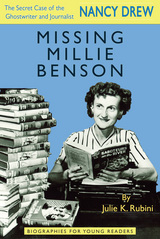 Missing Millie Benson: The Secret Case of the Nancy Drew Ghostwriter and Journalist
Julie K. Rubini
Ohio University Press, 2015 Growing up in Ladora, Iowa, Mildred “Millie” Benson had ample time to develop her imagination and sense of adventure. While still a journalism graduate student at the University of Iowa, Millie began writing for the Stratemeyer Syndicate, which published the phenomenally popular Hardy Boys series, among others. Soon, Millie was tapped for a new series starring amateur sleuth Nancy Drew, a young, independent woman not unlike Millie herself. Under the pen name Carolyn Keene, Millie wrote the first book, The Secret of the Old Clock, and twenty-two other Nancy Drew Mystery Stories. In all, Millie wrote more than a hundred novels for young people. Millie was also a journalist for the Toledo Times and the Toledo Blade. At sixty-two, she obtained her pilot’s license. Follow the clues throughout Missing Millie to discover the story of this ghostwriter, journalist, and adventurer.
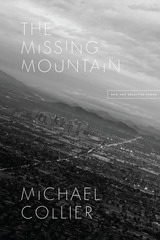 The Missing Mountain: New and Selected Poems
Michael Collier
University of Chicago Press, 2021 A collection of poetry spanning the career of distinguished poet Michael Collier.
Whether Michael Collier is writing about an airline disaster, a friendship with a disgraced Catholic bishop, his father’s encounter with Charles Lindbergh, Lebanese beekeepers, a mother’s sewing machine, or a piano in the woods, he does so with the syntactic verve, scrupulously observed detail, and a flawless ear that has made him one of America’s most distinguished poets. These poems cross expanses, connecting the fear of missing love and the bliss of holding it, the ways we speak to ourselves and language we use with others, and deep personal grief and shadows of world history.
The Missing Mountain brings together a lifetime of work, chronicling Collier’s long and distinguished career as a poet and teacher. These selections, both of previously published and new poems, chart the development of Collier’s art and the cultivations of his passions and concerns.
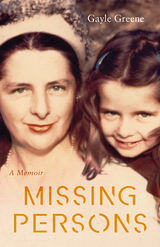 Missing Persons: A Memoir
Gayle Greene
University of Nevada Press, 2017 Missing Persons is a memoir about dealing with death in a culture that gives no help. As the last of her family, Greene’s losses are stark, first her aunt, then her mother, in quick succession. She is as ill-equipped for the challenges of caring for a dying person at home as she is for the other losses, long repressed, that rise to confront her at this time: the suicide of her younger brother, the death of her father. As the professional identity on which she’s based her selfhood comes to feel brittle and trivial, she is catapulted into questions of “who am I?” and “what have I done with my life?”
The memoir is structured as an account of her mother's and aunt’s final days and the year that follows, a year in which she reconstructs her life. This is a powerful story about family, what it means to have one, to lose one, never to have made one, and what, if anything, might take its place. It’s the story of a vexed mother-daughter relationship that mellows with age. It is also a search for home, as the very landscape shifts around her and the vast orchards are dug up and paved over for tract housing, strip malls, freeways, and the Santa Clara Valley, once known as the Valley of Heart’s Delight, is transformed to “Silicon.”
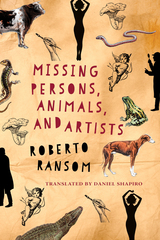 Missing Persons, Animals, and Artists
Roberto Ransom
Swan Isle Press, 2017 Elegant prose and imaginative ironies bring these compelling short stories to life in this first English-language collection from Mexican author Roberto Ransom. Each of the ten stories is filled with fascinating, yet enigmatic and sometimes elusive characters: an alligator in a bathtub, an invisible toad who appears only to a young boy, the beautiful redheaded daughter of a mushroom collector, a deceased journalist who communicates in code, and even Leonardo Da Vinci himself, meditating on The Last Supper. One of Mexico’s most original writers, Ransom explores these characters’ emotional depths as they move through their fantastical worlds that, while at times unfamiliar, offer brave and profound insights into our own.
Missing Persons, Animals, and Artists is the follow-up to Ransom’s highly acclaimed A Tale of Two Lions, praised by Ignacio Padilla as “the best Mexican literary work I have read in recent years. . . . [It] heralds a pen capable of that rarest of privileges in our letters: attaining the comic and profoundly human through a perfect simplicity.” This collection of short stories has been translated with great care by Daniel Shapiro.
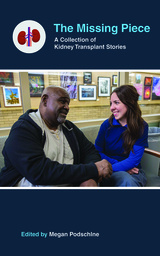 The Missing Piece: A Collection of Kidney Transplant Stories
Edited by Megan Podschlne
Michigan Publishing, 2018 The Missing Piece is a window into the world of kidney transplant recipients and donors. These powerful, first-hand accounts, written by patients at Michigan Medicine, provide frank glimpses into the highs and the lows experienced by those struggling with a life-altering illness. The contributing authors discuss the coping techniques that worked and those that did not; how they knew when it was time to consider dialysis; and, how they shared their experiences and news with family, friends, and even complete strangers in a quest for a donation from a living donor.
This uplifting book contains practical advice and a helpful list of resources for patients and family members. It is a must-read for those who are facing dialysis and/or kidney transplant and for those considering becoming a living donor.
The book’s editor has dedicated this book to new patients, understanding that patient-to-patient communication is a unique and effective way to improve patient and family education. Proceeds from this book will be used to improve the patient experience at Michigan Medicine.
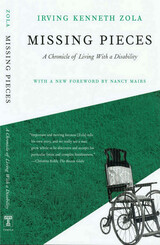 Missing Pieces: A Chronicle Of Living With A Disability
Kenneth Zola
Temple University Press, 2003 The personal odyssey of a man with a disability, this passionate book tries to tell as well as analyze what it is like to have a disability in a world that values vigor and health. Zola writes, "Missing Pieces is an unraveling of a social problem in the manner of Black Like Me. Like its author, I, too, am a trained social observer, but for me 'passing' was not an issue. For I already have the stigmata of the disabled—the braces, the limp, the cane—though I have spent much of my life denying their existence." The author started out in the role of a social scientist on a seven-day excursion to acquaint himself with an extraordinary experiment in living—Het Dorp, one of the few places in the world designed to promote "the optimum happiness" of those with severe physical disabilities. Neither a medial center nor a nursing home, Het Dorp is a village in the western-most part of the Netherlands. What began as a sociological attempt to describe this unusual setting became, through the author's growing awareness, what can only be called a socio-autobiography. Resuming his prior dependence on a wheelchair, the author experienced his own transformation from someone who is "normal" and "valid" to someone who is "invalid." The routine of Het Dorp became his: he lived in an architecturally modified home, visited the workshops, and shared meals, social events, conversation, and perceptions with the remarkably diverse residents. The author confronts some rarely discussed issues—the self-image of a person with a chronic disability, how one fills one's time, how one deals with authority and dependence, and love and sex. Missing Pieces offers striking insights into an aspect of the human condition shared by nearly 30 million Americans. It is must-read for the general reader, as well as for the rehabilitation counselor, social worker, or social scientist.
 Missing Stories
Leslie Kelen
Utah State University Press, 2000
Utah's ethnic diversity is often overlooked. In a society sometimes presumed to be homogeneous, there is a danger that the varied experiences of its members will be lost to history. Missing Stories, available here for the first time in paperback, effectively counters such misconceptions and explores the rich history of ethnic and minority groups in the state. Several representatives from each of eight such groups tell in their own voices stories of themselves, their families, and their communities. The groups represented are Utes, African-Americans, Jews, Chinese, Italians, Japanese, Greeks, and Hispanics. In a preface to each section of oral history interviews, a respected historian of the community introduces background and heritage, setting the context for the personal recollections that follow. Also included are striking photographs by Kent Miles and George Janecek that capture much of the personality and character of the interviewees.
These oral histories recount migrations to new homes in Utah or adjustment to white settlement of traditional homelands in the state. They bring to light the struggles of individuals and families to survive and the formation and maintenance of communities in frequently adverse conditions, whether on reservations or farms, in small towns or large cities. The histories are enriched by accounts of challenges met and overcome and enlivened by stories of events and persons who sometimes achieved legendary status within and outside the groups. Missing Stories reveals the many ways that ethnic and minority groups have contributed to Utah's history and fills in missing pieces necessary to a complete portrayal of the state's society and culture.
Missing Words: The Family Handbook on Adult Hearing Loss
Kay Thomsett
Gallaudet University Press, 1993 Written by Eve Nickerson, who is deaf, and her daughter Kay Thomsett, Missing Words lays out the practical steps families can take to adjust to a loved one’s hearing loss. This excellent guidebook shows how the exchange of information can be altered at fundamental levels, what these alterations entail, and how they can affect one’s ability to understand and interpret spoken communication. Along with the hands-on tips provided throughout, this handbook considers the potential of cochlear implants, described both by audiologist Holden and by Nickerson, who underwent implant surgery in 1985. For all families coping with a loved one’s hearing loss, Missing Words is the outstanding single resource upon which they can rely.
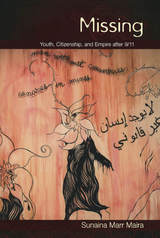 Missing: Youth, Citizenship, and Empire after 9/11
Sunaina Marr Maira
Duke University Press, 2009 In Missing, Sunaina Marr Maira explores how young South Asian Muslim immigrants living in the United States experienced and understood national belonging (or exclusion) at a particular moment in the history of U.S. imperialism: in the years immediately following September 11, 2001. Drawing on ethnographic research in a New England high school, Maira investigates the cultural dimensions of citizenship for South Asian Muslim students and their relationship to the state in the everyday contexts of education, labor, leisure, dissent, betrayal, and loss. The narratives of the mostly working-class youth she focuses on demonstrate how cultural citizenship is produced in school, at home, at work, and in popular culture. Maira examines how young South Asian Muslims made sense of the political and historical forces shaping their lives and developed their own forms of political critique and modes of dissent, which she links both to their experiences following September 11, 2001, and to a longer history of regimes of surveillance and repression in the United States. Bringing grounded ethnographic analysis to the critique of U.S. empire, Maira teases out the ways that imperial power affects the everyday lives of young immigrants in the United States. She illuminates the paradoxes of national belonging, exclusion, alienation, and political expression facing a generation of Muslim youth coming of age at this particular moment. She also sheds new light on larger questions about civil rights, globalization, and U.S. foreign policy. Maira demonstrates that a particular subjectivity, the “imperial feeling” of the present historical moment, is linked not just to issues of war and terrorism but also to migration and work, popular culture and global media, family and belonging.
 Mission Accomplished: On Founding Constitutional Adjudication in Central Europe
Radoslav Procházka
Central European University Press, 2002 Examines constitutional jurisdiction in the so-called Visegrad Four: Poland, Hungary, the Czech Republic and Slovakia. The creation of constitutional courts was one of the major milestones in the re-creation of the democratic system in these countries. In Europe constitutional courts exert much of the functions of the Supreme Court of the US. However, the immediate western European samples showed marked differences, which is why besides similarities, the theory and practice of constitutional law show differences in these four countries. Procházka analyses and explains these similarities and differences.
Mission Accomplished contributes to the literature on comparative constitutional law by offering insights into the constitutional discourses that go beyond the discussion of notorious cases and events in these four countries. Procházka argues that the various historical, cultural, socio-psychological, political and institutional contexts have translated into different modes of constitutional adjudication and interpretation.
 Mission and Margin: A Practical Guide to University Finances
Daniel Diermeier and Brett C. Sweet
University of Chicago Press, 2025 An insider’s guide to university finances, for non-insiders. The finances of higher education have never been more challenging. From two-year institutions to the Ivy Leagues, from department chairs to provosts, administrators face revenue shortfalls and financial insecurity. A fundamental understanding of financial management is more essential than ever for university leaders at every level—as is a true partnership between academic leaders and their CFOs. In Margin and Mission, Daniel Diermeier and Brett Sweet distill the principles for successful financial management in higher education, based on their work together at Vanderbilt University. Their concise, practical guide develops the reader’s understanding step-by-logical-step with the help of real-world examples. Margin and Mission aims to give university leaders, from board members to department chairs, the knowledge to make sound economic decisions that preserve their institutions’ purpose—even in the face of uncertainty.
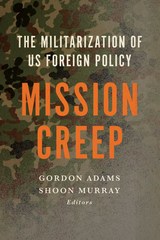 Mission Creep: The Militarization of US Foreign Policy?
Gordon Adams and Shoon Murray, Editors
Georgetown University Press, 2014 Mission Creep: The Militarization of US Foreign Policy? examines the question of whether the US Department of Defense (DOD) has assumed too large a role in influencing and implementing US foreign policy. After the Cold War, and accelerating after September 11, the United States has drawn upon the enormous resources of DOD in adjusting to the new global environment and challenges arising from terrorism, Islamic radicalism, insurgencies, ethnic conflicts, and failed states. Contributors investigate and provide different perspectives on the extent to which military leaders and DOD have increased their influence and involvement in areas such as foreign aid, development, diplomacy, policy debates, and covert operations. These developments are set in historical and institutional context, as contributors explore the various causes for this institutional imbalance. The book concludes that there has been a militarization of US foreign policy while it explores the institutional and political causes and their implications. “Militarization” as it is used in this book does not mean that generals directly challenge civilian control over policy; rather it entails a subtle phenomenon wherein the military increasingly becomes the primary actor and face of US policy abroad. Mission Creep’s assessment and policy recommendations about how to rebalance the role of civilian agencies in foreign policy decision making and implementation will interest scholars and students of US foreign policy, defense policy, and security studies, as well as policy practitioners interested in the limits and extents of militarization.
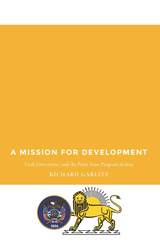 A Mission for Development: Utah Universities and the Point Four Program in Iran
Richard Garlitz
Utah State University Press, 2018 A Mission for Development tells the remarkable story of faculty from three Utah universities who lived and worked in Iran as part of the Point Four Program. Using the experience of these advisors, the book reexamines the rise and fall of the US-Iranian alliance and explores the roles that American universities played in international development during the Cold War.
The Point Four Program sponsored American technical assistance for developing countries during the 1950s—an American Cold War strategy to cultivate friendly governments and economic development in countries purportedly susceptible to Communist influence. Between 1951 and 1964, advisors from Brigham Young University sought to modernize Iranian public education, experts from Utah State University worked to improve agricultural production, and doctors and nurses from the University of Utah helped with the Iranian government’s rural health initiatives. In A Mission for Development, author Richard Garlitz offers a critical and clear-eyed assessment of the challenges the Utahns faced and the contributions they made to Iranian development.
The book also reexamines the Iranian political crisis of the early 1950s and the overthrow of Prime Minister Mohammad Mossadegh through the eyes of the Utah advisors. A Mission for Development provides rare insight into the university role in international development and will be of interest to historians and policy makers.
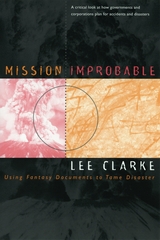 Mission Improbable: Using Fantasy Documents to Tame Disaster
Lee Clarke
University of Chicago Press, 1999 How does the government or a business plan for an unimaginable disaster-a meltdown at a nuclear power plant, a gigantic oil spill, or a nuclear attack? Lee Clarke examines actual attempts to "prepare" for these catastrophes and finds that the policies adopted by corporations and government agencies are fundamentally rhetorical: the plans have no chance to succeed, yet they serve both the organizations and the public as symbols of control, order, and stability. These "fantasy documents" attempt to inspire confidence in organizations, but for Clarke they are disturbing persuasions, soothing our perception that we ultimately cannot control our own technological advances.
For example, Clarke studies corporations' plans for cleaning up oil spills in Prince William Sound prior to the Exxon Valdez debacle, and he finds that the accepted strategies were not just unrealistic but completely untenable. Although different organizations were required to have a cleanup plan for huge spills in the sound, a really massive spill was unprecedented, and the accepted policy was little more than a patchwork of guesses based on (mostly unsuccessful) cleanups after smaller accidents.
While we are increasingly skeptical of big organizations, we still have no choice but to depend on them for protection from large-scale disasters. We expect their specialists to tell the truth, and yet, as Clarke points out, reassuring rhetoric (under the guise of expert prediction) may have no basis in fact or truth because no such basis is attainable.
In uncovering the dangers of planning when implementation is a fantasy, Clarke concludes that society would be safer, smarter, and fairer if organizations could admit their limitations.
"An incursion into new territory written with insight and flair, Clarke's book achieves a revolution in understanding plans as an organizational activity-how they come about, why they go awry, and the often-disastrous disconnect between plans and an organization's ability to carry them out. A book that will fascinate general readers, administrators, organization theorists, and disaster buffs, Mission Improbable stands as a valuable companion volume to Pressman and Wildavsky's Implementation."—Diane Vaughan, author of The Challenger Launch Decision
 Mission in the Marianas: An Account of Father Diego Luis de Sanvitores and His Companions, 1669-1670
Ward Barrett
University of Minnesota Press, 1975 Mission in the Marianas was first published in 1975. Minnesota Archive Editions uses digital technology to make long-unavailable books once again accessible, and are published unaltered from the original University of Minnesota Press editions.The source of this translation is a pamphlet published in Madrid in about 1671 about the culture of the people of the Marianas Islands and a report of the second year of the Jesuit mission there. It was compiled by Jesuit Andrés de Ledesma from letters written by Father Diego Luis de Sanvítores and his companions at the mission. As Professor Barrett writes in his commentary: “Its pages ring and echo with the rhetoric of the missionaries who with single-minded devotion both followed and preceded the sword in the Spanish Empire. It was the fervid zeal of Diego Luis de Sanvítores that altered so greatly the lives of the people of the Marianas and led to his celebrated martyrdom there in 1672.” This is a publication from the James Ford Bell Library of the University of Minnesota.
Mission of Change in Southwest Alaska: Conversations with Father René Astruc and Paul Dixon on Their Work with Yup’ik People
Edited by Ann Fienup-Riordan
University of Alaska Press, 2012 Mission of Change is an oral history describing various types of change—political, social, cultural, and religious—as seen through the eyes of Father Astruc and Paul Dixon, non-Natives who dedicated their lives to working with the Yup’ik people. Their stories are framed by the an analytic history of regional changes, together with current anthropological theory on the nature of cultural change and the formation of cultural identity. The book presents a subtle and emotionally moving account of the region and the roles of two men, both of whom view issues from a Catholic perspective yet are closely attuned to and involved with changes in the Yup’ik community.
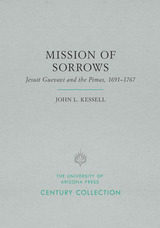 Mission of Sorrows: Jesuit Guevavi and the Pimas, 1691–1767
John L. Kessell; Foreword by Ernest J. Burrus, S.J.
University of Arizona Press, 1970 The Mission of Guevavi on the Santa Cruz River in what is now southern Arizona served as a focal point of Jesuit missionary endeavor among the Pima Indians on New Spain's far northwestern frontier.
For three-quarters of a century, from the first visit by the renowned Eusebio Francisco Kino in 1691 until the Jesuit Expulsion in 1767, the difficult process of replacing one culture with another—the heart of the Spanish mission system—went on at Guevavi. Yet all but the initial years presided over by Father Kino have been forgotten.
Drawing upon archival materials in Mexico, Spain, and the United States—including accounts by the missionaries themselves and the surviving pages of the Guevavi record books—Kessell brings to life those forgotten years and forgotten men who struggled to transform a native ranchería into an ordered mission community.
Of the eleven Black Robes who resided at Guevavi between 1701 and 1767, only a few are well known to history. Others—such as Joseph Garrucho, who presided more years at Guevavi than any other Padre; Alexandro Rapicani, son of a favorite of Sweden's Queen Christina; Custodio Zimeno, Guevavi's last Jesuit—have the details of their roles filled in here for the first time.
In this in-depth study of a single missionary center, Kessell describes in detail the daily round of the Padres in their activities as missionaries, educators, governors, and intercessors among the often-indifferent and occassionally hostile Pimas. He discusses the Pima uprising of 1751 and the events that led up to it, concluding that it actually continued sporadically for some ten years.
The growing ferocity of the Apache, the disastrous results of certain government policies—especially the removal of the Sobaípuri Indians from the San Pedro Valley—and the declining native population due to a combination of enforced culture change and epidemics of European diseases are also carefully explored.
The story of Guevavi is one of continuing adversity and triumph. It is the story, finally, of explusion for the Jesuits and, a few short years later, the end of Mission Guevavi at the hands of the Apaches.
In Mission of Sorrows Kessell has projected meticulous research into a highly readable narrative to produce an important contribution to the history of the Spanish Borderlands.
|
|

